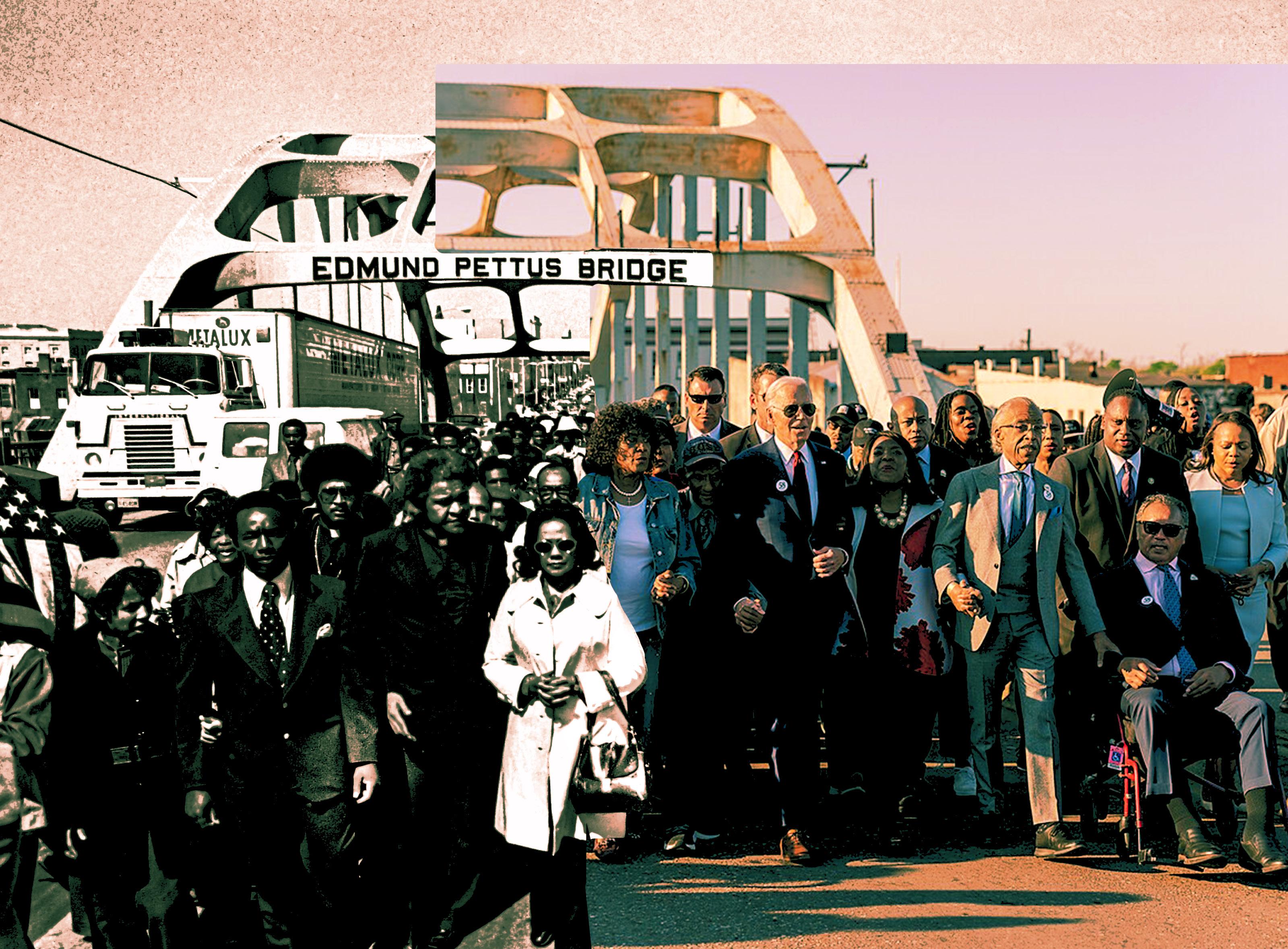

THE UNFINISHED MARCH
USPS 382-600/ISSN#00287121
2340 Frederick Douglass Boulevard
New York, New York 10027
(212) 932-7400 / FAX (212) 222-3842
DIRECTORY
EDITORIAL
Executive & Investigative Editor – Damaso Reyes Damaso.Reyes@AmsterdamNews.com
Managing Editor – Kristin Fayne-Mulroy KFM@AmsterdamNews.com
Digital Editor - Josh Barker
Josh.Barker@AmsterdamNews.com
STAFF WRITERS
Karen Juanita Carrillo
Karen.Carrillo@AmsterdamNews.com
Shannon Chaffers
Shannon.Chaffers@amsterdamnews.com
Ariama C. Long Ariama.Long@AmsterdamNews.com
Tandy Lau Tandy.Lau@AmsterdamNews.com
DIGITAL, BRANDED CONTENT & HYBRID ADVERTISING MANAGER
Ali Milliner (347) 350-4316
Ali.Milliner@AmsterdamNews.com
DISPLAY & DIGITAL ADVERTISING CONSULTANT
William “Bill” Atkins (212) 932-7429
William.Atkins@AmsterdamNews.com
LEGAL, LLC & CLASSIFED ADVERTISING
Ali Milliner (347) 350-4316
Ali.Milliner@AmsterdamNews.com
CIRCULATION / SUBSCRIPTION
Benita Darby (212) 932-7453
Benita.Darby@AmsterdamNews.com
The AmsterdamNewsassumes no responsibility for the return of unsolicited manuscripts or photographs. Photographs and manuscripts become the property of The Amsterdam News. Published weekly. Periodicals Class postage paid at New York, N.Y. POSTMASTER: Send address corrections to NYAmsterdamNews,2340 Frederick Douglass Blvd., New York, NY 10027.
One45 project advances with final NYC council vote
By ARIAMA C. LONG Amsterdam News Staff
The New York City Council unanimously approved the long-debated One45 mixeduse development project in Harlem in a final vote this week.
“I entered office with a vision to empower my community while providing equity and inclusion. My mandate is to prioritize the approval of developments that include affordability for our current residents and to provide opportunity and empowerment and advancement for them as well,” said Councilmember Yusef Salaam at the meeting on Monday, July 14.
The One45 project is a three-building complex on West 145th Street in Salaam’s district. It includes approximately 1,000 housing units, with 90 units of senior housing and 338 affordable units. The project has several community benefits, such as renovation of a neighboring playground, a new technology center, commercial and retail space set aside for local businesses, and paid internships for local youth.
Before the final vote on Monday, the City Council modified the development proposal to require a Mandatory Inclu -
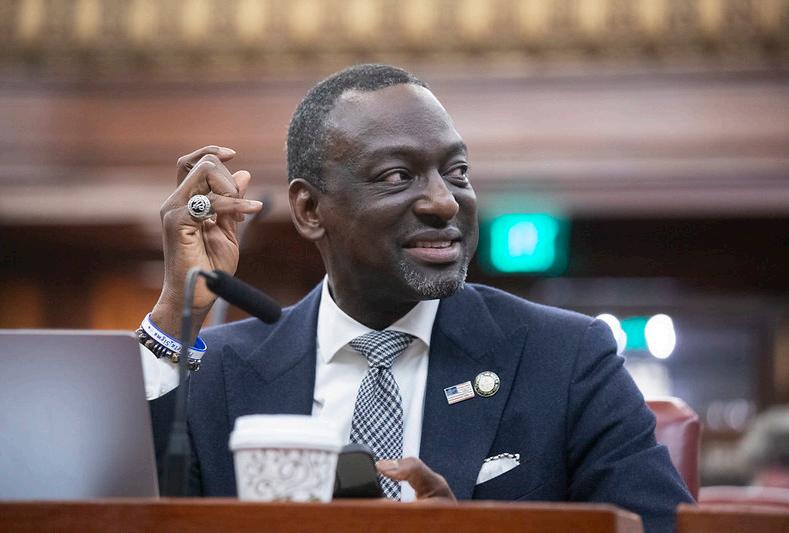
sionary Housing (MIH) Option 1 at one of the three buildings, which means residents at 60% or lower of the Area Median Income (AMI), and to reflect revised building heights and programs, said City Council Speaker Adrienne Adams.
“We went back to the table again and
again until we got a deal that reflects the values and the needs of Harlem,” said Salaam.
Since the project promises more than 350 local construction jobs and 20% local hiring, as well as 20% commercial
Madison J. Gray selected as new AmNews executive editor
By AMNEWS STAFF
As the Amsterdam News continues to build on its recent successes, the 116-yearold newspaper has announced that Madison J. Gray has been hired as the new executive editor, taking the baton from Damaso Reyes.
“We are so excited to welcome Madison to the Amsterdam News Family and add him to the illustrious list of talented editors that have come before him. We look forward to working with him to reach even higher heights of editorial excellence,” said AmNews Publisher and Editor-inChief Elinor Tatum.
same time, he wants to offer even better coverage for readers who have been loyal for generations.
A native of Detroit who has lived in New York for 25 years, Gray is an award-winning media veteran who previously served as a senior editor at BET Digital, digital managing editor at Ebony.com and front door editor for CBSNews.com. He is an accomplished journalist with nearly 30 years of experience reporting from around the United States and West Africa.
MAIL SUBSCRIPTIONS INFORMATION
“It’s an honor to be a part of the century-long legacy of the New York Amsterdam News ,” said Gray. “We’re at a critical time in the news business, particularly when it comes to the Black press. So I’m excited about joining this multi-talented team as it continues to make a difference in the community.”
Gray is hoping to expand the AmNews digital presence, reaching new audiences and growing the organization’s influence in today’s challenging marketplace. At the
Gray has been a fellow at the Poynter Institute and the Knight Digital Media Center at the UC Berkeley Graduate School of Journalism. He has also served as parliamentarian for the New York Association of Black Journalists and Detroit NABJ. He is also a proud member of the Brooklyn Alumni Chapter of Phi Beta Sigma Fraternity Inc.
“I am excited for Madison to join the AmNews team. He brings the experience and energy we need to grow and better serve our audience,” said AmNews Executive and Investigative Editor Damaso Reyes. A longtime contributor to the newspaper and founder of its Blacklight
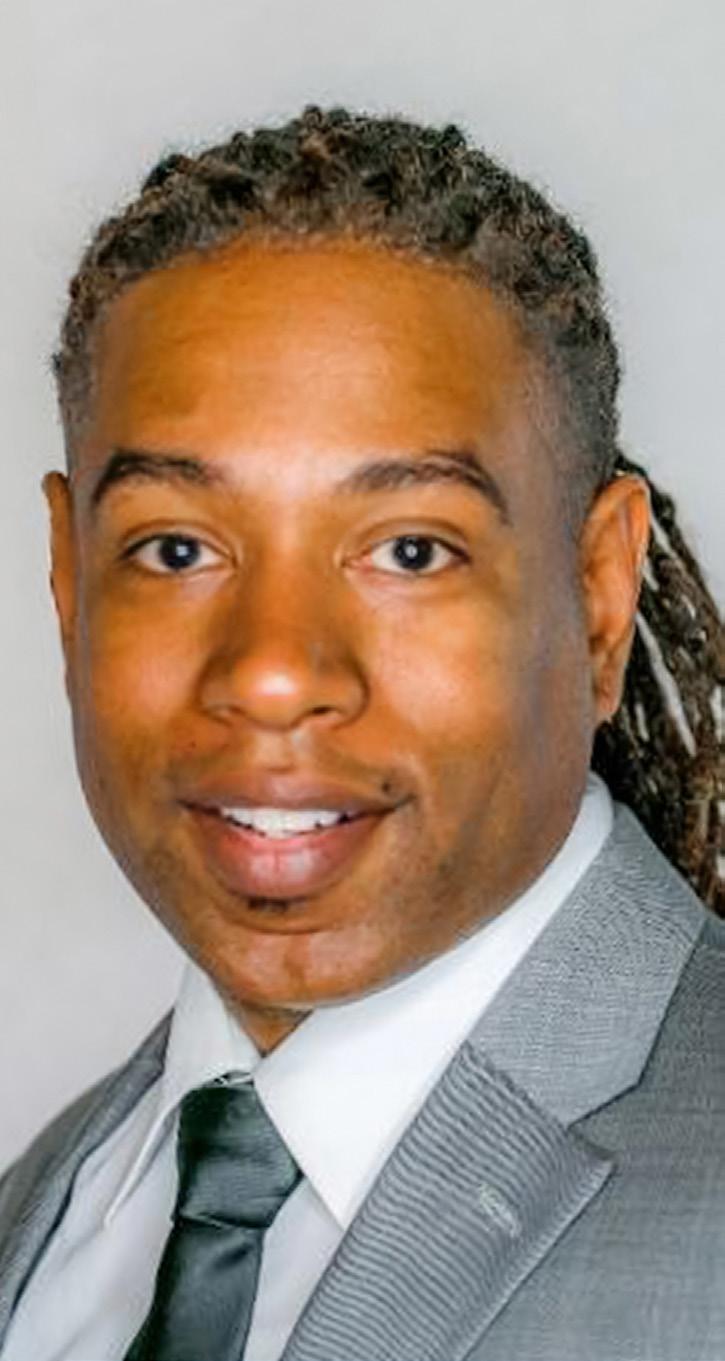
See ONE45 page 35
The New York City Council holds stated meeting July 14, 2025. (John McCarten/NYC Council Media Unit photo)
Madison J. Gray (Contributed photo)
The Big Beautiful Bill and its effects on college students
By JADEN DEGRUY Special to the AmNews
President Donald Trump’s second term in office has been nothing short of tumultuous. Since January, Trump has already issued a litany of executive orders and used military force to legitimize his power, among other measures, to demonstrate his authority to the country. He’s still not done, though.
On Friday, July 4, President Donald Trump signed the One Big Beautiful Bill Act into law. A highly controversial bill, it seeks to make significant changes, including to taxes, health care, and federal funding. These changes will affect those not from wealthier backgrounds. Low-income communities will be severely hampered by cuts to programs such as Medicaid, which provides health care services to families with not enough money; and SNAP, which provides food stamps to people who cannot afford their groceries.
One group that is poised to be significantly affected is college students. Moreover, a lot of what’s written in this bill will take effect in a year or two, thus putting people’s futures at risk.
“That’s what I’m more worried about personally,” said Derrick Barnes, a 19-year-old rising junior attending American University. “I do have the intention of seeking higher education for a master’s in public policy in law school, but I’m worried that the cost of tuition won’t become any cheaper.” Grad-
uate school is not cheap, costing hundreds of thousands for a two-year program. To alleviate those costs, loans are a method of paying off a portion of tuition.
However, the bill introduces strict borrowing caps: $100,000 for regular graduate school and $200,000 for law and medical school. Caps this low may lead many students to reconsider their plans, ultimately making it more difficult to pay off tuition.
“Prices for medical school are already outrageous,” says Margeaux Morial, a 19-yearold rising sophomore attending Howard University. “People go into so much debt because of it, and unfortunately, when you get out, you don’t get paid that much as a [resident doctor]. Like, you’re working crazy hours, you don’t get paid much, and you struggle to pay that debt back.”
The bill also impacts other facets of people’s lives aside from the finances of college tuition, because it targets health care services. Cuts to Medicaid and Medicare programs will severely cripple families who are seeking medical care due to stricter re-enrolment policies and work qualifications. With these changes, it could potentially make it more difficult for people to find services in mental health as the government is cutting billions in funding.
“It will impact psychology as a field, like therapy or being a counselor, maybe even research,” said Nathaniel Ellis, a 19-yearold rising sophomore attending Temple University. A psychology major, Ellis hopes
to work in the field by the time he’s finished with school. However, cuts to Medicaid and Medicare make it hard for people to even afford therapeutic services. As a consequence, there will be less of a demand for therapists due to a lack of affordability.
“People rely on Medicaid for therapy,” Ellis said. “So like, that is going to hurt the field, and it’s going to hurt patients who need therapy, who need support.”
Climate action also takes a hit because clean energy initiatives are stripped of tax incentives in the bill. As a result, clean energy sources like electric power become more expensive, and climate programs may be less effective. Niyea Pollard-Calliste, a 19-year-old rising sophomore at UMass Lowell majoring in environmental science, says the bill’s restrictions on climate action make her future career path more difficult.
“If we’re increasing pollution and increasing fossil fuel emissions, what do we do?” said Pollard-Calliste. “What’s the point of me being an environmental scientist and trying to help and combat what’s going on if all our efforts are not [taken seriously]?”
With the bill proving to more negatively affect certain areas in the country, some students are finding ways to use it as motivation for change.
“I want to get into politics and just things like this motivate me more,” Barnes said. “It just motivates me to be the change that I want to see. And even as a registered Democrat, people on that side aren’t pushing to

make the changes that I want to see. So my mentality is, ‘If no one’s going to do it for me, I need to do it for myself.’”
“Well you know, it just shows how much work needs to be done,” said Atticus D’Alessandro, a 19-year-old rising sophomore at George Washington University.
As a political science major, D’Alessandro feels that he must do anything he can to reverse the changes being made. “This is part of the reason I chose to major in political science — it just feels right to be involved somehow. I’m not saying that I’m going to be the next president, but, you know, everyone has a part to play. So if mine, no matter how big or small there is to be done, I’ll do it.”
National Urban League says Black America is in a ‘state of emergency’
By KAREN JUANITA CARRILLO Amsterdam News Staff
“Democracy is under siege,” National Urban League (NUL) President Marc Morial warned at a recent press conference. “What began as what we thought were fringe attacks on racial equity has now become national policy.
“We are in a state of emergency, and the National Urban League has a fundamental obligation to stand up for democracy, to stand up for diversity, and stand up for economic policies that defeat poverty.”
Morial called the press conference to announce the publication of “State of Emergency: Democracy, Civil Rights, and Progress Under Attack,” the NUL’s 49th annual State of Black America report. NUL is one of the oldest organizations in the country advocating for economic and social justice, and in this new report, it is declaring that Black America is facing great danger.
“Our report this year is a warning and rallying cry as civil rights protections are being unraveled,” said Morial: “Democracy is under siege.”

es and educational institutions fear penalties if they implement progressive policies supporting civil rights, especially for Black Americans.
The advocacy organization states that it has been organizing and working with a multiracial group of civic, social justice, and civil rights leaders to promote a more just America and defend democracy: “Essentially, we use this year’s report to call out the state of emergency and to add specifics around it. And we use this report as a call to action for people to stand up, whether through protests, litigation, political advocacy, community advocacy, selective purchasing, or whatever tactic people use. We want to stand up for American democracy. We want to stand up for equal opportunity and diversity, equity, and inclusion. We want to stand up for economic policies that have as a goal not poverty, but prosperity for all Americans.”
Calling the present status a “state of emergency” is not mere rhetoric, NUL contends.
NUL points to right-wing efforts to demonize terms like “woke” and phrases
The Donald Trump administration efforts are the culmination of years of efforts to weaken the Voting Rights Act, the 2023 Supreme Court ruling that ended race-conscious affirmative action in college admissions, the dismantling and privatization of government agencies, and the current president’s push for his “One Big Beautiful Bill,” which proposes permanent tax cuts for the wealthy and corporations.
such as “diversity, equity, and inclusion.” It notes that far-right ideologues have helped undermine equality initiatives across the nation. It also observes that several states have enacted laws allowing voter suppression, federal agencies meant to protect civil rights are being weakened, and business-
“The notion that we are living through a ‘state of emergency’ is not rhetorical flourish,” Morial said. “It is an honest reckoning with a government increasingly determined to sacrifice its founding principles — equality, liberty, and justice — rather than accept the truth of a diversifying nation and deliver equitable opportunity to all.”
(Photo by Abdulkadir muhammad sani)
“Democracy is under siege,” National Urban League (NUL) President Marc Morial warns. NUL says that it has been organizing and working with a multiracial group of civic, social justice, and civil rights leaders to advocate for a more just America and defend democracy.
(Karen Juanita Carrillo photo)
November showdown looms for Staten Island’s North Shore council seat
By ARIAMA C. LONG Amsterdam News Staff
Incumbent Councilmember Kamillah M. Hanks won the Democratic primary in June for Staten Island’s (SI) North Shore, but she still has competition for her seat coming up this November.
“I have every confidence that I’ll be victorious in November,” said Hanks. “I am perplexed about what it might mean in the long term since I have an Independent and Republican challenger.”
North Shore (District 49) has been Blackled since 2010 when former Councilmember Debi Rose, the first Black person to hold higher office on SI, was elected to represent the primarily Democratic district. Hanks follows in her footsteps and continues to be the only Black councilmember on SI.
Hanks, who grew up in Park Hill, is the founder and president of the Historic Tappen Park Community Partnership and served on the city’s Panel for Education Policy (PEP) prior to getting elected in 2021. She is a mother of four and grandmother of five. Her district covers neighborhoods like St. George, New Brighton, Tompkinsville, Stapleton, Rosebank, Park Hill, West Brighton, Westerleigh, Port Richmond, Arlington, Graniteville, and Snug Harbor on SI.
Leading up to this June’s Democratic primary, Hanks faced quite a few challengers including district leader Abou S. Diakhate, organizer Sarah Blas, and Telee N. Brown.
On Election Night, June 24, Hanks earned 58.46% or 6,706 of the votes at the close of the polls, according to the New York City Board of Elections (BOE). A bittersweet moment considering, Hanks’ mother had passed just before the primary, she said. After ranked choice voting rounds were tabulated, Hanks’ lead margin dropped minutely to 58.1% or 7,174 votes but still secured her place as the nominee.
“I represent Black and immigrant homeowners. Public housing and renters. Teachers, firefighters, cops, and union workers. I represent a diverse district, socially, economically, religiously, generationally. I am a reflection of my district. And having to balance that. Having people vote for me is humbling and a testament. No glitz. No glamor,” said Hanks. “Our strategy is to keep our heads down and do the work.”
Hanks said she has no ill-will toward Blas, since they’ve known one another for years, but she is a little concerned that her independent candidacy could split the vote in the general election. She also pushed back against “labels” like conservative or “establishment” Democrat, and said that she’s leaning on her voting record during her time on the council and her reputation of working across the aisle to get things done for the North Shore.
“Potholes don’t have political parties,” she said.
In terms of fundraising, Hanks has far
See STATEN ISLAND on page 31
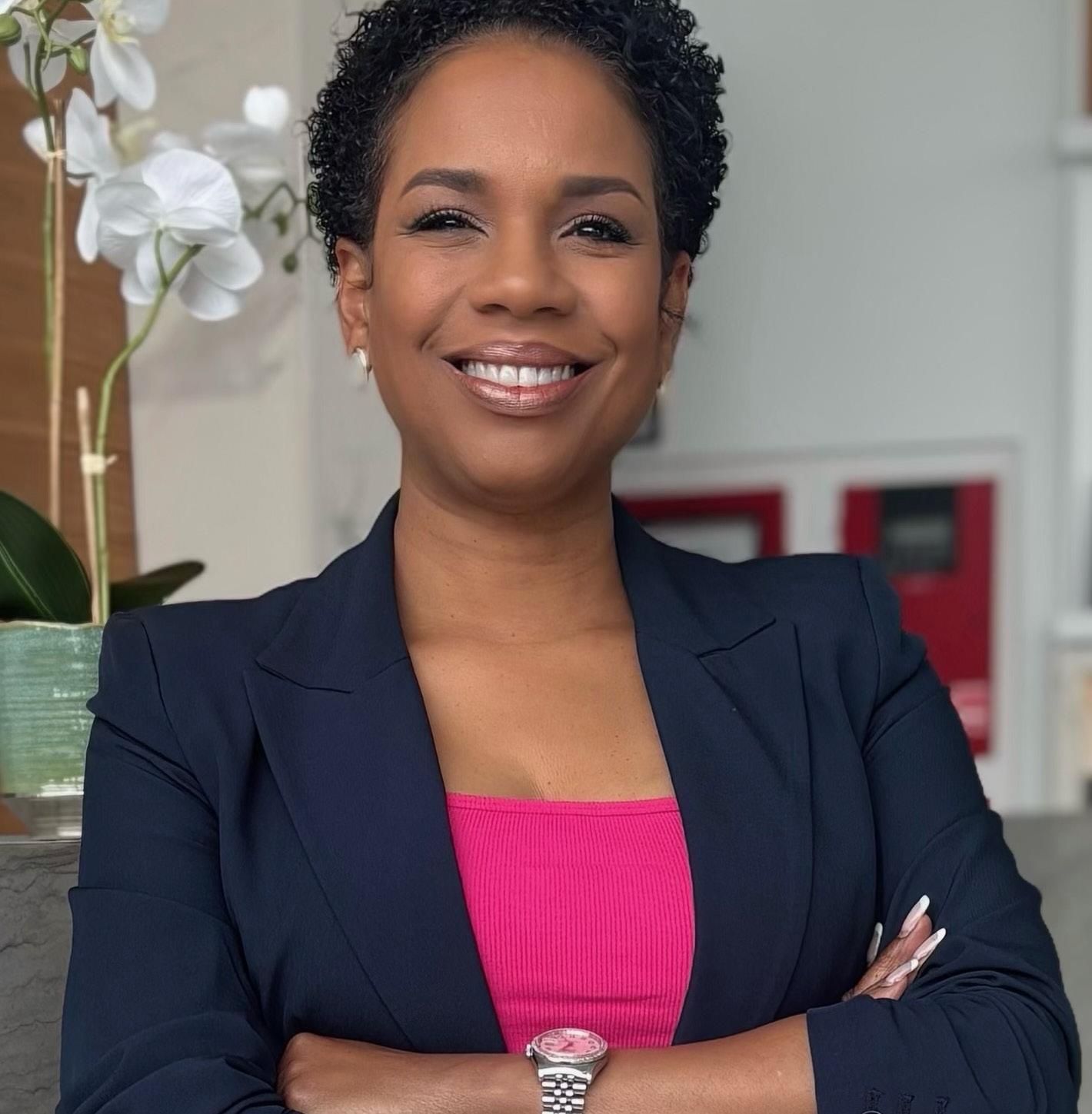
Neighbor Works’ symposium to focus on coalition-building for property inheritors
By KAREN JUANITA CARRILLO Amsterdam News Staff
To mark the 20th anniversary of Hurricane Katrina, the national nonprofit NeighborWorks America will hold a training institute in New Orleans, LA, from August 25–29.
The NeighborWorks Training Institute (NTI), an opportunity for anyone interested in housing and community development issues to connect and gain knowledge about these topics, will also offer a symposium focused on coalition-building for property inheritors.
This event is intended to help people understand how they can protect their homes, particularly when natural disasters or longneglected maintenance issues can force homeowners to pay for costly renovations, or even when local gentrification hurdles surface. It is designed to be a resource to help homeowners view their properties as assets that can create intergenerational stability and wealth.
Molly Barackman-Eder, NeighborWorks’ financial capability director, explained that while it’s currently scheduled as an in-person event, the NTI symposium might be recorded and later posted online. “Some of [it] will be specific to laws and policies in New Orleans and Louisiana,” she said. “We will certainly talk about the status of home-
ownership and how people inherited their housing, maybe informally before Katrina: what that meant for the ongoing recovery from Katrina, where there are bright spots, and what we can learn from what is working in southeast Louisiana.”
When New Orleans was decimated by Hurricane Katrina, homeowners and property inheritors who survived were challenged to prove ownership of their homes before they could access governmental programs, rebuilding services, and submit insurance claims.
Fighting to establish ownership
New Orleans is not the only place where these kinds of issues come up.
Here, in New York City, the AmNews has heard from property inheritors who have fought to establish ownership of long-held family homes because deeds and property titles were never put in their name.
“It’s really a hard conversation to have with people,” Barackman-Eder said.
“People should know that when we first started broaching this topic at NeighborWorks, there was some question around, well, isn’t this a legal aid issue: Is this really a housing counseling and community development issue? We talked to some of our organizations that were doing the work [and]
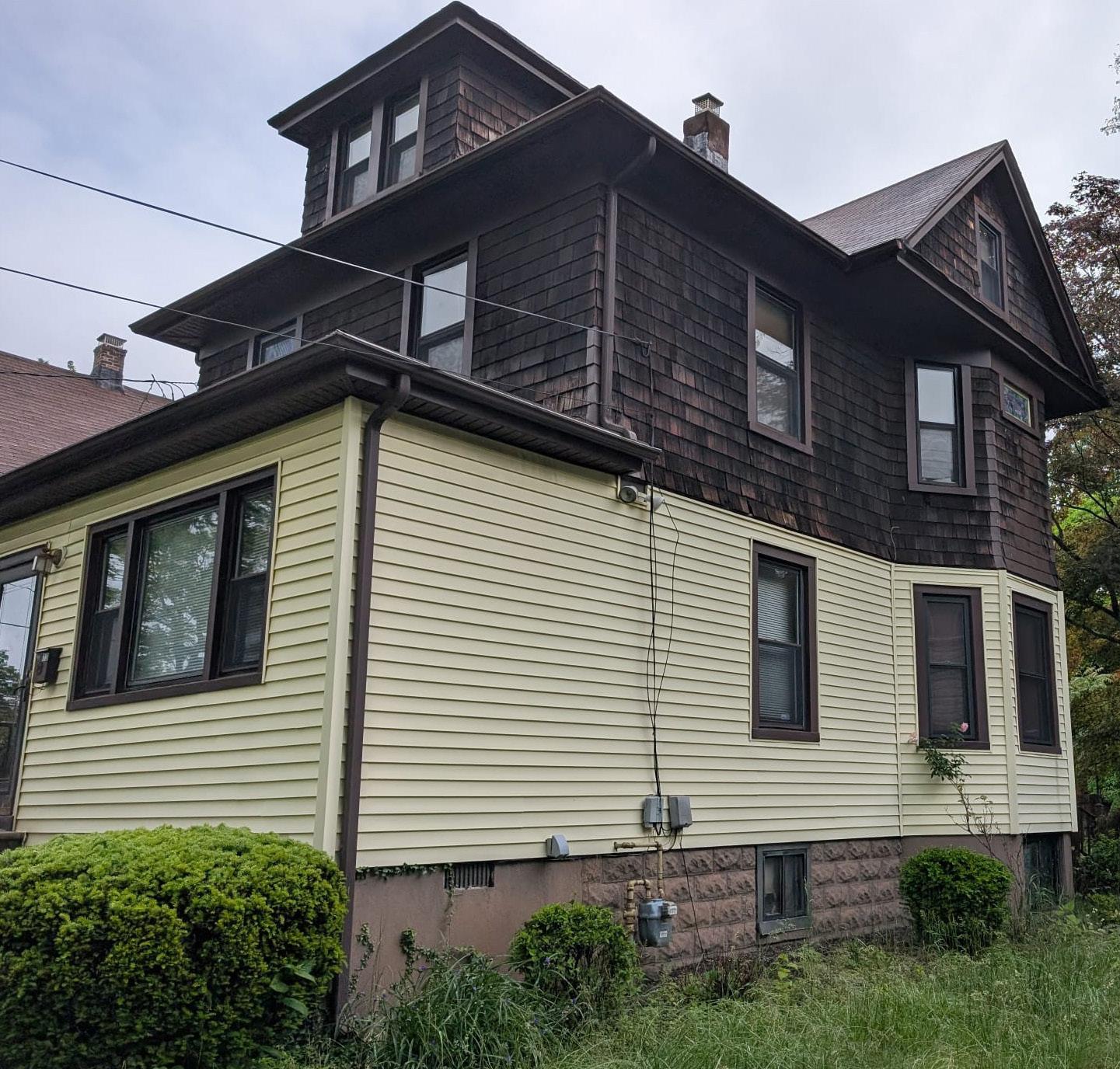
Incumbent Councilmember Kamillah Hanks. (Contributed by Kamillah Hanks)
NeighborWorks
Lee photo)
A bottle, a block, a beacon: Fermented Grapes BK and the woman behind it
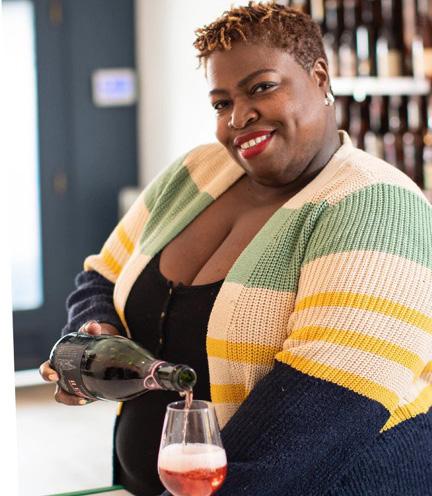
Rashidah Bernay Fowler Special to AmNews
On Vanderbilt Avenue in the Brooklyn neighborhood of Prospect Heights stands Fermented Grapes, a wine shop and decades long staple in an ever changing community. Sandwiched between a reflexology spa on their left and an apartment building and barbershop on their right, Fermented Grapes planted roots in the area in 2004 and switched hands in 2021. The original owners, a Black woman and a Jewish woman, made waves by creating the first wine and spirits shop on the block and because few members of the wine and spirits community looked like them. They set an example for their first ever fulltime employee in their first year of opening, so much so that she decided to purchase the establishment when they were ready to retire.
Kilolo Strobert, a Brooklyn native with bluegreen faux locs and an infectious laugh, knew years before purchasing that she wanted the wine shop. “I approached them in 2018, to buy the store. I knew they were getting older, so I said let me put this in their ear before they start getting other offers or entertaining other
people.” Only having worked in the establishment for a little over a year, she left to pursue other opportunities which included training at one of the best culinary institutes in the U.S., Johnson and Wales University. Upon finishing her education, Strobert went on to work for culinary businesses like Le Parker Meridien, Zagat, and Fresh Direct.
The shop located between Park Place and Prospect Place is recognizable by its cerulean blue awning. No logo is displayed, just Wines & Spirits across the flap. From the outside looking in, you can see the array of bottles perfectly arranged on the wooden shelves and in glass fridges. As you get closer you notice the unassuming logo of Fermented Grapes in block letters encased in a rectangle, it’s attractive and simple. What you can’t see, however, is the vibe that Strobert brings until you open the doors and enter.
On a hot, muggy NYC summer evening, cool air greets you and the sound of hip hop generated from the speakers invites you to the party. Strobert sits behind the checkout counter cutting little plastic tabs with a mini paper cutter to adjust displays throughout the store. You
THE URBAN AGENDA
By David R. Jones, Esq

Federal Loan Caps Put NY’s Workforce and Educational Equity at Risk
The One Big Beautiful Bill Act, set to take effect in 2026, is a sweeping overhaul of federal student aid programs. Despite its name, there is nothing beautiful about it. For New York, the consequences will be devastating: less access to education, fewer trained professionals in critical fields, and deeper economic inequality for generations to come.
This legislation eliminates Graduate PLUS loans and imposes strict federal borrowing caps for graduate and professional students. It also places new limits on Parent PLUS loans while restricting repayment and forgiveness options. All of this is being done under the guise of reform but make no mistake, the intent is not to lower the cost of college. It’s to limit who gets to attend and who gets to advance.
States like New York will soon be forced to choose between competing priorities: healthcare, housing, food assistance — or education. Education will likely be left behind, considered less urgent. But the consequences of that decision will be both immediate and long-lasting.
In the short term, we will see fewer students, particularly from low-income and historically excluded communities, enter college and graduate school. Enrollment declines will hit public and private institutions hard, threatening their financial survival. We’ve already seen this play out with the closure of schools like College of Saint Rose in Albany. Without intervention, more closures will follow.
Longer term, we’ll face a professional workforce crisis. Fewer doctors, nurses, social workers, teachers, and lawyers will graduate at a time when our communities need them most. The federal legislation severely undercuts New York’s efforts to build a strong, inclusive workforce for the future.
Graduate School: Priced Out by Design
Beginning July 1, 2026, new borrowers pursuing non-professional graduate degrees will be limited to $20,500 per year in federal loans and $100,000 total. Those in professional programs like law or medicine can borrow $50,000 per year, capped at $200,000.
While those numbers may sound substantial, they fall far short of the actual cost. The average cost of law school is now over $220,000. Medical school can exceed $250,000 and that’s not including living expenses. Under the new law, students from wealthy families will still go to graduate school. Everyone else will be left behind.
This is a deliberate reversal of decades of progress. Over the last 20 years, students of color and working-class families of all races have increasingly earned advanced degrees and entered fields once closed to them. This bill threatens to undo all of that. It’s no coincidence that Project 2025 — the right-wing poli-
cy blueprint informing this legislation — calls for eliminating access to federal loans and steering borrowers into the private market.
That’s not reform but exclusion, designed to keep even those who manage to earn a degree trapped in perpetual debt through costly private loans.
The changes to Parent PLUS loans are just as damaging. Parents will soon be limited to borrowing $20,000 per year and a total of $65,000 per dependent child. That may sound like a lot, until you consider that the average annual cost of college now exceeds $27,000 for in-state students at a public university, and well over $56,000 at private institutions.
Parents who borrow after July 1, 2026, will also lose access to income-driven repayment plans and will be blocked from obtaining loan forgiveness. They’ll be locked into a standard repayment schedule with no flexibility, even if they face job loss, illness, or caregiving responsibilities. And if they default, they risk wage garnishment, credit damage, and in extreme cases, losing retirement savings or Social Security benefits.
This is especially cruel considering the Parent PLUS loan portfolio, which is now over $100 billion, disproportionately consists of low-income borrowers and families of color. These parents were encouraged to borrow so their children could access opportunity. Now they’ll be punished for doing so.
What New York Must Do
The federal government is turning its back on students and families. New York must step up. Fortunately, New Yorkers with student loan debt can obtain free counseling services, get help managing their student loans, and access relief programs through EDCAP, a program funded by the state and operated by the Community Service Society of New York. But the scope and sweep of the federal threat borrowers face requires expanding resources and a robust public awareness effort.
What is needed is a coordinated, statewide response. That includes expanding state-based aid for graduate and professional students, investing in SUNY and CUNY pathways to high-demand careers, and expanding financial counseling infrastructure and services to help families understand their options.
It also means fighting these federal changes — in the courts, in Congress, and in coalition with other states.
This isn’t just about education. It’s about whether we will continue to build an equitable and inclusive economy or revert to a time when only the wealthy could afford to dream.
New York has always led the way in fighting for access, equity, and opportunity. It’s time to lead again, before it’s too late.
Kilolo Strobert, owner of Fermented Grapes (Courtesy of Fermented Grapes)
New Yorker
Most recent data shows NYC overdose deaths are down. Will the trend continue?
By TANDY LAU AmNews Staff
During last year’s third quarter (July–September), 498 people died from overdoses in New York City — the lowest in the past five years, according to new preliminary data from the New York City Department of Health and Mental Hygiene (DOHMH). Mayor Eric Adams’s administration points toward investments in harm reduction and recovery services as the reason why, and Adams announced $4 million in total contracts with nine opioid treatment providers.
“While overdose deaths in New York City show signs of continued decline, we must keep our foot on the gas pedal to continue to save more lives,” said DOHMH Acting Commissioner Dr. Michelle Morse in a statement. “The New York City Department of Health and Mental Hygiene remains committed to investing in equitable access to harm reduction, treatment, and services that will not only keep our neighbors alive but help them thrive. Using these dollars to support evidence-based interventions through trusted community partners will allow us to reach more New Yorkers and keep people engaged in these lifesaving services.”
Advocates echoed Morse’s comments about needing to build on the positive downward trend in overdose deaths. However, recent federal Medicaid cuts and increased enforcement by the NYPD’s new
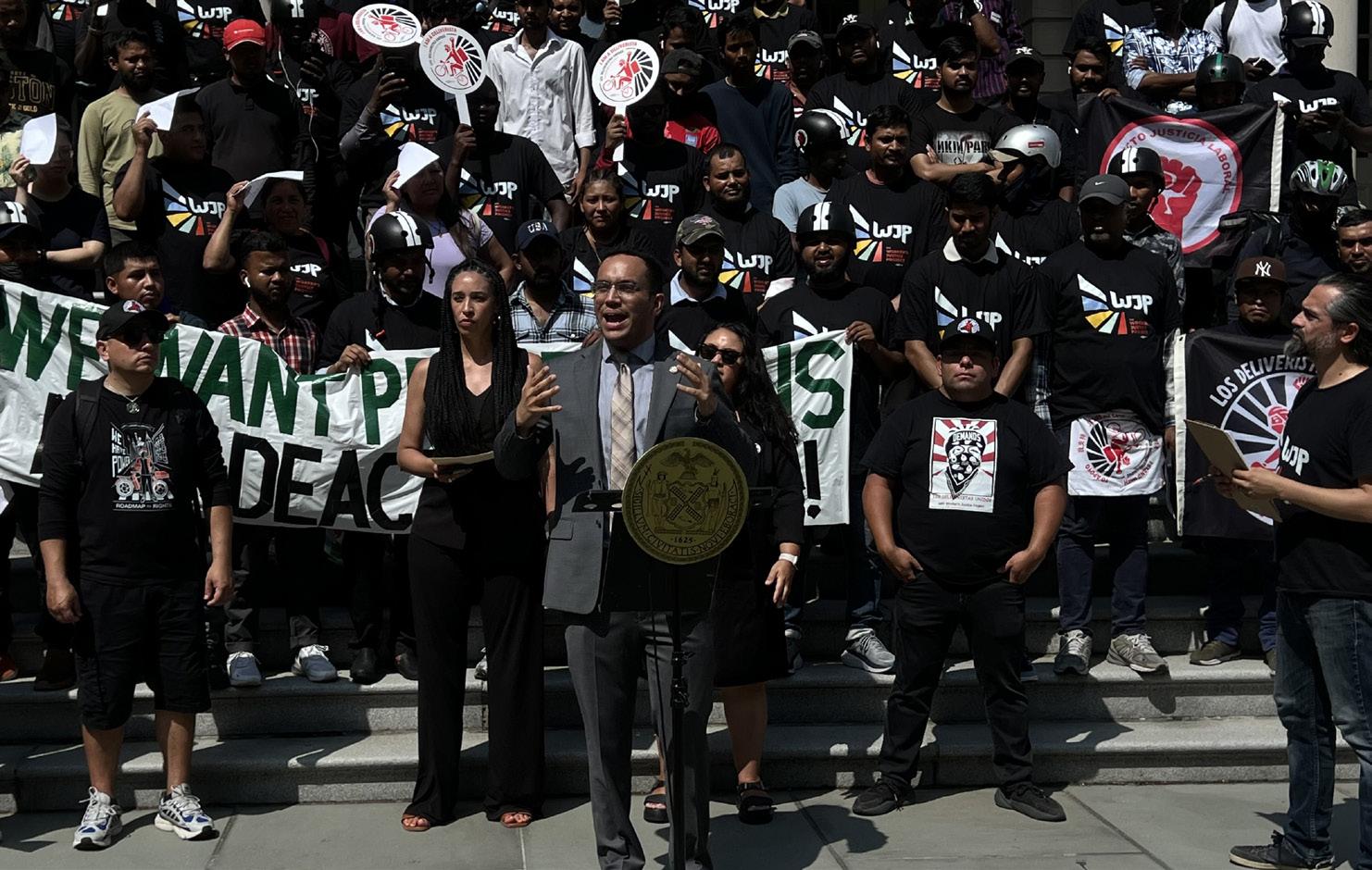
Quality of Life division pose new challenges for the city to maintain recent progress.
“The Medicaid cuts will be devastating to our ability to continue to downward turn the overdose crisis,” said Jasmine Budnella, VOCAL-NY director of drug policy. “Medicaid is the single largest payer of substance use disorder treatment. People will lose access to their methadone and buprenorphine, which inevitably will be harmful if people return to use — their tolerance is so low and the drug supply is so messed up right now and unstable that the risk of over-
doses surging will … happen.”
President Donald Trump’s One Big Beautiful Bill is likely to cost around 1.5 million New Yorkers their medical insurance. Budnella said that while the Republican-led federal government is certainly to blame, the state’s democratic leadership is not helpless. “We need to raise revenue to not only make sure we don’t have [cuts to Medicaid but also] that we can actually address the issues that have long been neglected,” she said.
On the municipal level, the city has in-
creased criminal enforcement against quality of life issues like drug use, which traditionally increases overdose deaths.
Notably, a recent crackdown against a socalled “open air drug market” kicked off in the South Bronx’s bustling Hub. Budnella said everyone deserves to feel safe but believes that more services like a drop-in center rather than “police theater” is the solution.
“The increasing of policing on people is not going to decrease public drug use,” said Budnella. “It’s not going to decrease overdose deaths, and the impact will have the opposite effect, so the mayor, for us to continue to bring down overdose death, needs to look at the holistic aspects of the overdose crisis.”
Both the city and state sued pharmaceutical companies in the late 2010s, resulting in massive opioid settlements to fund addiction prevention and treatment. Through such payouts, the city pays for programs like syringe service providers and street outreach teams.
“While we saw the number of overdose deaths decline very slightly in 2023 and in the data we have for 2024, we continue to lose too many New Yorkers to overdose,” said a DOHMH spokesperson by email. “The recent draconian federal cuts will have a damaging ripple effect on the health care and social safety net systems in place that support many people with
DEATHS on page 44
Mamdani is making inroads with Black and Latino voters
By ARIAMA C. LONG Amsterdam News Staff
Queens Assemblymember Zohran K. Mamdani, this year’s Democratic mayoral nominee, is using momentum from his primary win to capture the hearts and minds of Black and Latino voters in Harlem, the Bronx, and Brooklyn.
Even though Mamdani earned more than 545,000 votes across the five boroughs, the most of any Democratic primary candidate in the past 36 years, the big question after his win in June is if other more traditional Democrats would support a socialist going into the general election in November.
“A little more than two weeks from the primary. Much has been written,” said Mamdani at a gathering in Washington Heights. “But when I have had to read the smears and the slander from Republican Congresspeople, I need not look far to find a leader who has had to endure the same. The same on the basis of his name, on the basis of where he comes from, on the basis of who he fights for.”
According to election map data from the primary, former Governor Andrew Cuomo won many majority Black neighborhoods in Brooklyn, Queens, and the Bronx. However, Mamdani dominated Central Harlem, East Harlem, and Washington Heights as
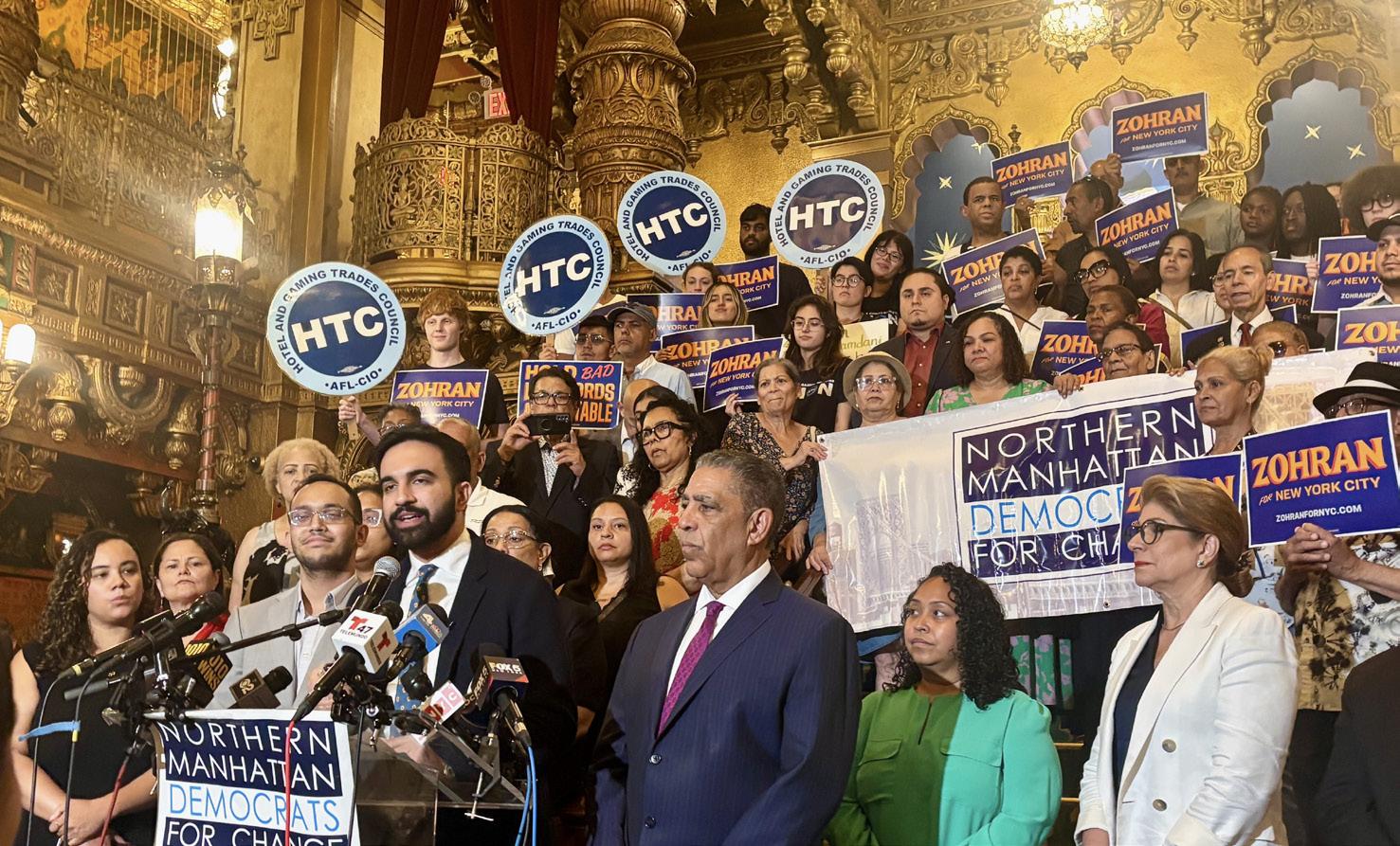
well as several neighborhoods in Brooklyn and Queens.
“When we ran this campaign and continue to do so, in speaking about freezing the rent for more than 2 million rent stabilized units, about making buses fast and free, about delivering universal child care,” said Mamdani. “I will be a mayor for everyone in the City, and I am so excited at working to-
gether with everyone here at this stage, and everyone alongside us, in making that clear day after day, because this general election is also an opportunity to show what the next administration will look like.”
Assemblymember Rodneyse Bichotte Hermelyn, who is the Assembly Majority Whip and Brooklyn County Democratic Party Boss, had originally been all in for
Cuomo. But she was among the first to endorse Mamdani a few days post-election, and has been active on social media with his campaign as of late.
In the weeks since the primary, Manhattan’s most established Black and Latino Democrats, Manhattan County Democratic Party Boss Keith L.T. Wright and Congressmember Adriano Espaillat, decided to endorse Mamdani as well.
Wright and the Manhattan Dems voted on July 8 to endorse him to be the next mayor. His son, Assemblymember Jordan Wright, along with several churches and faith leaders in Manhattan, had backed Cuomo in the months leading up to the primary.
“The Manhattan Democratic Party’s Executive Committee was proud to endorse Assemblyman Zohran K. Mamdani for Mayor,” said Wright in a statement. “While Democratic Clubs across our borough made their own endorsements for the June primary, we are excited to come together as one party and support Assemblyman Mamdani’s vision for a Manhattan and a New York City that are affordable for those who keep our city running every day. We look forward to working closely to maintain the dramatic increase in voter engagement and turnout we saw this June and grow it for the November General Election.”
See MAMDANI on page 44
See OVERDISE
Advocates carry fake body bags to call for an end to overdose deaths in an Aug. 2024 protest outside of Gov. Kathy Hochul’s New York City office in Murray Hill. (Tandy Lau photo)
Congressmember Adriano Espaillat endorsed mayoral candidate Zohran Mamdani on July 10 in Washington Heights. (Ariama C. Long)

NaviLens
Accessible Code®
Scan NaviLens codes in subway stations and at bus stops for real-time service status, arrival info, and navigation in your phone’s default language.
The NaviLens app provides audio information for riders who are blind or have low vision.
NaviLens GO provides information and system wayfinding via text on your phone’s screen. Learn
Health and wellness for all: StartCare’s first community health fair
By JANAE ANTRUM Special to the AmNews
This month, the streets of Harlem came alive as StartCare hosted its first Health & Resource Fair, a free event designed for families and community members, from 9:00 a.m. to 3:00 p.m., on 124th Street. The event offered health screenings, information about essential resources, and activities for all ages.
For more than 55 years, StartCare has championed the health and well-being of its community. Founded by Dr. Beny J. Primm, the organization has expanded from its beginnings in Brooklyn to seven locations across New York City, with a mission focused on addiction treatment, mental health support, and primary care.
As this year’s fair illustrated, StartCare is more than just a health provider; it’s a comprehensive resource for the people of Harlem.“We have to educate our community more about these health disparities and healthy lifestyles,” stated CEO of StartCare, Jonnel C. Doris, MPPA, MDIV.
The fair attracted more than 500 attendees and featured 53 vendors offering services such as mammogram screenings, prostate inspections, and HIV testing. Among
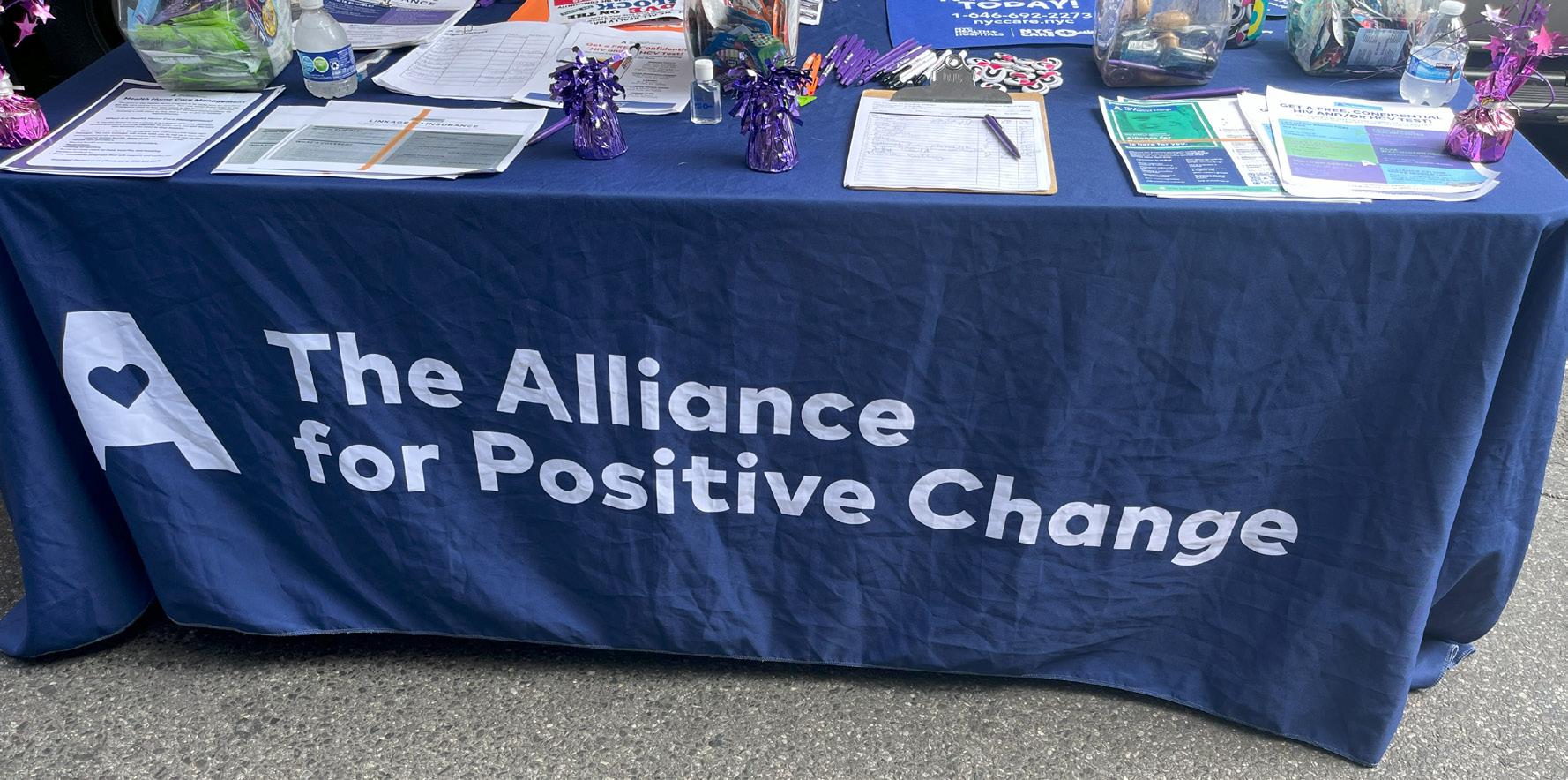
the vendors was the Alliance for Positive Change, which provided free HIV and hepatitis-C testing, alongside services like nutrition support, case management, and art activities.
Attendees also had the opportunity to learn about the Healthy Brain and Child Development Study being conducted by NYU Langone, represented by Sachin Sohal. This nationwide study seeks to understand newborn development while taking into account a mother’s health and environmental factors over a 10-year
period. Sohal, who acts as a project assistant and peer support advocate, highlighted the study’s aims and expressed the importance of community contribution through events like this one.
Samaritan Daytop Village was present as well, showcasing their range of services, from mental health care to support specifically for veterans.
Similarly, Phoenix House New York, a place for mental health support and substance abuse treatment, promoted their new Harlem clubhouse, a community-
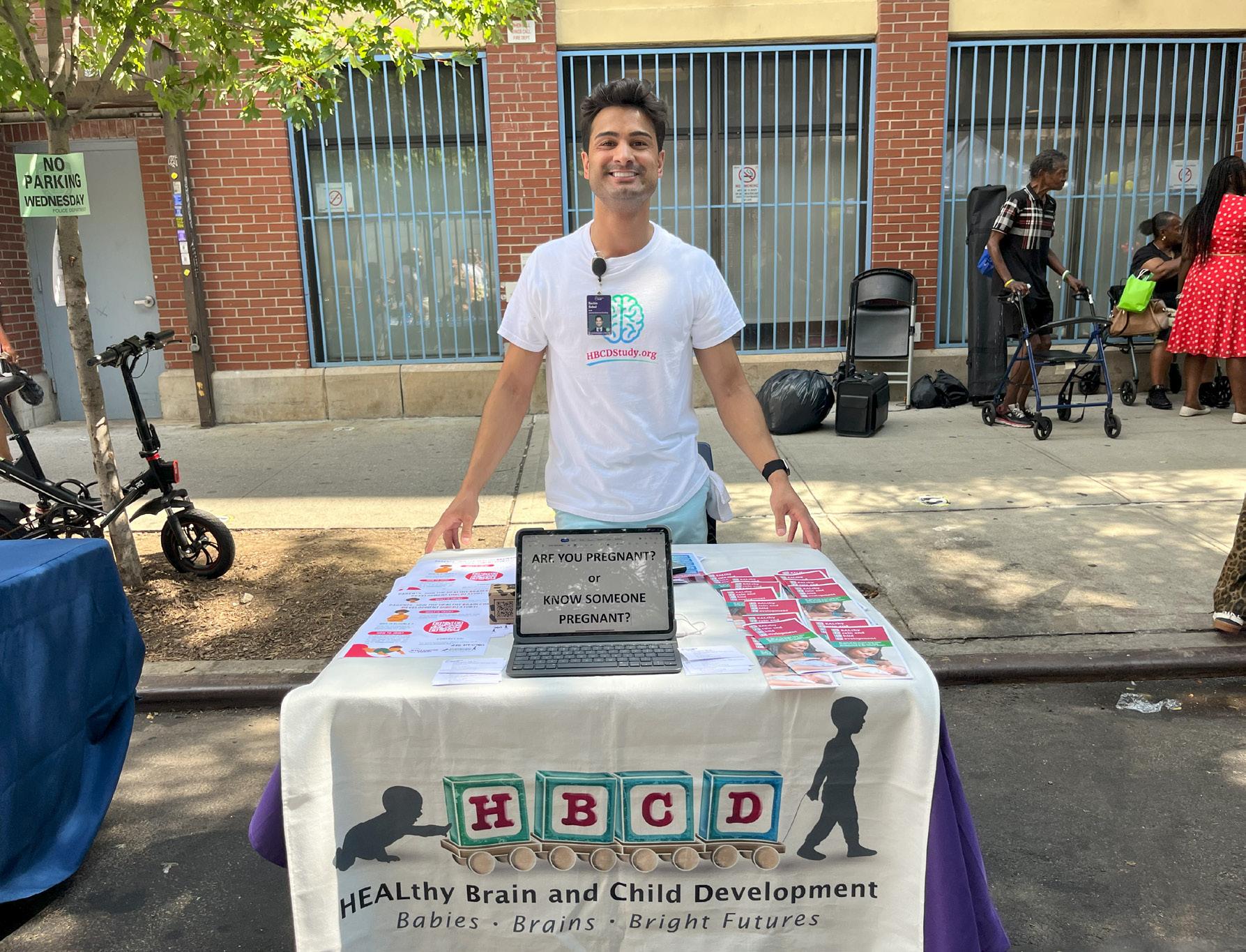
focused space aimed at empowering members and encouraging collaboration. The clubhouse will celebrate its official opening with a ribbon-cutting ceremony on July 28. Members actively participate in the clubhouse by taking on various responsibilities, such as cooking and maintaining the space, fostering a non-hierarchical environment where everyone’s voice is valued. As the program director for the clubhouse noted, “Everything we do for the community is driven by the members.”
As CEO, Jonnel C. Doris provides
a compelling vision for StartCare. His primary focus is on assembling a team dedicated to delivering support and care to individuals in the community facing various health disparities. Doris finds tremendous fulfillment in his role, particularly in connecting with those the organization serves. “Riding the elevator, hearing their stories in the morning, saying good morning to everybody — the fact that we can engage with those we serve is what the joy of this is all about,” he said. Looking ahead to next year’s fair, Doris expressed hopes for more initiatives that tackle pressing issues such as food insecurity, job placement, and housing needs, aiming to bring even more resources to Harlem. “We have to look and seek to have resources brought to the community and into central Harlem like never before. We need actual tangible resources that match the need,” he said.
This requires intentional collaboration among government entities, philanthropic organizations, community-based groups, and the faith community. Doris firmly believes that as services, education, and resources converge, “we will continue to make significant strides in addressing disparities and improving health outcomes within our communities.”
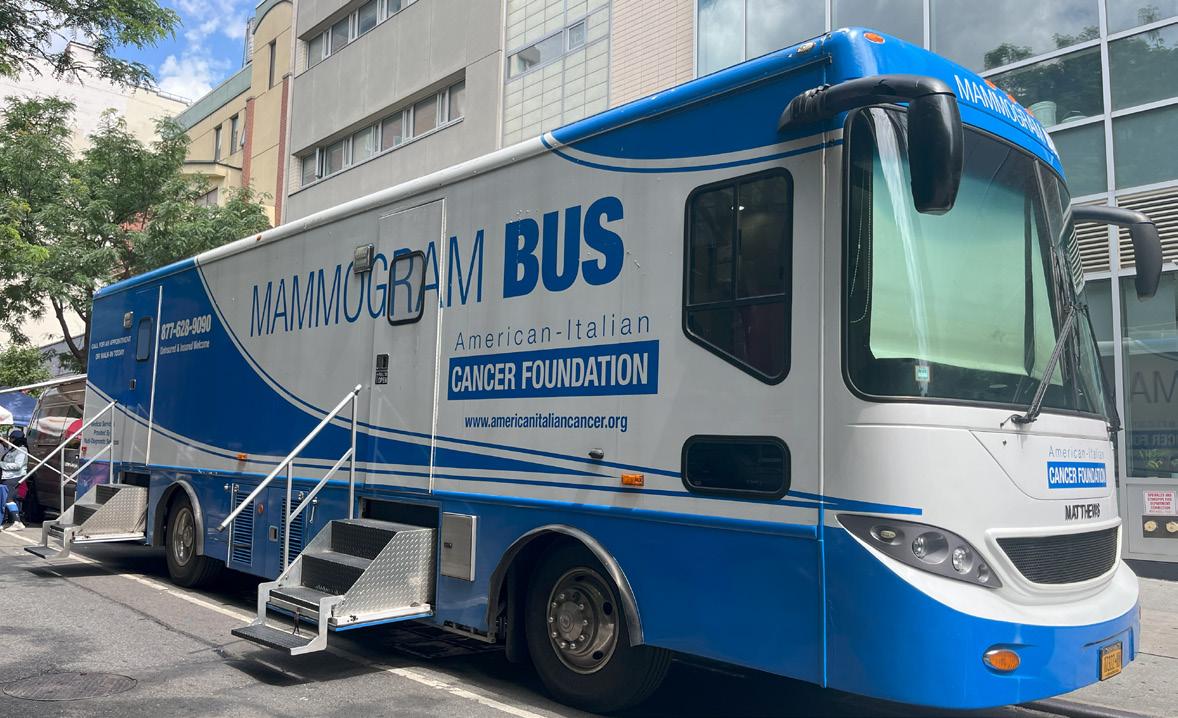
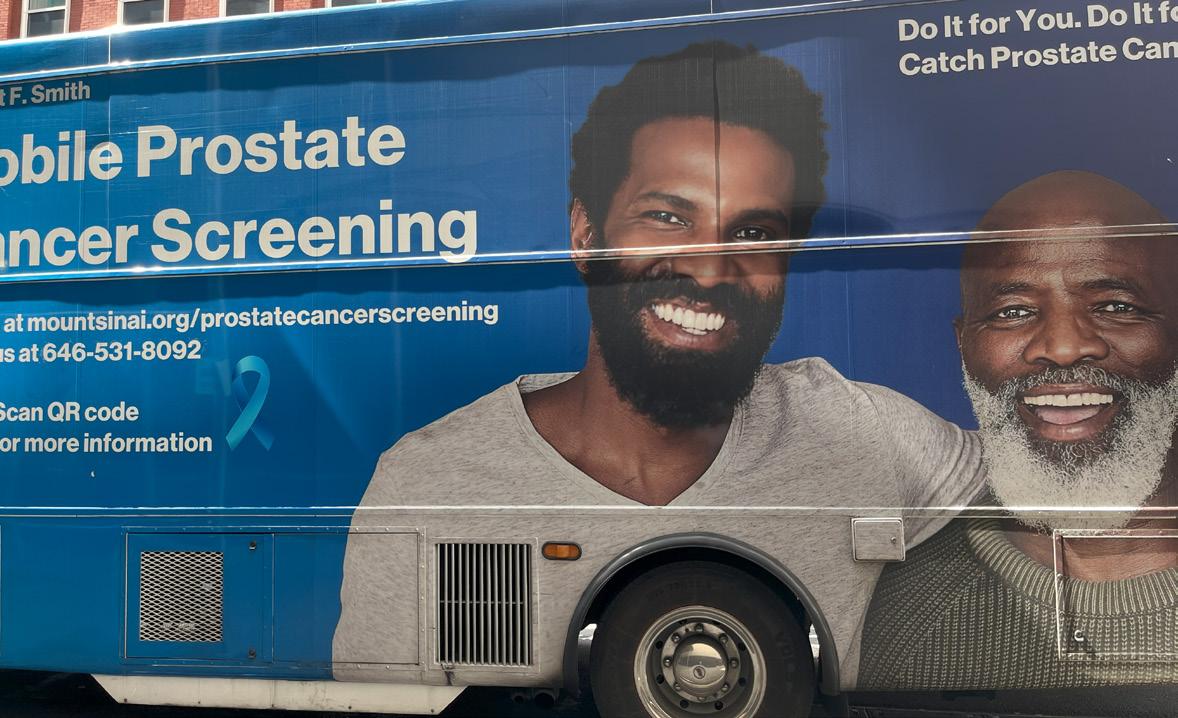
Sachin Sohal, project assistant and peer support advocate for Healthy Brain and Child Development Study of NYU Langone.
Alliance for Positive Change table. (Janae Antrum photos)
Mammogram screening bus at StartCare Health Fair. Prostate screening bus at StartCare Health Fair.
2026 New York Fiscal Budget brings new initiatives
By ESMERALDA MORAN Special to the AmNews
The New York City Council approved their 2026 fiscal budget this past weekend. The budget encompasses allocating funding to the programs and services that New Yorkers use. One item that stood out was the budget for the empowerment of Black communities, where $1 million were allocated. Funding for the empowerment of Black communities is located in the youth services section of the fiscal budget. The initiative
will be funded by the Department of Youth & Community Development (DYCD), with over $22 million total being allocated for the section — $7 million more than what was allocated for the 2025 fiscal year budget because of added initiatives this year.
The 2026 fiscal year will be the first year that the empowering of Black communities will be funded, along with two other initiatives within the Youth Services section - LGBTQIA+ Youth Support & Services and Artificial Intelligence Community Engage-
ment. Funding for Black communities will help address disparities across various aspects of life for Black New Yorkers, according to the Fiscal Year 2026 Budget Adjustment Summary. Despite being located in the Youth Services section, funding for Black communities is meant to target Black New Yorkers of all ages, not just youth.
The budget summary includes a list of programs and the City Councilmembers who proposed funding for each. One name that appeared next to multiple programs aimed at supporting Black
communities and youth was Council Member Yusef Salaam of District 9. Salaam provided a statement emphasizing the importance of the funding.
“Investing in our youth is a priority as reflected in the budget. We are living in challenging times, and our young people are bombarded with so much. It is our responsibility to keep them safe, secure, and loved. As the Public Safety Chair on the City Council, I focus on safety not just for Harlem, but for the entire city. It is important that we invest and
support initiatives that contribute to the betterment of all in Harlem with particular emphasis on youth. Funding initiatives which deal with systemic challenges our community has faced that empower our youth is and will always be a focus.”
The 2026 budget has taken effect since the beginning of the new fiscal year on July 1. With the new budget implemented, Black communities will have greater access to programs ranging from access to mental health services to safe spaces for the youth.
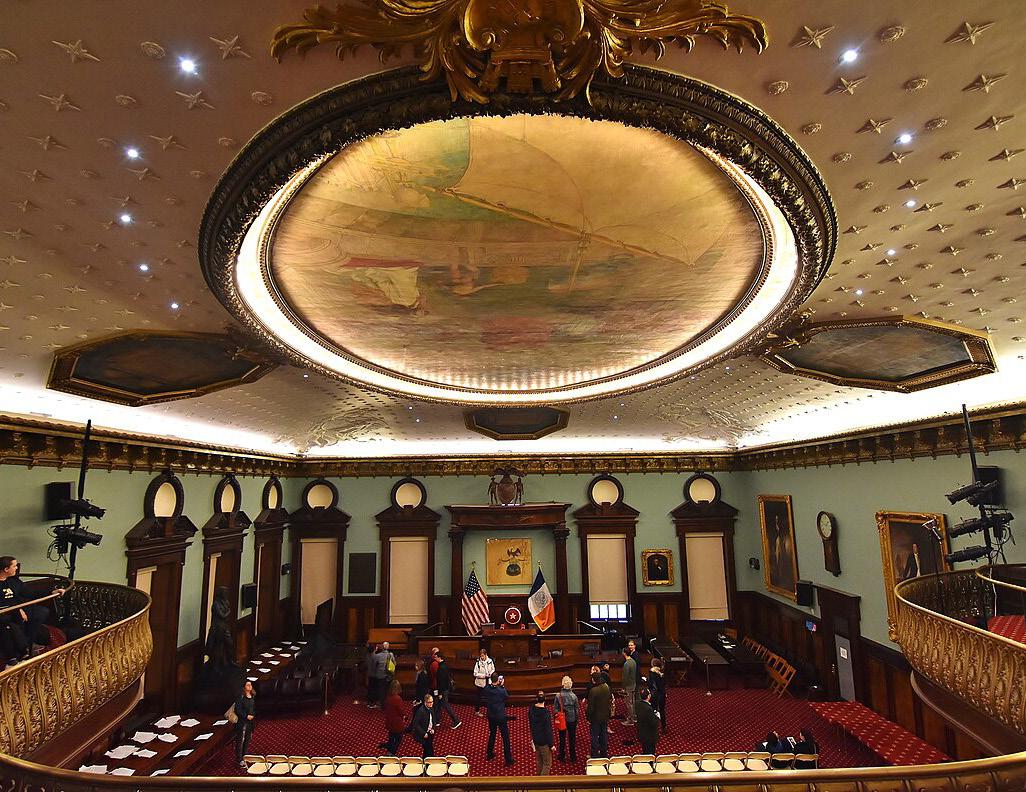
Inside the City Council Chamber at the New York City Hall. (Glenda Altarejos photo via Wikimedia)
Union Matters
Supreme Court allows Trump to dismiss nearly 1,400 DOE workers
By KAREN JUANITA CARRILLO Amsterdam News Staff
The Department of Education (DOE) will initiate widespread layoffs following the U.S. Supreme Court’s July 14 ruling permitting the Trump administration to proceed with restructuring the department.
The DOE is expected to lay off nearly 1,400 employees, all members of the American Federation of Government Employees (AFGE) Local 252.
In a 6-3 emergency decision, the Supreme Court lifted lower-court injunctions against Trump’s restructurings, which he called for in a March 20 Executive Order. Closing the Department of Education, Trump’s order said, will improve educational services, programs, and benefits by returning the authority to administer them to the states.
The DOE’s being allowed to proceed with Trump’s reduction in force (RIF) plans was highly criticized by the Supreme Court’s three Democratic Party-appointed justices –– Sonia Sotomayor, Elena Kagan, and Ketanji Brown Jackson. While the conservative-led majority did not explain their reasoning for allowing the administration to proceed with its layoffs, the dissenters clarified their objections.
“When the Executive publicly announces its intent to break the law, and then executes on that promise, it is the Judiciary’s duty to check that lawlessness, not expedite it,” Judge Sotomayor wrote.
“Two lower courts rose to the occasion, preliminarily enjoining the mass firings while the litigation remains ongoing. Rather than maintain the status quo, however, this Court now intervenes, lifting the injunction and permitting the Government to proceed with dismantling the Department. That decision is indefensible.”
Future me’s
Sheria Smith, president of AFGE Local 252, is one of the DOE employees set to be laid off. Smith told CNN’s “The Situation Room with Wolf Blitzer” that she and the other workers have, to this day, not been given a reason for their job terminations. There are no performance write-ups against them, and the layoffs don’t appear to be based on seniority.
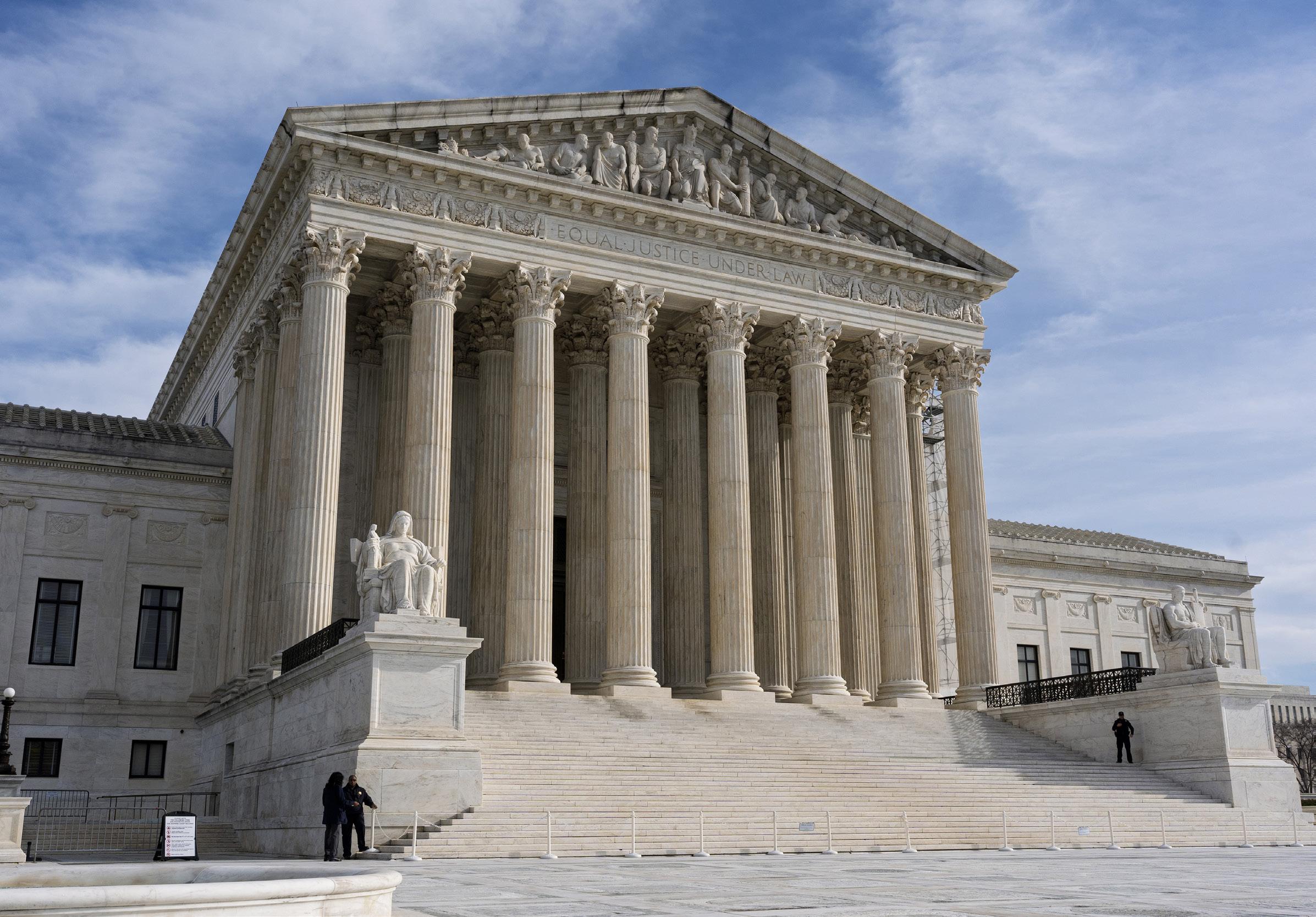
“I have a range of emotions,” Smith told Wolf Blitzer. “The first one is disappointment. I’m a lawyer by trade, and I live for Supreme Court decisions, at least to have reasoning. So, to have the six justices just allow this to happen without even explaining their decision is extremely disappointing.
“Then I go into anger, anger [because] since the beginning of this administration, [they have misrepresented] what we actually do. There’s so many statements about returning education to the states. But, Wolf, I was a teacher. Education curriculum, teacher quality testing have always been with the states. What our department does and did was fund school districts, fund colleges, fund schools, and fund American citizens who are pursuing their education. And it is extremely anger-inducing that this misrepresentation of what we do and how important our
work is, is perpetuated and is not being corrected, even by the highest court of our land.
“And then I go to sadness. I’m a recipient or product of Title I schools. I’m a recipient of Pell Grants. And I think about how there will not be future me’s. People who are coming from working-class families, who want a different way of life, who want to improve their life choices through education, this administration is making it harder.”
Decisions about staffing levels
The Education Department mainly enforces regulations and offers funding and services that states cannot or will not provide. The Associated Press has reported that the DOE could now send federal student loans to the Treasury Department. “The Education Department said it had been negotiating a contract with the Treasury
but paused discussions when the court intervened. That work is now expected to proceed in coming days,” the AP said. “Under a separate arrangement, nine Education Department workers already have been detailed to Treasury, according to a court filing.
“At her Senate confirmation hearing, McMahon suggested that enforcement of the Individuals with Disabilities Education Act could be handled by the Department of Health and Human Services. Civil rights work could be managed by the Justice Department, she said.”
Secretary McMahon praised the Supreme Court decision when it was sent down. In a statement, she said, “Today, the Supreme Court again confirmed the obvious: the president of the United States, as the head of the Executive Branch, has the ultimate authority to make decisions about staffing levels,
administrative organization, and day-to-day operations of federal agencies. While today’s ruling is a significant win for students and families, it is a shame that the highest court in the land had to step in to allow President Trump to advance the reforms Americans elected him to deliver using the authorities granted to him by the U.S. Constitution.
“The U.S. Department of Education will now deliver on its mandate to restore excellence in American education. We will carry out the reduction in force to promote efficiency and accountability and to ensure resources are directed where they matter most – to students, parents, and teachers. As we return education to the states, this Administration will continue to perform all statutory duties while empowering families and teachers by reducing education bureaucracy.”
The Supreme Court is seen on Capitol Hill in Washington, Dec. 17, 2024. (AP Photo/J. Scott Applewhite, File)
Feliz family rallies against Tisch’s decision
By ESMERALDA MORAN Special to the AmNews
Following Police Commissioner Jessica Tisch’s preliminary decision to not fire Lt. Jonathan Rivera, Allan Feliz’s family alongside several community organizations took to the streets calling for the officer’s firing on July 11.
The family and supporters gathered in front of the New York City Police Department headquarters, the Friday following Tisch’s decision, voicing their opinions regarding the decision and urging the commissioner to change her mind. The decision came as a shock to the family who received news of Tisch’s choice to go against NYPD Deputy Commissioner Rosemarie Maldonado’s guilty verdict on July 3.
“It was a slap in the face,” said Ashley Verdeja, Allan’s sister.
Various community organizations took a stand against Tisch’s decision, joining the Feliz family in their rally. Local community organizations spoke at the rally in support as well as government officials, including State Senator Julia Salazar.
“While Mr. Feliz’s family has been grieving his loss and fight-

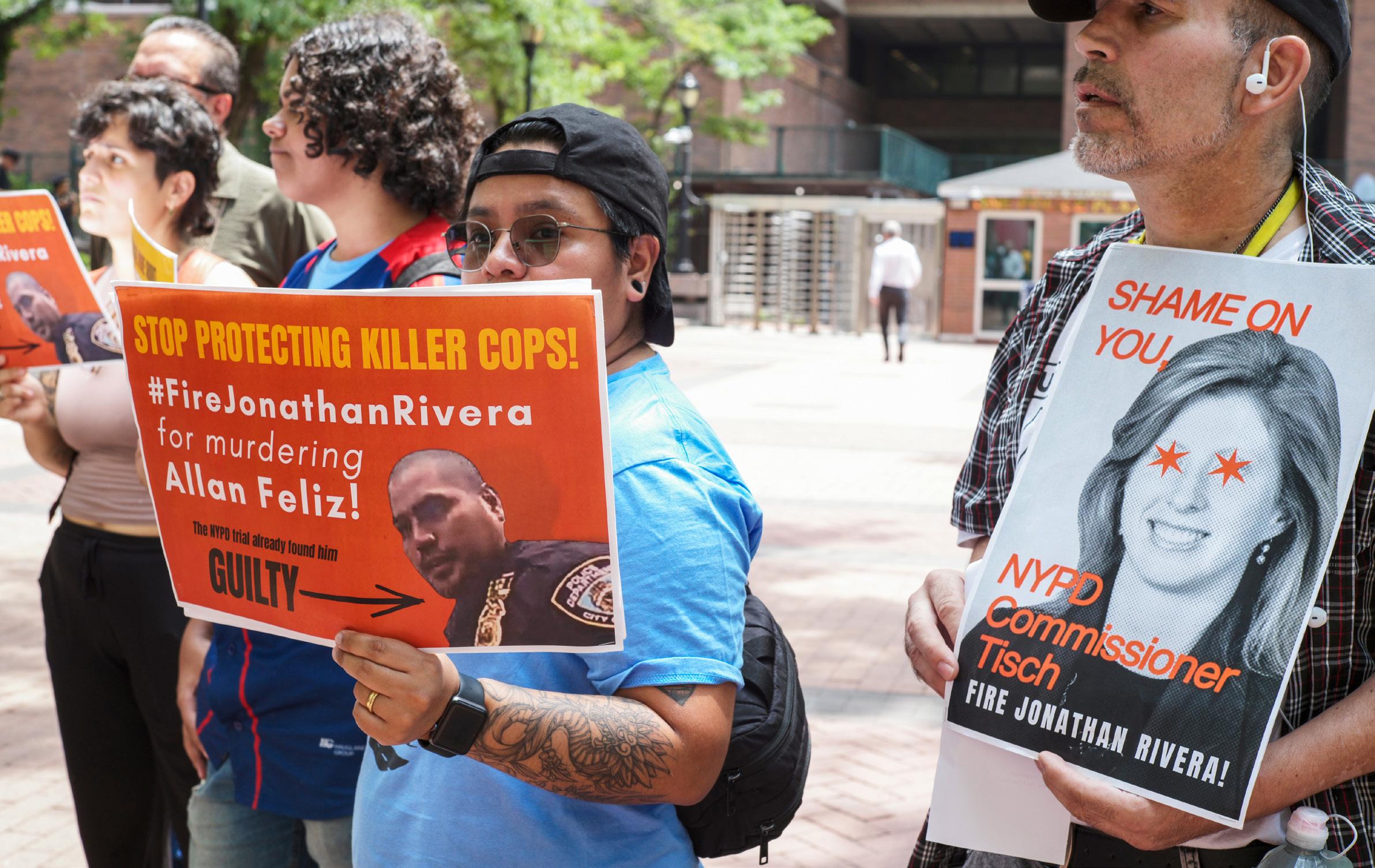
ing for accountability, Jonathan Rivera got away with murder and got a promotion. That’s not justice, that’s corruption. I’m calling on the commissioner to immediately reverse her decision, and fire Lt. Rivera,” said Salazar in her speech at the rally.
As the mayoral election approaches, the question of whether Tisch will stay in her job remains in the air. Democratic primary winner Zohran Mamdani has considered retaining Tisch as police commissioner, if he is elected. The Feliz family voiced their concern regarding Tisch’s potential retention.
“We just think that it’s a shame that she’s choosing to make that decision, and that she shouldn’t be the next police commissioner when the November elections come around. I know that there have been a lot of mayoral candidates that have mentioned her and her work and her service to the city so far, but I just would mention to them to look at this situation and how she’s handling it,” said Samy Feliz, Allan’s brother.
Community organizations including the Justice Committee, See ALLEN FELIZ on page 39
Samy Feliz, brother of Allan, has called for Tisch to reverse her decision. (Damaso Reyes photos)
President Ignoramus
Rep. Jasmine Crockett of Texas has been spot on and consistent with her comments on Trump’s misinformation and other gaffes.
Last week she demonstrated another example of this concern when she took exception to his remark that Liberian President Joseph Boakai spoke good English, obviously ignorant of the nation’s long historical connection to the U.S. “Trump never misses an opportunity to be racist and wrong, and every day he finds a new way to be embarrassing,” she posted on X, formerly Twitter. “Asking the President of Liberia where he learned English when it’s literally the official language is peak ignorance. I’m pretty sure being blatantly offensive is not how you go about conducting diplomacy…”
Trump had the audacity or stupidity to ask the president where he learned to speak such good English. Well, Mr. Ignoramus, Liberia was founded in 1822 by African Americans in search of freedom from slavery and by 1847 established its independence
from the U.S. President Boakai, very warmly accepted Trump’s praise and announced that he was interested in “making America great again.”
There is nothing new about Trump’s misapprehension of African history and culture, none more egregious as his recent opening our doors to white Afrikaners, who in his poor estimation were being discriminated against by the South African government's by the South African government's leadership.
In his determination to do away with DEI (diversity, inclusion and equality), to say nothing of destroying the department of education, his ineptitude of the nation’s history and global relations will be further diminished.
It’s perhaps much too late to rectify Trump’s inadequacies on this subject, but we must do all we can to stop his spread of dumbness, his lack of intelligence. Yes, Jasmine, you are by no means alone on this matter, and it is our hope that others share your umbrage with this unlearned non-leader.

America is a survivor of gender-based violence. Congress must act now to stop her abuser.
By AZALEEA CARLEA
As a longtime advocate against gender-based violence, it is clear to me that America is a battered woman, and President Donald Trump is her abuser. Congress must do its job to stop him and secure the safety of this country and its people.
America is no stranger to trauma. She’s seen wars, economic collapse, racial and gender injustice, and systemic inequality. But under the coercive control of this administration, America is afraid to speak. Her body (America’s people) and her choices (their freedoms) are tightly controlled.
The dynamics of this administration’s abuse of power closely follow the cycle of abuse seen in many cases of gender-based violence. When applying the Power and Control Wheel, a tool used internationally to understand the dynamics of abusive relationships, the parallels are sadly all too clear. Each of the eight segments of the wheel mirrors the tactics currently employed not against a single partner, but against our entire nation.
Trump’s tactics of reproductive coercion most closely mimic a hallmark of intimate partner violence that includes sabotaging birth control and forcing pregnancy outcomes. State bans and restrictions on abortion — entirely enabled by his Supreme Court nominations, federal judge appointees, and rhetoric — are no different. The state has stepped into the role of an abusive partner, instructing women that they must carry pregnancies no matter the cost to their health, their lives, or financial stability — not unlike an abuser forcing pregnancy to keep a partner dependent on the relationship.

Elinor R. Tatum: Publisher and Editor in Chief
Damaso Reyes: Executive & Investigative Editor
Kristin Fayne-Mulroy: Managing Editor
Cyril Josh Barker: Digital
Editor
Siobhan "Sam" Bennett: Chief Revenue Officer and Head of Advertising
Wilbert A. Tatum (1984-2009): Chairman
Recent ideas for so-called incentives for pregnancy make even clearer that the administration sees women as tools to advance white, Christian ideological goals rather than acting on a genuine concern for family well-being. Additionally, when you consider the fact that the majority of men who murder their female partners use a gun to do so, the administration closing the White House

Office of Gun Violence Prevention, launching a 2nd Amendment Task Force, and stripping funding from agencies like the Office on Violence Against Women poses a tangible threat to lives of women across the country. Coupled with the fact that more than 300 grants have been terminated from the DOJ Office of Justice Programs, this administration has enshrined gender-based violence into policy.
In addition to its attacks against women, all aspects of the administration’s increasingly cruel immigration enforcement encapsulate the use of threats, intimidation, and fear used by abusers, — gaslit as a matter of national security.
All Americans are filled with uncertainty as a direct result of federal action. Tariffs are wreaking havoc on American markets and families’ pocketbooks, mirroring an abuser’s financial control of victims and disabling the opportunity for economic mobility.
These targeted campaigns against the American people combined with the relentless attacks against the government itself — like threatening the Department of Education, gutting the Department of Health & Human Services, and the chipping away of social safety nets like Medicare, SNAP, and vital programs supported by federal funding — reveal a government driven by cruelty and uninterested in allowing its people to seek a better future for themselves.
Finally, the “America First” foreign policy that actively turns allies away and plunges the country into isolationism helps make the entire cycle of abuse possible, just as an abuser cuts their victim off from support networks.
This isn’t new behavior. America has seen this before: Trump’s first term, marked by the Muslim travel ban, traumatic family separation policies, and COVID misinformation, followed this same harmful pattern. Unfortunately, like so many survivors of abuse, America went back, hoping, perhaps, that the chaos of his first term might iron out into a more professional second. But instead, in a classic sign of abuse, he escalated.
To break this cycle, we must first call it what it is: abuse.
Now, Congress must step up.
This week, the National Task Force to End Sexual & Domestic Violence held a day of action at Capitol Hill to demand that Congress close the dangerous gap in funding for survivors of domestic and gender-based violence created by this abusive executive branch. This would be an essential first step forward in healing, and a catalyst for the support that must follow for every group that has been targeted and victimized for years.
Azaleea Carlea is legal director at Legal Momentum, The Women’s Legal Defense and Education Fund.
Azaleea Carlea
President Donald Trump and First Lady Melania Trump attend the FIFA Club World Cup Final (White House photo)
Sister’s Uptown, a bookstore worth saving

By HERB BOYD
There was a time when Black-owned bookstores were like a lodestone to the movement, particularly in the halcyon sixties. The spirit of those days is given a fresh summary in Katie Mitchell’s “Prose to the People: A Celebration of Black Bookstores” (Clarkson Potter, 2025), with a foreword by Nikki Giovanni. I was asked to recount my long history with such stores, my “bookbeat,” and invariably Sister’s Uptown was profiled. On Friday, July 25, Janifer Wilson and her daughter, Kori, will be hosting a fundraiser at the store, a vibrant cultural center, to help stave off a possible closing. For more than a quarter century, the
store, located at 1942 Amsterdam Ave., has been unstinting in providing the community with a place to enjoy a wide array of books as well as discussions by authors and activists. I have, on a number of occasions, not only hosted events there, but sat in the audience to experience the wisdom of a coterie of renowned speakers. On one memorable appearance, I shared the podium with Cinque Brath with the publication of essays by his father, Elombe. It was an unforgettable moment, and I am sure that regulars at the bookstore will have a similar experience at this event, which will be from 6 to 10 pm. Bring your checkbooks and check out the variety of books, best sellers and classics alike.
Summertime Museums

CHRISTINA GREER, PH.D.
So many of my non-New York friends ask me how I stay sane in the city during the summer. Well, first things first, I try to leave the city as often as I possibly can. There is something about the hot sun hitting all of the brick buildings that makes me feel like a pizza being cooked each time I step outside of my house. One of the ways I have learned to enjoy NYC is to visit as many museums and galleries as possible during the summer. It’s a great way to catch up on exhibits I missed seeing during the academic year. It’s also a great way to spend a cool day in an air-conditioned building, looking at amazing art for an afternoon.
The Met has been on my list to revisit. They have so many innovative exhibits and have been doing a much better job (in my opinion) at showcasing Black artists and themes in Black art; past and present. I also love that it is located on Museum Mile and I can easily stop by the Museum of the City of New York or the El Museo del Barrio, just a few blocks away. I always love heading a bit southwest to check out the Whitney Museum and strolling along the highline afterward. If it’s not too hot, I love to walk across the Brooklyn Bridge and find myself enjoying the Brooklyn Museum.
As a proud trustee of the Tenement Museum, it is also one of my favorite museums to visit. The museum has a newish exhibit showcasing Joseph Moore and
We are building a more affordable New York
By WALTER T. MOSLEY, NYS Secretary of State
Let’s face it, the cost of living isn’t cheap. Whether you’re buying groceries, paying rent or juggling childcare, it can feel like your paycheck is stretched to the limit every week. But Governor Kathy Hochul is committed to improving the quality of life for you and the more than 20 million residents living in New York State. She fought for and delivered a state budget that puts you first and makes New York a more affordable and livable state.
We call it the Affordability Agenda and here’s what it means for you: more money in your pocket, less stress on your wallet, and real investments in your future. We know that too many families across the state are struggling to make ends meet. As the federal government continues to play with reckless and un -
authorized tariffs that have burdened businesses with skyrocketing costs that have been passed along to consumers, the Governor’s Affordability Agenda is centered around making life easier for New Yorkers.
As Secretary of State, I travel all over New York. I talk directly to local leaders and residents from the North Country to Long Island, Syracuse, Buffalo, MidHudson, New York City, and many communities in between. They all tell me the same thing: “We need help.” Prices are up, inflation continues, and Washington’s economic policies are making things worse. But here in New York, we’re not waiting around. We’re taking action. It’s our job.
The Governor’s Affordability Agenda recently passed through the New York State Budget, delivering victories on issues that working families care about most. The FY26 State Budget was a battle
for the governor who fought for real relief, especially for middle- and low-income New Yorkers who go out every day to make ends meet for their families.
But what does all this mean for you?
Here is just some of the relief coming your way:
• Inflation refund checks of up to $400, putting money in the pockets of over 8 million New York households.
• Lower middle-class taxes, with $1 billion annually in tax relief to 8.3 million families.
• Expanded child tax credit that provides up to $1,000 per child to 1.6 million families, which since 2023 has included children under four.
• Free school meals for more than 2.7 million students.
• Safer and more affordable child-
his family. Moore was an African American New Yorker, whose story represents a new glimpse into Black New York from the 1860s and 1870s. There are so many other tours you can enjoy if you are interested in the lives of Italian, Irish, German, Jewish, Asian, or Puerto Rican New Yorkers.
One of my favorite gems is the National Museum of the American Indian at the tip of lower Manhattan. Located in an old customs building, you may have gotten your passport in one of the offices or conducted your Global Entry interview there. The museum has some traditional exhibits and every now and again, some truly mind-blowing exhibits by Native American artists. I am never disappointed when I visit the museum… or its fantastic gift shop.
Hopefully, during the hot (or rainy) days this summer, you will explore some of the dozens of museums, large and small, located in the city. There are museums that cater to transportation, Black art, Chinese Americans, sex, quilts and folk art, African art, to name just a few. It’s New York; explore the many gems hiding in plain sight.
Christina Greer, Ph.D., is an associate professor at Fordham University; author of book “How to Build a Democracy: From Fannie Lou Hamer and Barbara Jordan to Stacey Abrams” and “Black Ethnics: Race, Immigration, and the Pursuit of the American Dream” and is co-host of the podcast FAQ-NYC.
care through big investments that help both parents and providers.
• $15/month high-speed internet access to low income households, helping close the digital divide.
• $2.5 billion in STAR rebates to provide relief to homeowners.
• The most consequential statewide housing plan in decades, so families have access to affordable housing and protects homeowners and renters throughout our state
• Added jobs and boosted tuition assistance, education funding and public transit investments to the highest levels in history so families have the best opportunities for success. And we’re not stopping there. Governor
Sister’s Uptown faces closure. (Damaso Reyes photo)
The unfinished march: The struggle to preserve voting rights
By JASON GONZALEZ Special the the AmNews
Some call it the unfinished march.
60 years after the Voting Rights Act of 1965 (VRA) was passed, the battle for the ballot continues. With a stroke of the pen, and after decades of struggle, the bill so many had fought so long for, finally became law. It was a legislative earthquake that sought to end the political violence of the Jim Crow era and grant Black Americans the opportunity to vote, ensuring their fundamental right to determine the course of the country.
"When the Voting Rights Act was passed, we thought that it would probably bring an end to voting discrimination, which the law itself did. But as various states pushed back, civil rights organizations sort of dropped the ball after the law was passed,” said Raoul Cunningham, former president of the Louisville chapter of the NAACP. The law seemed so strongly embedded that many groups moved on to focus on other forms of discrimination even as the VRA’s opponents laid the groundwork for its eventual weakening.
But the legacy of this triumph is being challenged, serving as a sobering reminder that the road to full voting equality isn’t complete.
Advocates felt “that a major accomplishment had been made. Discrimination and segregation in public accommodations had ended. We had also ended the poll tax and various tactics of denying the right to vote. But we dropped that ball. We became secure, complacent. Complacent is a better word.”
According to Cunningham, the VRA gave Blacks hope because it stood as a pledge that the rights of Blacks would be upheld and that their desires would be heard.
“We never thought that the Supreme Court would gut the Voter’s Right Act,” Cunningham said. “If you look at what we thought in [19]64-[19]65, and to what happened in 2013 and 2022, we never thought the Supreme Court, which we have always relied on as a friend, would do this.”
The VRA was designed to combat racial discrimination in voting, particularly in the South, where Blacks had been systematically disenfranchised.
The road to voting rights was paved in blood
This landmark legislation was the result of years of activism, sacrifice and persistent demands for equal rights.
The VRA emerged from a tumultuous period in the civil rights movement. Activists, led by Dr. Martin Luther King Jr., John Lewis and many others, had fought against segregation, voter suppression and violent
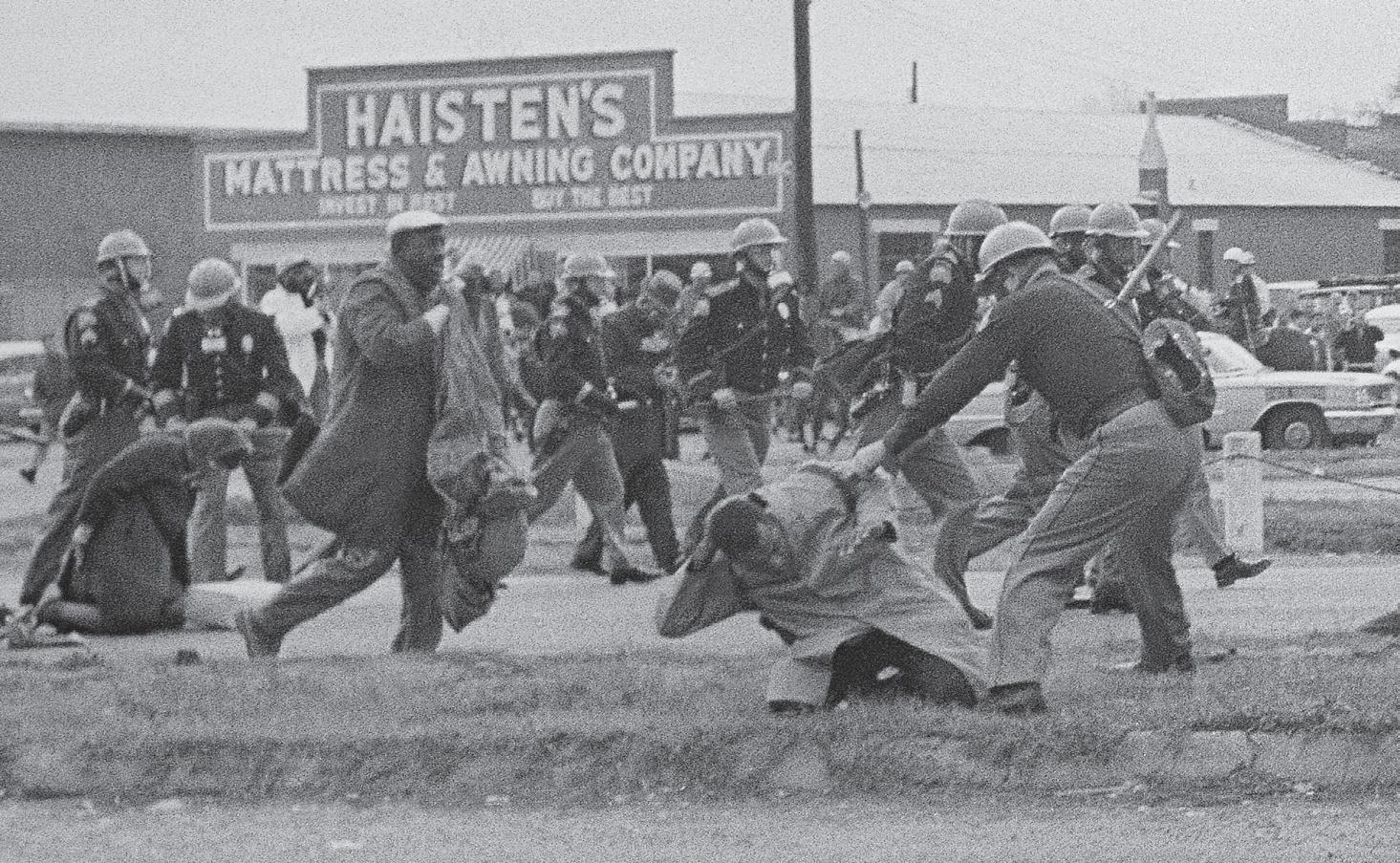
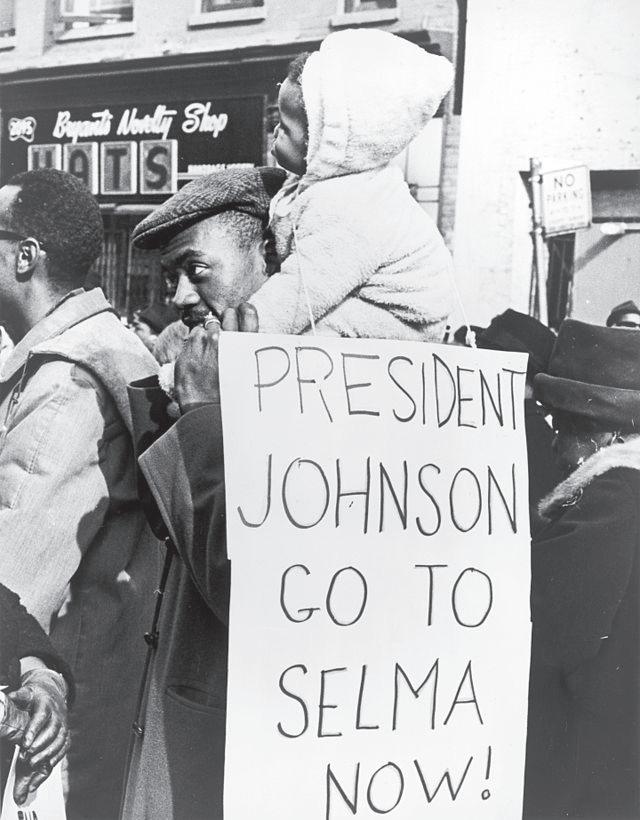
resistance to change. The events of "Bloody Sunday," where peaceful marchers were attacked on the Edmund Pettus Bridge in Selma, Al., galvanized public opinion and led to the passage of the Act.
The VRA targeted laws and regulations that had been used to prevent Blacks from voting, including literacy tests and poll taxes. It gave the federal government the power to oversee voter registration and elections in areas with a history of voter suppression. The Act also included provisions for federal examiners to register voters directly and ensure that changes to voting laws in certain jurisdictions could not be implemented without federal approval.
This legislation had a profound impact on American democracy. It significantly increased voter registration and participation among Blacks and other marginalized groups even as the law was almost immediately challenged. Just four years after the VRA was passed, the Supreme Court, ruled 7-2 in favor of the plaintiffs in Allen v. State Bd. of Elections and held that all changes to election rules in covered jurisdictions, no matter how small, were covered by Section 5 of the Voting Rights Act.
The reason this decision was so important was that it made it clear that Section 5 was intended to preclude any new voting laws or procedures from either limiting or denying the right to vote on the basis of race. The VRA is widely credited with reshaping the political landscape of the United States, leading to greater representation and advancing civil rights. Research from Oxford University shows that racial representation in local governments was significantly impacted by the Voting Rights Act, and that this greater participation resulted in noticeable improvements to Black communities' quality of life.
According to data from the NAACP and the U.S. Census, between 1962 and 1980, the number of Black elected officials in local governments throughout the South increased significantly. Research indicates that in 1962 there were fewer than 1,500 Blacks appointed to local government positions. By 1980, there were 6,440 Black elected officials. Spending on public infrastructure throughout Black neighborhoods increased, too. In 1962, public infrastructure spending in Black neighborhoods throughout the South averaged $1,000 per capita. By 1980, public infrastructure spending increased to $2,000 per capita. (*These figures are not adjusted for inflation.)
“I think the two guiding stars are Thornburg v. Gingles from 1986 and then Allen v. Milligan from 2023,” said Bryan Sells, a former special litigation counsel in the See story on next page
State troopers swing billy clubs to break up a civil rights voting march in Selma, Ala., March 7, 1965. John Lewis, chairman of the Student Nonviolent Coordinating Committee (in the foreground) is being beaten by a state trooper. Lewis, a future U.S. Congressman sustained a fractured skull. (AP Photo)
Marchers carrying a banner "We march with Selma!" in Harlem, New York City, New York. (Photo by Stanley Wolfson, New York World Telegram & Sun)
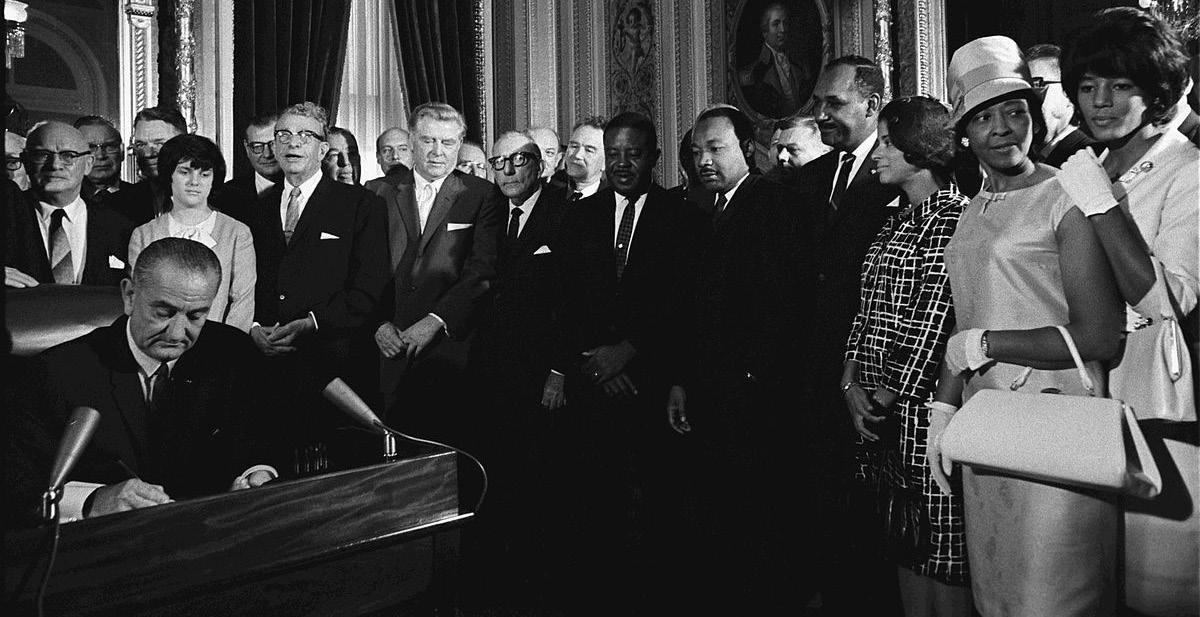
voting section of the Civil Rights Division at the United States Department of Justice and currently in private practice in Atlanta, focusing on election law, voting rights and redistricting. “Both of which were forceful reaffirmations of Congress' power to pass the Voting Rights Act to remedy generations worth of voting discrimination in America.”
“One of the things that you often hear in the media these days, some commentators say that racial discrimination in voting is a thing of the past. It's over. It has been completely fixed and perhaps replaced with political discrimination in voting,” Sells said.
“Which may or may not be illegal, but people say it's just natural that Black voters would vote for Democrats and white voters would vote for Republicans. And I want to say, as forcefully as I can, that there's nothing natural about that.”
“The VRA was needed in 1965 because of systematic, widespread voting discrimination against Black Americans in some parts of the country,” said Hans von Spakovsky, a lawyer and former member of the Federal Election Commission nominated by George W. Bush who is a senior legal fellow at the conservative Heritage Foundation.
“Today, such discrimination is extremely rare, and when it does happen, Section 2 of the VRA is a powerful tool to remedy it.”
“I'm not privy to their internal conversations, obviously, but what you can tell as an external observer is that they [the Trump administration] are retreating from enforcing the Voting Rights Act as Congress intended,” Sells said. With regard to the VRA, the Trump administration's activities raise concerns about the possible harm to voter access and the implementation of safeguards against racial discrimination in elections. Such as reduced enforcement, dismissed cases, executive orders, and a new found focus on voter fraud.
“They have dismissed some or almost all of their existing litigation against or litigation to enforce the Voting Rights Act and frankly they don't seem to be enforcing other provisions, statutory provisions that Congress has charged this department with enforcing, such as the Help America Vote Act, the National Voter Registration Act, the Move Act and so on. They simply seem to be doing little to nothing at the present time.”
Challenges and changes: The gutting of Sections 4 and 5
Despite its successes, the VRA has faced mounting challenges in recent years. One of the most significant setbacks came in 2013, when the Supreme Court struck down several provisions of the VRA in its Shelby County v. Holder ruling.
failure to take into account current conditions. This decision effectively gutted Sections 4 and 5 of the act, which had provided the framework for preclearance, an approval from the Justice Department or federal courts for changes to voting laws, processes and districts.
Justice Ruth Bader Ginsburg contended in her dissent in the case that regional protections under the VRA were still required. She also maintained that bills like the VRA are to be supported by Congress. She also highlighted that the decision to undercut the VRA and the continued consequences of racial voter suppression is a threat to democracy. The court also enabled some states to implement restrictive voting rules without having to worry about legal ramifications.
“Legislative efforts to revamp the preclearance coverage formula have been percolating since the immediate aftermath of the Shelby County decision in 2013,” said John Powers, a professor at American University Washington College of Law and former counsel to the assistant attorney general for the Civil Rights Division of the U.S. Department of Justice.
erage formula relied on data and criteria dating back to the 1960s.”
According to von Spakovsky, the Supreme Court addressed Section 5 appropriately.
“Section 5 was correctly and properly dealt with by the court,” he said. “Section 5 was intended as a temporary provision that only applied to a small number of states where the worst discrimination was occurring. The very same coverage formula to determine what states were covered was based on 40-year-old data, and Congress never removed it to update the formula based on current registration and turnout data…. There was no justifiable reason for them to remain subject to special coverage.”
Joshua A. Douglas, attorney, author and professor at the Rosenberg School of Law at the University of Kentucky, shared his insights on the legal aspects of voting rights.
Sells contends that restoring the power that people once had at the polls is necessary, but it is difficult to advocate for without any legislative support.
In particular, the court determined that Section 4(b) of the VRA, which defined states with a history of racial discrimination, was unconstitutional due to the law’s
“For over a decade, various legislators in Congress have proposed the John Lewis Voting Rights Advancement Act. The John Lewis act includes a revamped coverage formula based on updated criteria such as evidence of recent voting rights violations, which would answer the Supreme Court’s call to create a coverage formula that is based on current conditions. The old cov-
“Support for the Voting Rights Act used to be bipartisan,” Powers noted. “The 2006 reauthorization of Section 5 was passed by an overwhelming margin — for example, the Senate voted unanimously (98-0) to reauthorize the act. A return to the bipartisan consensus that protecting minority voting rights is an important goal would be an important step.”
Douglas believes the Supreme Court’s actions were questionable, at best.
“On Section 2, which applies nationwide and prohibits voting rules that have a discriminatory effect, the court in the 2021 Brnovich ruling created five ‘guideposts’
Continued from page 14 See VOTING RIGHTS on page 16
Lyndon Johnson signs Voting Rights Act of 1965. (White House photo)
Voting rights
Continued from page 15
for plaintiffs to satisfy to bring a successful claim that make it very difficult for plaintiffs to win. These ‘guideposts’ are nowhere
a good idea — but of course that would be subject to Supreme Court overview. We also need stronger constitutional protection for the right to vote,” Douglas said
The Supreme Court decision removed a critical tool for combating voter suppression and allowed states and localities to
is expanding at the fastest rate in regions of the nation that were formerly protected by Section 5 of the VRA.
According to Clayton, a multiracial democracy is the reason why Obama was elected president 17 years ago. However, he also noted that the Tea Party movement
ed discriminatory policies, such as voter ID. Furthermore, the bill would reinstate Section 2 of the VRA in response to the Brnovich ruling, guaranteeing that voters have the right to contest voting discrimination in court.
Von Spakovsky argues that since every-
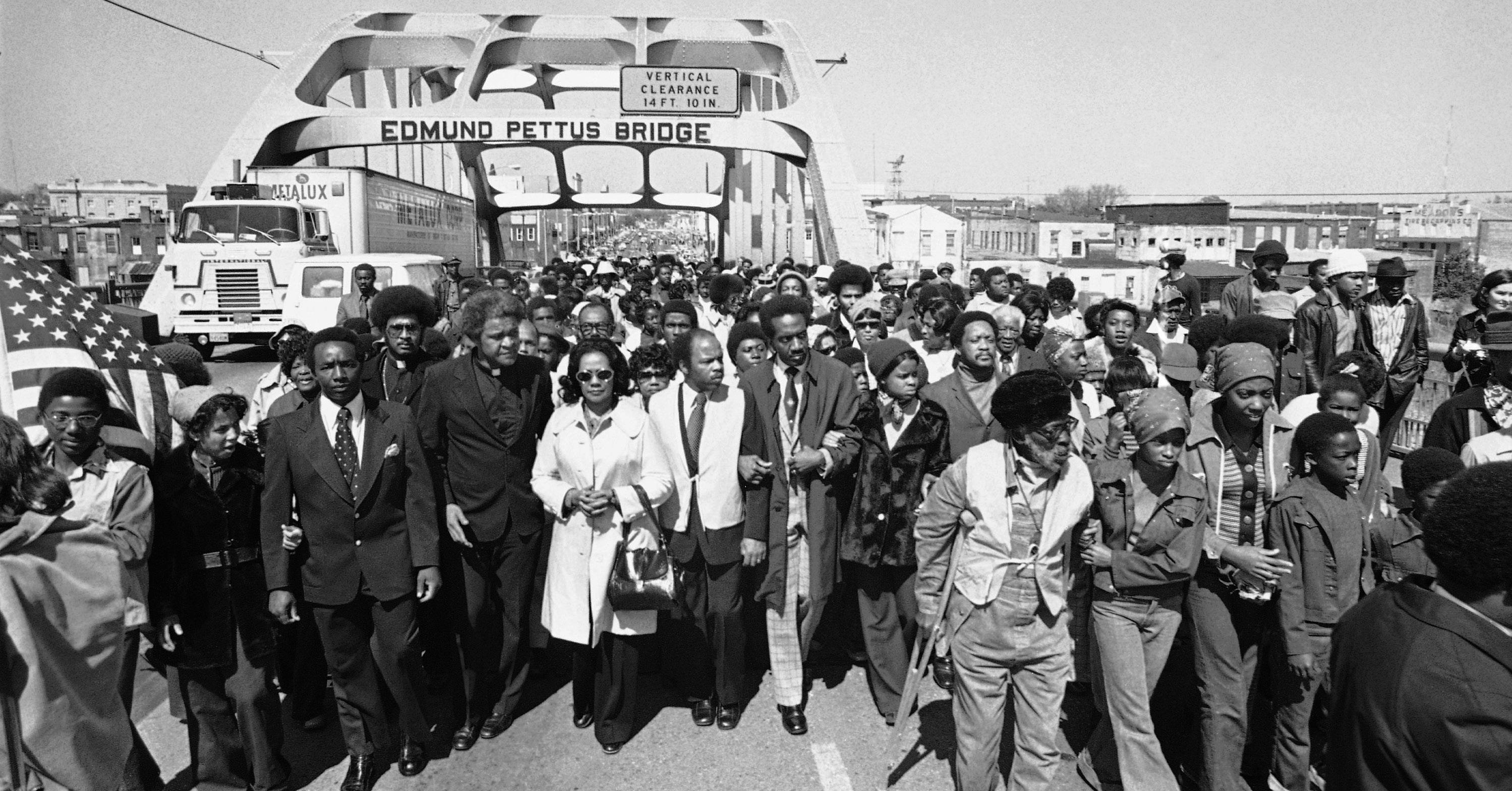
in the statute… the court basically made up the law. And each guidepost makes it harder for plaintiffs.”
Powers feels that both parts of the VRA have been twisted by the Supreme Court to suit its interests, allowing a voter to be turned away from the polls virtually instantly with no repercussions for the election board.
Past is prologue
Historically, the U.S. DOJ has been the primary enforcement agency for Section 203 of the VRA, which offers safeguards for non-English speakers in counties with significant populations of linguistic minority voters. In recent years, the statute's enforcement has decreased. The VRA's Section 2 is still relevant in “vote dilution” instances, involving challenges to at-large voting systems and redistricting plans.
The core issue of these cases, according to Douglas, is extreme deference to the states regarding the manner in which they hold their elections.
“The court should more robustly protect voters, not states, in the election process. Congress could theoretically enact an update to the VRA — which would also be
implement changes to voting laws without federal approval. Since the Shelby County decision, there has been a notable increase in the enactment of restrictive voting laws, particularly in states with histories of discrimination according to the Brennan Center for Justice.
Dr. Dewey Clayton, a political science professor at the University of Louisville and author of “The Presidential Campaign of Barack Obama,” emphasized the importance of continued advocacy.
“The [voting turnout] gap between Blacks and whites essentially was eliminated, but once Shelby County came into place in 2013, then that gap began to widen,” Clayton said. “It widened in the election in 2016, (Hillary Clinton vs. Donald Trump) and it widened even further in the election in 2020.”
After the civil rights movement, the Black and white American voter turnout disparity narrowed. Data provided by the Brennan Center for Justice revealed that this tendency had been reversing for more than 10 years. A crucial indicator of equality in participation is the racial turnout gap between white and non-white voters. This trend has been steadily increasing since 2012, and it
gained momentum in the years following Obama's historic presidential victory. Clayton believes that the party predicated on the fundamentals of conservative Christians to eagerly "turn the clock back" and undermine multiracial democracy.
“I think it was 1994 … once the Republicans began to have a majority in Congress, they began to wield their power,” Clayton said. “The president began to nominate Supreme Court justices that were much more conservative than they had [ever] been. And as you well know, now we have a 6-3 conservative majority, obviously in court, they have ruled on several cases lately.”
But despite the VRA being a landmark law, Clayton cautioned that its legacy is in jeopardy. By enhancing legal safeguards against discriminatory voting practices, the John Lewis Act — named after the late congressman and civil rights activist — would update and revive the VRA.
First, by establishing a new framework to identify whether areas with a history of voting discrimination are subject to preclearance, the bill would reinstate what the Supreme Court had invalidated in Shelby County. Additionally, it would impose a preclearance requirement on other repeat-
thing is fine, nothing needs to be changed.
“There is no reason for a new Section 5 as proven by record registration and turnout rates, and Section 2 remains a permanent, nationwide tool that can be used in the rare cases where discrimination occurs,” he said.
Pamela S. Karlan was the U.S. deputy assistant attorney general for Voting Rights in the DOJ's Civil Rights Division and is currently a professor at Stanford Law School.
“There's absolutely no chance under current law that we're going to see a revamped Section 5 of the Voting Rights Act,” Karlan said. “The important thing is that the right to vote is absolutely critical because it's what preserves all of our other rights. The idea that we don't have a national commitment to ensuring that every citizen who's eligible to vote can register, cast a ballot and have that ballot counted is a real problem.”
This article is part of a collaboration with the Associated Press, the New York Amsterdam News and Black News & Views. The work is part of the AP Inclusive Journalism Initiative supported by the Sony Foundation.
Aided by Father James Robinson, Mrs. Coretta Scott King, widow of Dr. Martin Luther King, Jr., center, and John Lewis of the Voter Education Project, a crowd estimated by police at 5,000, march across the Edmund Pettus Bridge from Selma, Alabama Saturday, March 8, 1975. (AP Photo)
Protecting and strengthening the legacy of the Voting Rights Act, Part Two

By JASON GONZALEZ Special the the AmNews
As we approach the 60th anniversary of the passage of the Voting Rights Act (VRA) the bill’s legacy continues to influence voting rights debates even as new challenges have emerged.
In recent years, there has been a concerted effort to restrict voting access in various states. These measures include stringent voter ID laws, reductions in early voting, purging of voter rolls, and limitations on absentee voting. Critics argue that these laws disproportionately affect minority communities and are reminiscent of the discrimination the VRA sought to eliminate.
Kareem Crayton, vice president of the Brennan Center’s Washington, D.C., office, weighed in on these developments. Crayton explained that one urgent issue that requires attention is the erosion of voting rights. To guarantee that every person can take part in the political process without fear or obstruction, he feels that substantial reforms are imperative.
“What concerns me is that we have increasingly ‘blessed decision-making’ that fences out communities of color, under
guise of law,” Crayton said. “The question everybody needs to think carefully about is what you’re willing to do to defend that, because it’s not gonna just defend itself. We have the right to vote, but we have it only in so much as we’re able to use it, and ... outcomes in politics depends upon who shows up.”
Cedric Merlin Powell, a professor and constitutional law and critical race theory expert at the University of Louisville, underlined that the courts are essential to maintaining the VRA tenets. He believes that activists must push for court rulings that safeguard and increase voting rights, particularly for underserved populations. To encourage more judicial decisions that protect voters at the polls, he said, activists are employing a multifaceted strategy.
“Conservative justices view discrimination in neutral and post-racial terms, so, while they are amenable to acknowledging discrimination that is so blatantly intentional that it can be persuasively proven, they will not acknowledge structural inequality and systemic racism,” Powell said.
“At best, this is irremediable ‘societal discrimination.’ At worst, there is no discrimination because it has been eradicated.
Moreover, the court is receptive to reverse discrimination claims advanced by whites, such as in the Students for Fair Admissions decision overturning affirmative action.”
Working with and supporting voters
With a 6-3 conservative supermajority, it is difficult for the liberal justices to counterbalance the current court’s aggressiveness. Shelby County v. Holder is one such example of when this happened.
“Justice [Ruth Bader] Ginsburg offered a scathing critique and analysis of the court’s overturning of the preclearance formula in the Voting Rights Act, freeing covered jurisdictions from federal supervision and clearing the way for states to gerrymander districts so that power is entrenched and Black voting strength is diluted,” Powell said. “She famously noted that ending preclearance was like ‘throwing away your umbrella in a rainstorm because you are not getting wet.’”
Pamela S. Karlan, a former principal deputy assistant attorney general in the Civil Rights Division of the US DOJ and professor at Stanford Law School, thinks the Supreme Court made a mistake in Shelby County v. Holder and in Brnovich.
However, she believes the Allen v. Milligan decision was correct.
“... in Brnovich, I think they had an unusually narrow and an improperly narrow view of what the Voting Rights Act was intended to accomplish,” Karlan said. “In
Shelby County, I think the court was mistaken in thinking that they didn’t have the power to extend the Section 5 regime for another 25 years, given the evidence that was in front of it.”
Powell believes that preclearance must be restored by Congress, in addition to other steps to make voting easy, accessible and meaningful — the goals of the John Lewis Voting Rights Act — in order for the bill to return to its full strength and capacity.
“Voting is the cornerstone of our democracy; the act of voting resonates because it is the voice of the community expressing its wishes to their representatives, and it is how democracy is actualized through the will of the people,” Powell said. “Voting gives voice to the political community.”
New York Sen. Charles (Chuck) Schumer, minority leader of the Senate, recognizes the challenges facing the VRA bill.
“This year marks 60 years since the
President Joe Biden crosses the Edmund Pettus Bridge with civil rights leaders to commemorate the 58th anniversary of Bloody Sunday on Sunday, March 5, 2023, in Selma, Alabama. (Photo via The White House)
Compensation
passage of the Voting Rights Act, one of the most significant pieces of civil rights legislation in our nation’s history. Sadly, it’s been more than a decade since the Supreme Court gutted critical provisions of that law, that previously prevented states with a history of discrimination from changing their voting rules without preapproval from the Department of Justice,” Schumer said in a statement to the Amsterdam News.
“Since the Supreme Court’s 2013 decision in Shelby County v. Holder, states across the country have passed unjustified and damaging laws that impede voting and that disproportionately limit access to the ballot for Black voters and marginalized communities” Schumer said. “Denying any eligible American citizen access to the ballot cuts against the heart of our democracy — the right to vote. Democrats will continue to heed the words and values of our late colleague, John Lewis, and work tirelessly to safeguard the right to vote.”
Ongoing attacks on voting rights
Perry Grossman, director of the New York Civil Liberties Union’s voting rights litigation, thinks the present administration is the worst by far as it pertains to voting rights.
“Congress and the Supreme Court are failing, and the president is being actively hostile to the voting rights of people of color, so the fight always goes on, even in the face of a hostile administration,” Grossman said.
One of the most prominent executive orders the Trump administration has issued, according to Grossman, is requiring documentary evidence of citizenship when completing a federal voter registration form.
Grossman said documented evidence of citizenship isn’t just superfluous for maintaining the integrity of the voting process; it is obviously intended to deny the right to vote to people of color, those with low incomes, the elderly, and those who are just less likely to possess those federal documents.
“Documented proof of citizenship, such as passports, [is] costly, and many Americans lack them,” Grossman said. “Congress has to act to renew those protections, to expand those protections, to push back on what the Supreme Court has done, but I’m encouraged by the states that have taken it upon themselves to innovate their Congress, and the U.S. Supreme Court have fallen short. … the passage of the John R. Lewis Voting Rights Act of New York (June 2022), I think, is a monumental achievement in its own right.”
According to Gonzalo Duran, old problems are resurfacing. The Bronx-born politician is the Republican candidate for Public Advocate in New York City. His appreciation for the significance of the VRA
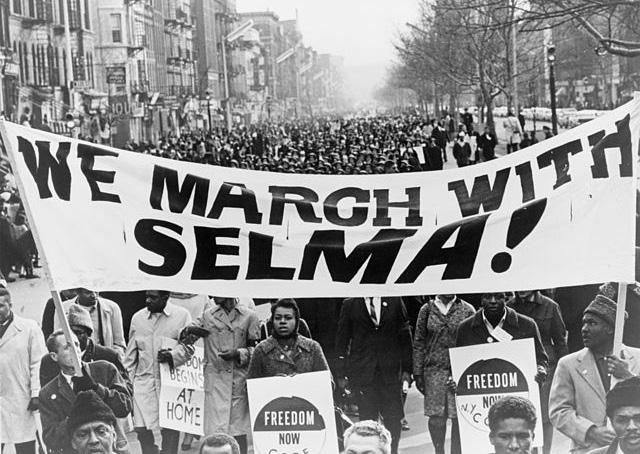
has grown, since it changed not only who is eligible to vote, but also how the nation defines equality, justice, and freedom. He believes that the current structure that New York State has put in place to be a positive one.
“In New York City, we’ve continued to expand access. Today, we provide ballots and interpreters in, I believe, 12 languages at every polling site,” said Duran, the vice chairman of the Bronx Conservative Party.
“Voters are allowed to bring their own interpreters, and there are outreach efforts in densely populated minority communities to ensure that every voice is heard. This is the spirit of democracy in action.”
A new dawn: The John R. Lewis Voting Rights Advancement Act
The John R. Lewis Voting Rights Advancement Act has been put forth as a solution to recover the protections lost through court rulings. This proposed legislation, championed by Democrats, is seen as a revival of voting rights, not just new laws.
“The John Lewis bill is unnecessary, unjustified, and dangerous,” said Hans von Spakovsky, a lawyer and former member of the Federal Election Commission who has always been a harsh critic of the Obama administration. “It would give the Justice Department — and therefore the party that controls the White House — extraordinary power and authority over state and local election rules, laws, and administration, giving the party in power the ability to
try to manipulate elections to ensure they remain in power.”
Von Spakovsky cited this as the primary reason why the John Lewis Voting Rights Advancement Act hasn’t gained national support. To guarantee that every election is fair, von Spakovsky would like to see a system called the Election Integrity Scorecard implemented in all future elections.
Despite the claims of the Heritage Foundation, many election experts, including the Brookings Institution and the Brennan Center for Justice, have found that election fraud is extremely rare and that efforts to “secure the vote” often do more harm by deterring qualified voters from exercising the franchise.
Terrycina Andrea (Terri) Sewell has represented Alabama’s 7th Congressional District as a U.S. representative for the past 14 years. Her district encompasses most of the Black Belt, including the primarily Black areas of Montgomery, Tuscaloosa, and Birmingham.
Sewell was the driving force behind the John Lewis Voting Rights Advancement Act campaign, sponsoring the legislation.
In Sewell’s opinion, revisiting previous battles is essential to carrying on the “good fight.”
“Sadly, so much of that progress is under attack. Old battles have indeed become new again. Last year alone, lawmakers in at least 40 states considered 317 bills to make it harder for Americans to vote,” Sewell said. “Meanwhile, here in Congress, Re-
publicans are pushing a massive voter suppression bill that would disenfranchise millions of eligible voters, including married women, military personnel, and those living in tribal communities.”
Sewell also said bipartisanship is necessary for the act to succeed.
“Voting rights should not be a partisan issue, and for decades, it was not,” Sewell said. “Since it passed in 1965, the Voting Rights Act was reauthorized five times by Democratic and Republican presidents, most recently in 2006 by President George W. Bush. Yet today, not a single House Republican will support our bill to restore its full protections, perhaps because Republicans have discovered that making it harder for certain communities to vote makes it easier for them to win.”
Karlan agrees and thinks it’s possible to do it again.
“In most states, voting is run by nonpartisan election officials,” she said. “Ultimately, at the county level, the people who are running the elections are not partisans, or if they’re partisans, they’re still professionals.”
Purging the rolls and history
According to Leah Litman, co-host of the “Strict Scrutiny” podcast with Melissa Murray, author of the book “Lawless,” expert on Project 2025, lawyer, and professor of law at the University of Michigan Law School, “Voting purges are where states
See story on next page
The civil rights march from Selma to Montgomery, Alabama in 1965. Participants in the civil rights march sitting on a wall resting, one holds a placard which reads, "We march together, Catholics, Jews, Protestant, for dignity and brotherhood of all men under God, Now!" (Library of Congress photo)
remove people from the eligible voter rolls — such that if and when the voter goes to vote, they would find that they’re not actually registered to do so, and therefore can’t vote until they’re registered.”
“As that description suggests, voting purges are especially consequential in states that restrict voter registration — i.e., if they don’t allow same-day voter registration, because often what happens is someone goes to vote but doesn’t realize they’re not registered, and if they can’t register then, they might not be able to vote at all … different states have different rules — yes, voting purge systems do vary state by state,” Litman said.
She emphasized the need for preparedness.
Individual voting rights have once again been restricted by recent court rulings and state-level suppression tactics, leaving many citizens with antiquated registration procedures, complicated identification requirements, and quickly evolving regulations, she said.
“[Project 2025 will make things] way worse! They want to basically use the DOJ to gin up baseless fears about voter fraud — and make it harder for states to protect voting. And they would decline to enforce the VRA in cases where states or localities adopt policies that disproportionately negatively affect racial minorities and language minorities,” Litman said.
In response, Powers added his own metric and reaffirmed Litman’s argument.
“The changes to the mission of the U.S. Department of Justice’s Voting Section, the orders forcing the section to dismiss all of its current cases, and the decimation of the section’s career staff [are] deeply concerning for the future of voting rights,” Powers said. “The career employees of the Voting Section are critical to ensuring continuity of federal enforcement in the voting rights space.”
A revised and updated Section 4 of the VRA is the best option, Litman said, because it would pave the way for a new benchmark.
“A revamped Section 4 would create a new standard for determining which states and localities are subject to preclearance,” she said. “Congress could choose a new formula, or it could just list the jurisdictions it wanted subject to the law. It doesn’t actually have to do anything to Section 5 — at least, the court didn’t say it did. It’s possible, of course, that the Supreme Court would come back and say ‘Well, actually, you just can’t have any kind of preclearance.’ It can be materialized with the political will — if Democrats can be convinced to abandon the filibuster to protect voting rights, or if Republicans can be convinced to protect voting rights. I think the former is more likely to happen.”
Litman agreed that when it comes to the way the Trump administration has handled voter rights, it’s the worst she has seen. Von Spakovsky of the Heritage Founda-
tion, on the other hand, challenges this idea.
“The current administration is performing well and undoing the damage done by the previous administration’s filing of unjustified, meritless lawsuits,” von Spakovsky said. “The best example of that is the lawsuits the Biden DOJ filed against Virginia and Alabama prior to the November election, claiming the states were prohibited from removing aliens from their voter rolls, despite the fact that it is a felony for an alien to register or vote. The current DOJ has dismissed those lawsuits.”
Reflecting on the past and shaping the future
“Our foremothers and forefathers were tacticians and strategists, and we should take a page from their playbook,” Rep. Sewell said, encouraging activists to look to history for inspiration.
“All across this nation, we need to organize, strategize, and mobilize our communities in support of voting rights,” Sewell continued. “And as John Lewis taught us, we need to get into some ‘good trouble.’ We may encounter roadblocks along the way, but we can never be deterred. Never did I think that 60 years after the brutality of ‘Bloody Sunday,’ I would be carrying a bill to restore the full protections of the Voting Rights Act. It goes to show that progress is elusive, and every generation must fight to hold onto the progress of the past, lest we lose it.”
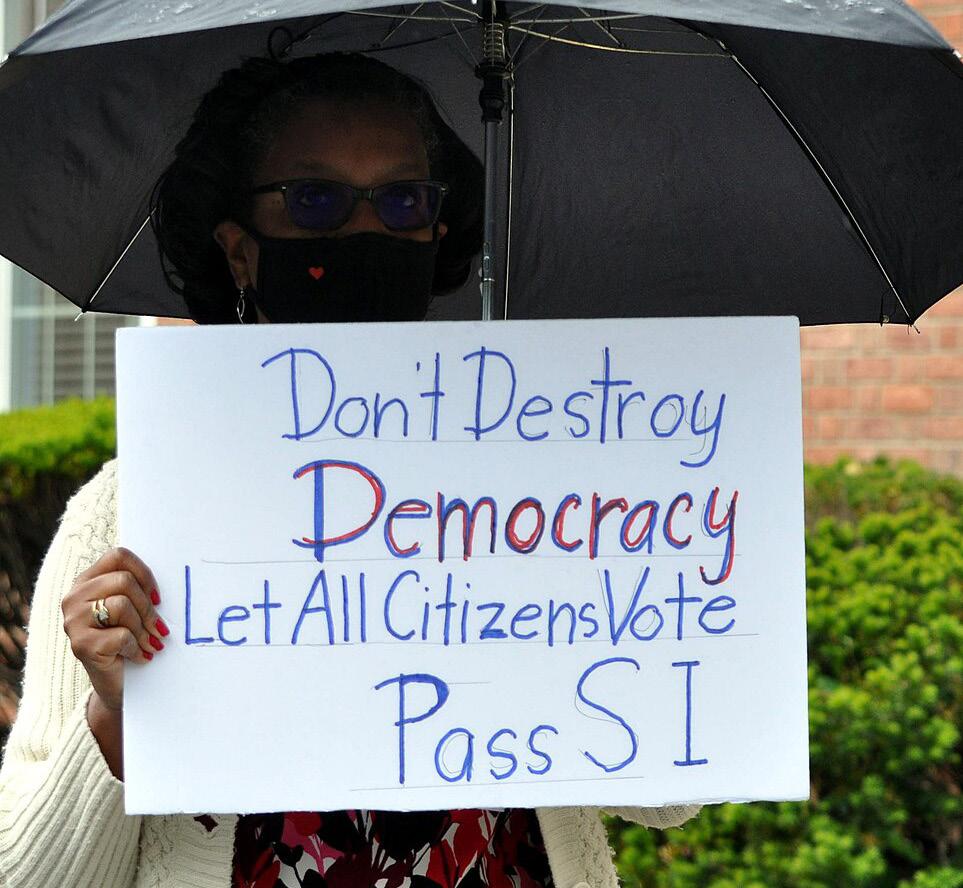
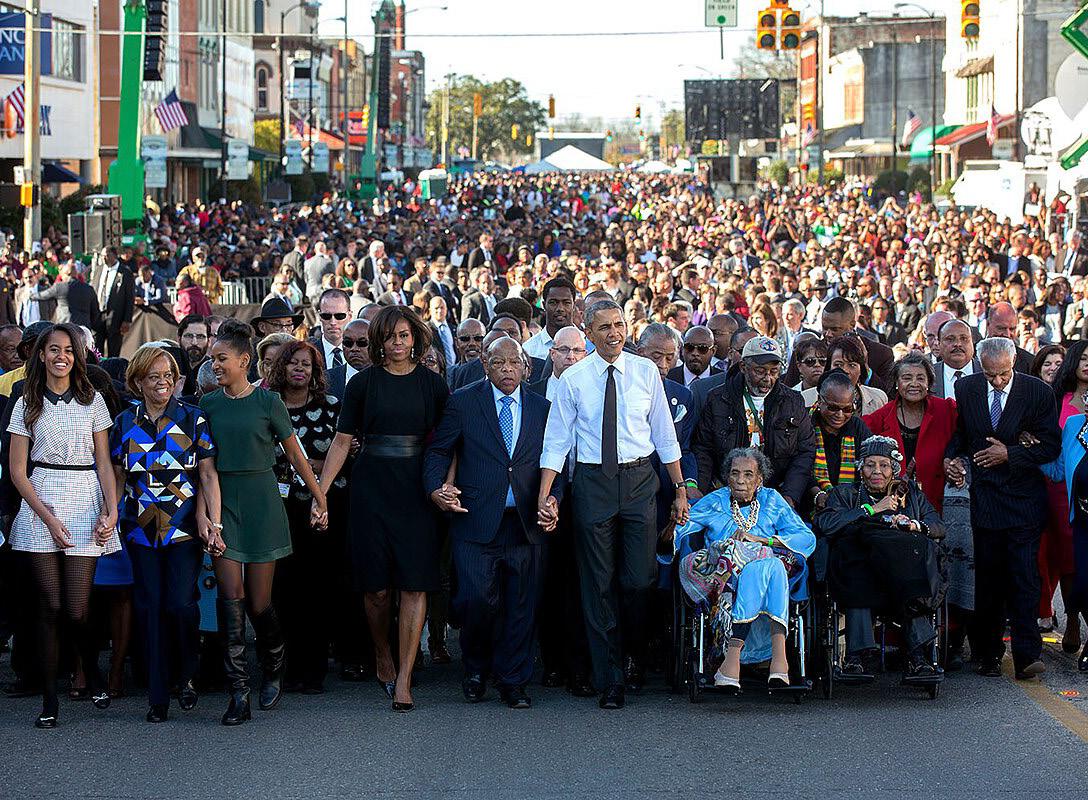
This article is part of a collaboration with the Associated Press, the New York Amsterdam News, and Black News & Views. The work is part of the AP Inclusive Journalism Initiative, supported by the Sony Foundation.
This official White House photograph the President, the First Family, or the White House. (Lawrence Jackson photo)
Rally for Voting Rights. (Edward Kimmel photo via Wikimedia)
Caribbean Update
Caricom heads to British final court for opinion on slavery, reparations
By BERT WILKINSON Special to the AmNews
Caribbean Community (Caricom) nations, led by Jamaica, are tweaking their approach to demands for reparations for the Transatlantic Slave Trade by moving to ask Britain’s final court whether it thinks slavery was lawful.
Recently, Jamaica’s cabinet decided to take a different approach to the issue by heading straight to Britain’s highest court, asking it for a definitive ruling about whether slavery and the forced transport of people from Africa was a lawful act and/ or a crime against humanity.
Culture Minister Olivia Grange first announced the new tactic during parliamentary debates and, from all indications, the remaining nations in the 15-member bloc and associates — like Bermuda and the Cayman Islands — have all signed on to the initiative.
Jamaica also took the issue to last week’s regional leaders’ summit and received unanimous support for the measure. The leaders had been in Jamaica for their main summit, where a series of issues, including the fight for reparations, were discussed.
“I’m pleased to report that there was broad support for Jamaica moving for-
ward with a petition to King Charles III, in his capacity as Jamaica’s Head of State, to seek a formal ruling from the Privy Council on whether the Atlantic enslavement of Africans was lawful under common law and whether local laws supporting it were invalid,” according to Caricom chair and Prime Minister of Jamaica Dr. Andrew Holness.
Holness also said that the umbrella Caribbean Reparations Commission (CRC) has a similar legal initiative linked to broader development issues. “Both strategies reinforce each other, and it was agreed therefore that Jamaica could move forward. Through the use of this legal route to challenge the historical legality of slavery and assert claims for reparation, this petition will mark a watershed moment for Caricom and the broader global movement for reparatory justice,” he said.
The announcement has come when the effort by the region to get former European slave trading nations to even listen to regional pleas and requests to commence talks about reparations appeared to have been flagging in recent months, but Holness said things are about to change.
Grange argued that Jamaica is using the authority of the king, who has the power to take issues of prime importance to the British Privy Council for rulings. King Charles is
still the island nation’s head of state because Jamaica is not yet a republic, so the cabinet has decided to capitalize on this route to win an opinion for the country’s appellate court.
“We are taking our demand for reparations from the United Kingdom for the enslavement of our African ancestors into another phase,” Grange said. This is a legal approach that does not, in any way, conflict with the political approach as posited through negotiation, suggesting that Britain is “under an obligation to provide a remedy to Jamaica,” not only for slavery but for what she termed as slavery’s “enduring consequences” as well.
Regional leaders have tried an array of ideas to get Europe to listen and engage, even sending demand payment letters, most of which have gone unanswered; hiring a British law firm to research the case and pronounce on its merits; asking for a summit with Europe to discuss slavery and its consequences; and working on research to bolster their case.
So far, the Dutch government has issued two formal apologies for its role in the slave trade and has left the door open for talks on reparations. Britain, on the other hand, through then Prince Charles, has spoken about remorse but has so far flatly refused to discuss payments in any form for slavery.

One big mess: Immigrants are being scapegoated again

FELICIA PERSAUD
Let’s call it what it is: a mess — one big, ugly, scapegoating mess.
Donald Trump’s so-called “One Big Beautiful Act” (OBBA) is neither beautiful nor bold — it’s a calculated attack on immigrants, both legal and undocumented. Tucked inside the bloated budget act is a quiet punch to the gut for millions of hardworking families: a 1% federal tax on international remittances paid with cash, money orders, or cashier’s checks.
That means, starting January 2026, if you send money to support your mom in Jamaica, your cousin in Haiti, or your child in Mexico or anywhere else in the world, you’ll now have to pay Uncle Sam a little extra for the privilege of helping your loved ones survive.
This is the first federal remittance tax in U.S. history, and while it applies to all senders, we know exactly who this is meant to target: immigrants.
A war on immigrant dignity
The new rule is built on a fantasy: that migrants are some kind of economic drain, when in fact, they’re economic engines. Remittances from the U.S. help keep entire families afloat around the world. In 2023 alone, these funds pumped $656 billion into the Global South. That’s triple the amount of official development aid.
Why tax the poorest to fund border walls and detention centers?
Trump’s $170 billion immigration enforcement package isn’t just about walls; it’s a wall of bureaucracy, cruelty, and cost. Under the OBBA, asylum now comes with a $100 fee. The appeal of an immigration judge’s decision will cost $900. And kids in mixed-status families? Many will lose access to food stamps and health care.
Let’s be blunt: This is about making immigration harder, immigrants poorer, and treat-
The remittance tax, once floated as 5%, landed at 1%, but let’s be clear — even 1% will hurt. Especially when migrants already pay high fees to transfer funds, often more than double the global goal of 3%.
ment more punishing.
Four lies this law is built on
“This Will Stop Migration.”
Wrong. Most people don’t migrate just to send money — they migrate for survival, safety, opportunity. If anything, cutting off remittances may increase migration, not reduce it.
“Migrants Will Self-Deport.”
Also wrong. Migrants with families here, especially children who are U.S. citizens, are not going anywhere — even if they can’t send money. They’ll struggle, but they’ll stay.
“Everyone Will Pay the Tax.”
Not exactly. Many will pivot to informal channels — crypto, hand-carrying cash. etc. That makes transfers harder to trace and more dangerous.
“This Helps the U.S. Economy.”
Barely. The remittance tax is expected to raise $10 billion over 10 years — less than 0.1% of the bloated federal budget. Meanwhile, it punishes working people and slows economic demand.
We’re losing more than dollars
This isn’t just about money. This is about dig-
nity, family, and fairness. It’s about telling children of immigrants that they’re less worthy of health care. It’s about charging a desperate mother to plead for asylum. It’s about detaining kids and labeling it “family unity.”
It’s a mess. One big, calculated, xenophobic mess.
Instead of taxing remittances, why not harness their power? Matching grants, taxfree policies, and community investment programs have proven to multiply their benefits. Yet, this bill chooses punishment over partnership.
The irony? The same migrants this bill targets are the same ones caring for our elderly; building our homes; cleaning our offices; and planting, harvesting, and cooking our food.
The “Big Beautiful Bill” may be wrapped in flags and fear, but inside is a cruel, cynical assault on immigrant dignity — and on the American values we claim to defend.
Felicia J. Persaud is the publisher of NewsAmericasNow.com, a daily news outlet focused on positive news about Black immigrant communities from the Caribbean and Latin America.
The Honourable Olivia Grange, CD, MP, Jamaica’s Minister of Culture, Gender, Entertainment, and Sport. (Photo via opm. gov.jm)
Arts & Entertainment
Berkshires-based forum pays homage to civil rights leader and NAACP founder W.E.B. Du Bois
By MARIELLE ARGUEZA Special to the AmNews
In 1916 and again in 1933, W.E.B. Du Bois and Joel Elias Spingarn gathered thinkers and leaders in Amenia, New York at the Troutbeck estate. Later called the Amenia Conferences, the gatherings were not a means to an end. The purpose wasn’t to produce books or treatises. Instead, these meetings of the mind were intentional havens where intellectuals could be inspired by one another through conversation, debate, and proximity to the movers and shakers of the time.
While both Spingarn and Du Bois were both civil rights activists, educators, leaders and scholars, Du Bois’ legacy in the Berkshires is a constant source of inspiration for scholars in the area. This was the case in 2021, when long after his death, Tufts historians Dr. Kendra Taira Field, Dr. Kerri Greenidge, and Pulitzer-Prize-winning author David Levering Lewis (who literally wrote the book on Du Bois) founded the Du Bois Forum, a retreat for artists, writers, and other academics, to uplift each other’s work, connect with DuBois’ legacy, and engage in intellectual and artistic discourse.
“In the beginning, it was very much a labor of love,” said co-founder Kendra Field. The forum was a simple gathering of academics, writers and artists engaging in the tradition
of Black intellectualism forged by thinkers like Du Bois. But today, it’s an expansive weekend exploring the footsteps of Du Bois in the Berkshires.
The forum weekend begins Friday, July 18, with the fourth annual Du Bois Forum Roundtable and Celebration at Jacob’s Pillow in Becket, Massachusetts. The roundtable runs from 4 to 5 p.m. and will feature Secretary of the Smithsonian Lonnie Bunch, Thavolia Glymph of Duke University, Brandon Terry of Harvard, Nathan Connolly of Johns Hopkins, and Elizabeth Hinton of Yale, alongside Forum fellows. The program includes author signings and recognition of partner organizations. A performance by Red Clay Dance Company follows at 5:30 p.m., and the evening concludes with a ticketed dinner program from 7 to 9:30 p.m., which includes the forum’s 2025 awards ceremony. Honorees include Bunch, former Massachusetts Gov. Deval Patrick and Diane Patrick, and Embrace Boston Executive Director Imari Paris Jeffries.
On Saturday, July 19, the forum will host a free public event titled “W.E.B. Du Bois and the Black Berkshires,” a historical tour from 12:30 to 3 p.m. in Great Barrington, the luminary’s hometown. Stops include James Weldon Johnson’s writing cabin and the Clinton A.M.E. Zion Church, now home to the Du Bois Freedom Center. The tour
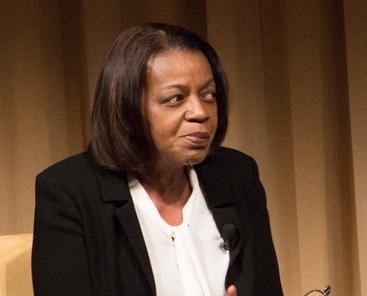
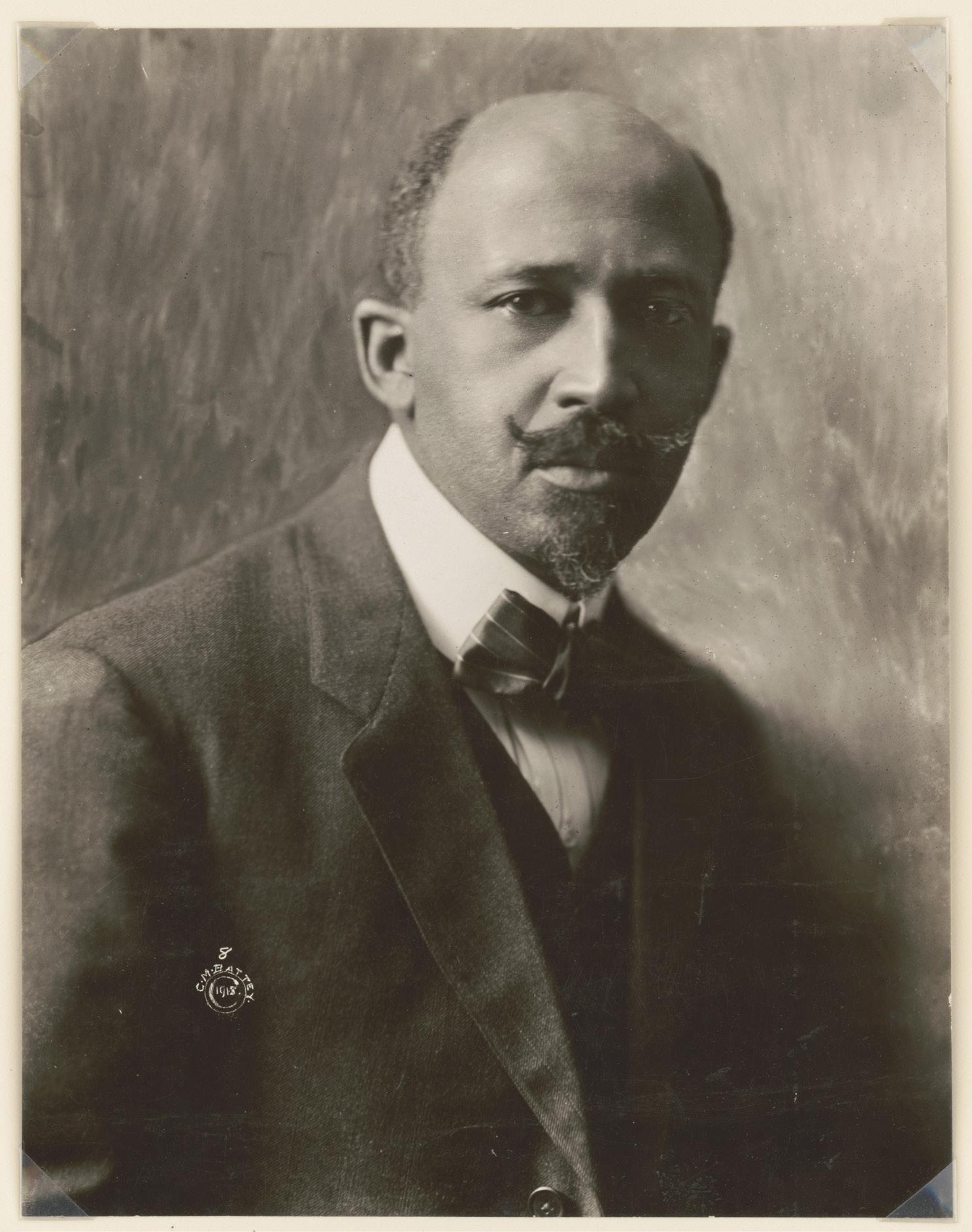
concludes at 2 p.m., with the unveiling of a statue of Du Bois outside the Mason Library. The sculpture, by artist Richard Blake, was commissioned by the W.E.B. Du Bois Sculpture Project. Remarks will be delivered by Deval Patrick and forum cofounder David Levering Lewis.
The weekend closes Sunday, July 20, with a panel discussion from 1 to 2 p.m. at Chesterwood in Stockbridge, Massachusetts. Titled “W.E.B. Du Bois: Scholar, Artist, and Architect of the Civil Rights Movement,” the panel will include Blake, artist Delano Burrowes, National Sculpture Society Executive Director Gwen Pier, and forum fellows Chad Williams and Frances Jones-Sneed. The event is free and open to the public.
The Du Bois Forum extends beyond its annual gatherings by offering a range of year-round programs that support writers, scholars, and artists. These initiatives include seasonal meetings, writing retreats, and workshops focused on professional development. Through these activities, the forum aims to cultivate a community dedicated to advancing African American history, culture, and scholarship while fostering new voices and collaborative creative work — the way Du Bois would’ve wanted it.
“Du Bois was way ahead of his time,” said Field. “He was always kind of moving with the times, and thinking about what the next challenge is.” For more info, visit duboisforum.com.
Thavolia Glymph (Public domain photo)
W.E.B. (William Edward Burghardt) Du Bois, 1919 (Library of Congress photo)
Why James Gunn’s ‘Superman’ soars: A hopeful reboot for a new era
By MAGRIRA
Special to the AmNews
Everyone knows Superman’s story — or at least thinks they do: The baby from Krypton, the Kansas farm, the secret identity, the cape. But what James Gunn’s “Superman” does so well is remind us why this story still matters, and why we still need it.
Gunn, now co-head of DC Studios, takes the character back to his roots while making him feel urgent and relevant.
The film is packed with big, crowd-pleasing moments, but also small ones — a rescued dog, a saved squirrel — that show the Man of Steel’s heart. David Corenswet’s Superman is earnest, awkward, and deeply kind. He’s the kind of hero who inspires people to stand up for each other, not just wait for him to save the day.
What’s remarkable about this reboot is how it honors Superman’s origins. Created in the 1930s by Jerry Siegel and Joe Shuster, two Jewish comic book creators who saw the world growing darker and more dangerous, Superman was always more than just a strongman in tights. He was a champion for the vulnerable; a symbol of hope against corruption, cruelty, and despair.
Gunn’s film doesn’t forget that. In fact, it leans into it.
Lex Luthor (Nicholas Hoult) isn’t just a mad scientist in this film — he’s a master manipula-

tor, spreading lies on TV that the public swallows whole. The villains aren’t just superpowered thugs; they’re also the forces of misinformation, fear, and authoritarianism.
Gunn draws clear parallels to our world, but never lets the film become a lecture. Instead, he keeps the focus on Superman’s compassion, courage, and refusal to give up on us, even when we disappoint him.
The introduction of the Justice Gang — Green Lantern, Metamorpho, Mister Terrific, and Hawkgirl — promises an exciting future for
the DC universe without overwhelming the story at hand.
The supporting cast is terrific. Rachel Brosnahan’s Lois Lane is sharp, unflappable, and doesn’t need saving. The Daily Planet newsroom feels alive and believable, with Wendell Pierce’s Perry White and Skyler Gisondo’s Jimmy Olsen adding warmth and humor.
The film’s commitment to diversity shines through and is one of the film’s clear strengths, especially in Pierce’s authoritative Perry White and Edi Gathegi’s compelling Michael Holt, aka Mister Terrific, a key member of the Justice

Savannah Lumar (Young Girl) further enhance the film’s inclusivity. These casting choices not only honor Superman’s legacy as a symbol for all people, but also reflect the world we live in today, making the story feel immediate and relevant.
Visually, the film is bright and inviting, a welcome shift from the gloom that’s weighed down recent superhero films. Gunn balances action and spectacle with genuine warmth and wit.
Yes, the PG-13 rating is deserved — there’s some salty language, scary villains, and one truly shocking execution, but the tone is ultimately hopeful.
Gang. Alongside them, Tinashe Kajese, Mary Chatmon, and Savannah Lumar contribute to a richly inclusive cast that reflects a modern, vibrant Metropolis.
Gathegi brings gravitas and intelligence to Holt, a metahuman superhero and core member of the Justice Gang. Pierce anchors the newsroom scenes with authority and warmth as White, editor-in-chief of The Daily Planet. Tinashe Kajese adds to the authenticity of the newsroom as Flo Crawley.
Supporting performances by Mary Chatmon (Loretto Bell) and
According to Variety, at the time of filing on July 14, 2025, “Superman” had already grossed an impressive $122 million domestically during its opening weekend, with an additional $95 million internationally, bringing its global total to $217 million. A strong opening, but the film reportedly cost $225 million to make, with roughly $100 million spent on promotion.
At its core, “Superman” is about the power of doing good, even when it’s hard. It’s about standing up to bullies, telling the truth, and believing in the best of people.
Gunn’s reboot is old-fashioned in the best possible way: It believes that heroism is for everyone, and hope is never out of style.
This is the “Superman” movie we needed — and maybe the one we deserve.
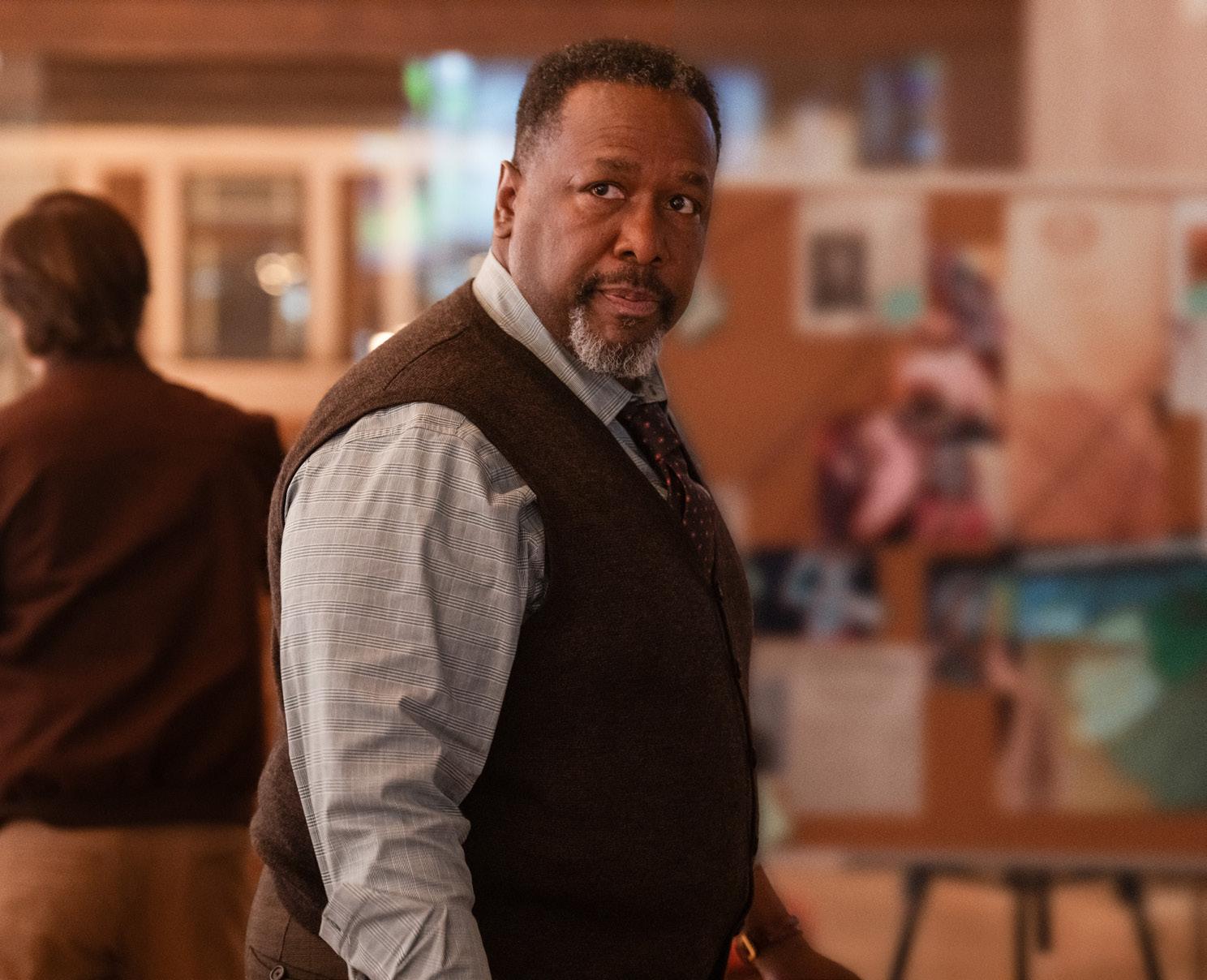
Edi Gathegi as Mister Terrific in DC Studios’ and Warner Bros. Pictures’ “Superman,” a Warner Bros. Pictures release. (Photo courtesy of Warner Bros. Pictures)
Wendell Pierce as Perry White in DC Studios’ and Warner Bros. Pictures’ “Superman,” a Warner Bros. Pictures release. (Jessica Miglio photo)
David Corenswet as Superman and Rachel Brosnahan as Lois Lane in DC Studios’ and Warner Bros. Pictures’ “Superman,” a Warner Bros. Pictures release. (Photo courtesy of Warner Bros. Pictures)
‘F1: The Movie’ has the fuel and formula for success
By DWIGHT BROWN NNPA News Wire
It’s a Tom Cruise kinda movie, but it stars Brad Pitt. He’s the protagonist in this tale about an aging, washed-up race car driver who everyone’s counted out, except for a dear friend and the driver himself: “If the last thing I ever do is drive that car, I will take that life, man, 1000 times.”
So, what are the Cruise/Pitt common denominators in this production? Director/screenwriter Joseph Kosinski also helmed “Top Gun: Maverick,” a $1.49B juggernaut, which broke a global total box office record for Cruise. That film’s producer Jerry Bruckheimer and screenwriter Ehren Kruger are onboard too. Together they evolve the “TG:M” formula: Add a worldwide movie star who’s never headlined a film that made that much bank. Toss in a multicultural cast, underdog challenges, lots of action and stir. Then create a big-budget extravaganza that should become a big-box-office summer movie.
After an accident in the 1990s, former Formula 1 racer Sonny Hayes (Pitt) keeps to himself, still driving and winning for various NASCAR teams, but his personal life is under the radar. The loner lives in a van and goes from place to place like a nomad. Things change the day his old buddy Ruben Cervantes (Javier Bardem) looks him up and begs him to join his floundering Formula 1 racing team, APX. “Begs” is an understatement. The day the wrinkled and weath-

ered Sonny shows up for onboarding, the rest of Ruben’s team is in shock. Especially his young, star driver Joshua Pearce (Damson Idris, “Farming”). Sparks fly between the cocky twentysomething and the older man. Other kinds of sparks fly between the team’s tech expert Kate (Kerry Condon, “Better Call Saul”) and Sonny. Can they all just box up their feelings and win a damn race?
It’s rare that a film’s score and playlist rivals the lead actors for the spotlight. But whether it was musical composer Hans Zimmer (“Dune: Part One”) or someone else, whoever wrangled the hits for this movie, was feeling it. Opening scenes get the party started with Led Zeppelin’s “Whole Lotta Love.” Lead vocalist Robert Plant screeches his heart out as Jimmy
Page shreds his lead guitar: “You need coolin’, Baby, I’m not foolin’. I’m gonna send ya, Back to schoolin.” In due time blues guitarist extraordinaire Gary Clark Jr. warns those who doubt him on the song “Bright Lights:” “You gonna know my name by the end of the night.” And if there are any questions left, Chris Stapleton sets everyone straight as he bellows over a groove-setting rhythm guitar and a whiny lead guitar: “I bet you thought you’d seen the last of me. I can’t change the way I am, you see. I think it’s my responsibility, to tell you I’m just as bad as I used to be!”
Those songs, with their lyrics, capsulize Sonny’s journey and attitude. There he is, in his 60s, trying to convince a crew half his age that he can lead them to a checkered flag win. He schools

‘em, demands respect and shows them how badass he can be. That spirit propels the movie forward as the rest of the characters follow him, albeit cautiously, wherever he leads them.
Kosinski uses Kruger’s screenplay to guide him as he creates a story that is compelling for 2h 35m, straight (editors Stephen Mirrione and Patrick J Smith). Scenes either have action, drama, laughter, flirtations, anger or fear. Rivalries are exacerbated, romance kindled, and teammates encouraged. Some sequences will surprise audiences as they expose the kind of foxy strategy race car drivers use to win, when winning may look like it will never happen. The machinations on view are as cunning and cutthroat as those of a pool shark.
Pitt works the Cruise-type persona like a champ. Smart mouthed, mature in areas where others aren’t. He flirts well and uses his megawatt smile to tame the masses. Idris makes a great counterpart, giving lip service as well as he gets it. With smirks that warrant responses, Joshua challenges: “When was the last time you won a race!?” Sonny, gives it back: “Same as you!” Both actors had experiences driving in cars reaching nearly 200mph, and it shows in their performances. Sara Niles (“Ted Lasso”) as Joshua’s mom has the right amount of strength and concern. Hard to believe that Kerry Condon is the same actor who played the crime-abetting girlfriend in “Better Call Saul.” She exhibits a nice blend of brainy nerd and woman in need of love.
The visuals help this $200M movie become all the action and verve a summer audience could want. Claudio Miranda’s (“Life of Pi”) clear and colorful cinematography captures the driver’s point of view, overhead big picture shots and the intimacy of ice baths too. Does the footage distinguish itself greatly from other recent car race films like “Gran Turismo” (2023), “Ferrari” (2023) or “Ford v Ferrari”? Not much. Except it might be slicker and feel bigger. Credit the dazzling production design by Ben Munro and Mark Tildesley and the contemporary costumes by Julian Day (“Bohemian Rhapsody”) for that assist. “F1: The Movie” has the formula for success. It’s got the fuel. Cruise must be smiling as Pitt takes the checkered flag.

(L-R) Damson Idris as Joshua Pearce and Brad Pitt as Sonny Hayes in Apple Original Films’ “F1® The Movie,” a Warner Bros. Pictures release.
(L-R) Sarah Niles as Bernadette and Damson Idris as Joshua Pearce in Apple Original Films’ “F1® The Movie,” a Warner Bros. Pictures release
(L-R) Samson Kayo as Cash, Sarah Niles as Bernadette, Javier Bardem as Ruben Cervantes and Abdul Salis as Dodge in Apple Original Films’ “F1® The Movie,” a Warner Bros. Pictures release. (Photos courtesy Warner Bros. Pictures / Apple Original Films)
Morgan Library and Belle da Costa Greene: A treasure trove presided over by a Black woman

By MICHAEL HENRY ADAMS
Special to the AmNews
A treasure house, the Morgan Library & Museum (225 Madison Avenue) is one of the greatest repositories of historic books, rare manuscripts, literary papers, and objets d’art anywhere. “It is for European and white American scholarship what the Schomburg Center is for Black culture,” says Harlem bibliophile Lana Turner.
As special as it is, looking quickly at the exterior, one might almost mistake the Morgan Library for one of the many local public libraries its architects, McKim, Mead & White, also designed in New York.
It was built for the colossally rich international banker, J. Pierpont Morgan, Sr., in the garden, next to his house, Meant to store his remarkable collection, in steel vaults and display objects in opulent rooms, it is an example of “quiet luxury,” that is not always entirely discernible on first glance. For example, the structure was made using a painstaking and costly ancient Greek technique. Massive marble blocks were cut so exactingly that the masonry fits together, forming solid walls, without
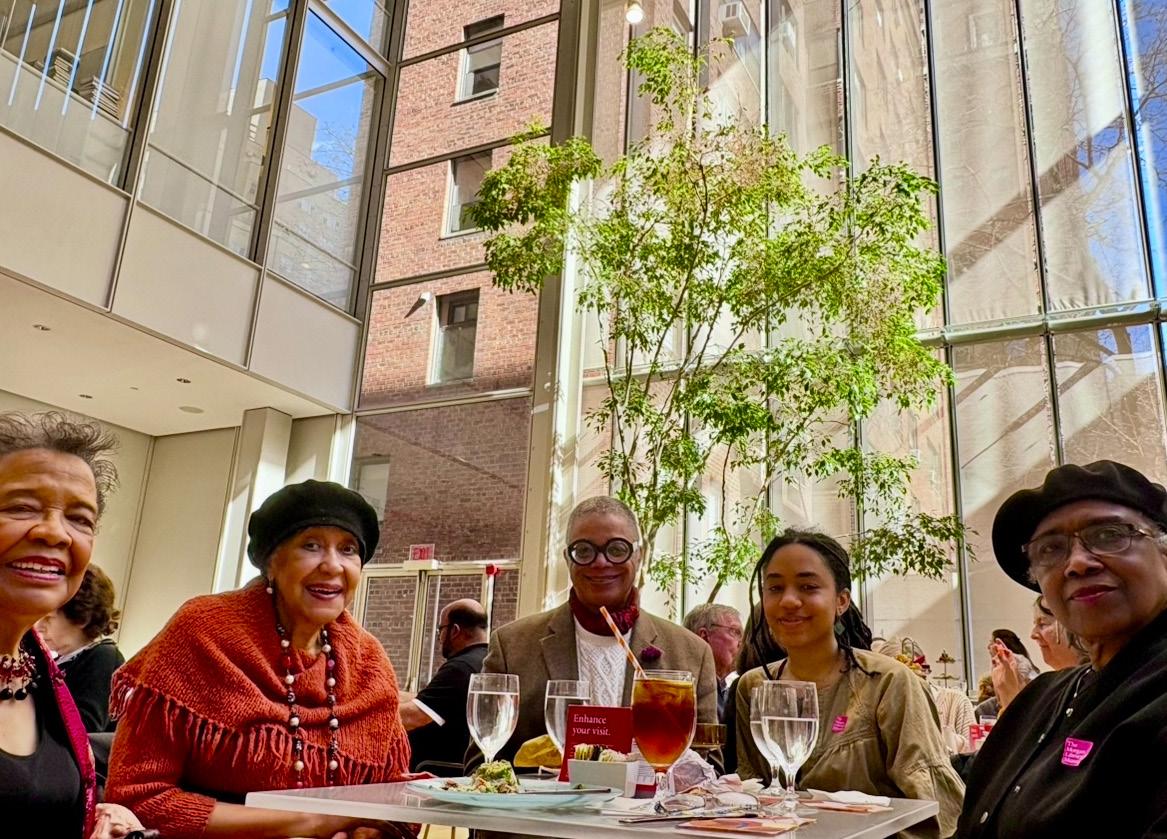
the necessity of mortar between them. The railings of the grounds are bronze and inside, most ceilings are frescoed or made of Tiffany glass.
All in all, at a time when even in Harlem was rapidly turning Black, there were no Black librarians or teachers, Morgan’s private museum, built for his own pleasure, is not the kind of place one expects to find an African American woman in charge of things!
However, Belle da Costa Greene (1879–1950) was just that, among the most prominent and powerful librarians of any time in the entire world.
As a part of her training, Greene worked in the Princeton Library for Junius Spencer Morgan. Shortly before completion of the Morgan Library in 1905, he recommended her to his uncle. Initially, she acted as the wily financier’s private archivist for $80 a month. Then, at a time when the New York City Health Commissioner only earned a little more than $5,000, Greene was paid $10,000. In 1913, at J.P. Morgan’s death, she was left a munificent bequest of $50,000, indicative of her employer’s esteem.
Continuing to organize and
expand the collection for Morgan’s son and his wife, Greene was named the Pierpont Morgan Library’s (today’s Morgan Library & Museum) first director in 1924. Over the next 24 years, she effected the Morgan’s metamorphosis. What was once a stolid and exclusive fortress, where most illuminated manuscripts were safely kept and locked away in the dark, became a welcoming center of erudition, brimming with intellectual enthusiasm. The dynamic program of exhibitions, lectures, and scholarly publications that Greene inaugurated form a tangible legacy extending even to today.
Born Belle Marion Greener, her father, Richard T. Greener was the first Black graduate of Harvard College, and both an eminent lawyer and educator, as well as a philandering diplomat, with a separate family abroad. The primary fundraiser for Grant’s Tomb, as a fervent civil rights activist, he liked to do his bit to enforce New York State’s equal rights law. Since white saloon-keepers showed contempt for Black customers, by smashing their glasses after they finished a drink, Greener took to entering with a dozen or more companions. Most were all thirsty enough to re-
quire at least a couple rounds. Greene’s parents separated even before she went away to New England for school. Genevieve Greener changed her surname and that of her children to Greene. The middle name da Costa, denoting “Portuguese ancestry,” they said, explained their relatively dark completions, as ever afterward, they passed as white.
With her splendid, highly respected position, French gowns, jewels, and housing completely barred to Blacks, Belle da Costa Greene enjoyed eminent white admirers and lovers as well. One devotee was world-renowned art historian Bernard Berenson, a Lithuanian Jew worthy of Horatio Alger who became an Episcopalian and rich. Another was the notorious art and haute couture collector Emilie Grigsby, who started out as the teen-aged mistress of streetcar magnate Charles Yerkes, only to become, in time, an intimate of Her Royal Highness Princess Mary of Great Britain. Each celebrity succumbed to Greene’s keen intellect and considerable allure. On the whole, the painful and fraught practice of passing worked out well for Greene — except in one sorrowful
incident, occurring late in her life. Greene lavished great care on her handsome and promisingly bright nephew Robert, known as Bobbie, whom she adopted as her ward. What dreams and great expectations she entertained for Robert Mackenzie Leveridge, who was educated at the finest schools, including St. Paul’s and Harvard. Greene watched over him with tender devotion. Patiently groomed with good books, he saw every notable theater and concert performance. On edifying trips made together, he visited places like the Grand Canyon, and traveled to Venice and other citadels of beauty in continental Europe. Yet still, in the end, despite all her favorable adjacency to riches and privilege, nothing in Greene’s power could protect her beloved Bobbie from the insidious curse of white supremacy. It’s not quite certain whether the young airman, who enlisted immediately after Pearl Harbor, was even aware of his family’s secret African American ancestry. However, after hiring a detective to investigate his daughter’s suitor, Nina Tess Taylor’s father was.
Continued on next page
The Morgan Library and Museum cafe, in a sun-filled atrium bridging the banker’s house and library, is a great place to meet, whether lunching with friends or enjoying a marvelous afternoon tea.
McKim, Mead & White’s spectacular East Room in J. Pierpont Morgan’s magnificent library. It adjoined his lavish office and that of his trusted librarian. (Michael henry Adams photos)
“Would they live off the money of Morgan’s n----- whore?” he asked her, perpetuating the slur that Greene had been nothing more than an incompetent DEI hire. When Bobbie died from a selfinflicted gunshot, the Army informed Greene that he was killed in action.
A friend, entrusted with Taylor’s parting letter to her fiancée, said to Greene that actually, Taylor had killed him with it. One sees why by reading how professing to love him, she could say that discovering his mixed race heritage prompted her both to break off their engagement and suggest he might kill himself.
Alternatively, at least he ought to be sterilized to resolve his predicament, she ventured. Sent on St. Valentine’s Day, replete with a coy arrow-pierced heart and a motto, “Be my Valentine,” her message was as lethal as it was gratuitously cruel. “If you ever marry anyone, you’ll have to do that, Darling, won’t you?” she wrote glibly. “As long as you continue to believe as I do that you have no right to have children . it would be a very wicked thing for you to have a child.”
After a rapid succession of losses,
including her respected employer and her protective mother, Greene suffered a mild heart attack and never fully recovered from this most paradoxical blow.
It was biographer par excellence Jean Strouse, so adroitly chronicling J. P. Morgan, who famously revealed in 1999 that Belle da Costa Greene was actually Belle Marion Greener. How stunned we were to learn in the New Yorker that someone assumed to be an ancillary white assistant was actually the high finance wizard’s African American partner, in the realization of a library that is unequaled.
How did Strouse do it? Research had caused her to question just who this woman of mystery was; why had she destroyed her personal papers? She telephoned historian David Levering Lewis.
“Overhearing our conversation,” relates Lewis, “my dear wife, Ruth Ann Stewart, asked to be put on.
She said, ‘Jean, I will tell you exactly who Belle Greene was,’ and over dinner that night, she proceeded to do so!”
If you missed the Morgan’s magnificent retrospective exhibition outlining Greene’s life and work, “Belle da Costa Greene: A Librarian’s Legacy,” which ended in May, no worries: You may still see the
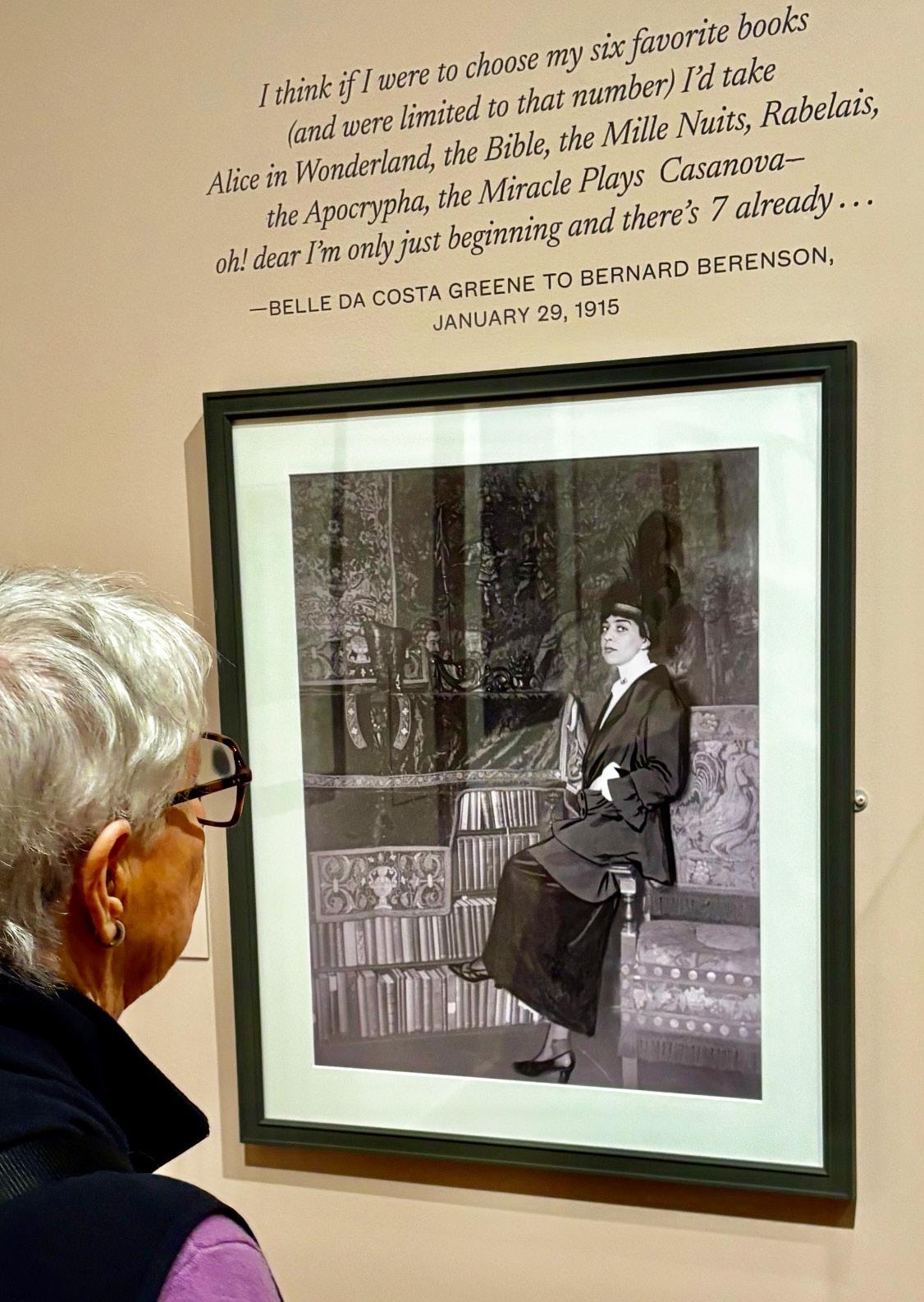
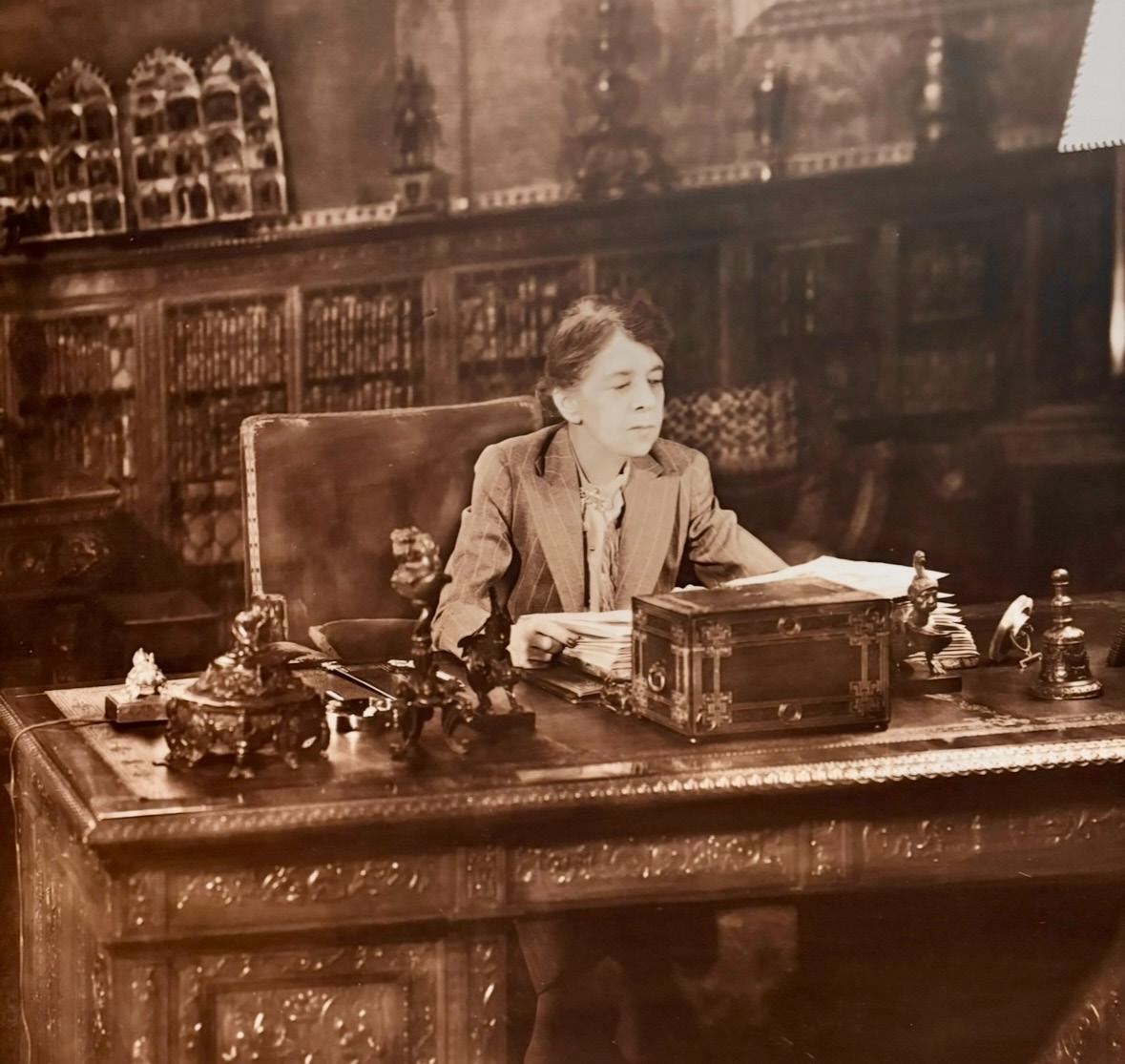
place where she labored and all the precious loot she helped acquire, document, curate, and organize. The volumes she obtained for Morgan for a fraction of what he expected to pay, because of her exceptional knowledge and the holy family she helped guide Morgan to, are all on view to be studied at leisure, along with her well-documented story.
Better still, for just $67 for two, one may both gain admission and relish a sumptuous teatime with Harney & Sons tea, exquisite tea sandwiches, scones, cookies, cake, and bits of fruit like grapes or berries.
The Morgan’s cafe is in a sundappled atrium with a wall of windows. It forms a bridge between J.P. Morgan’s brownstone

city house and the marble library.
The gift shop, in the onetime residence, occupies the Louis Quinze, walnut-paneled drawing room. Reservations for tea and other fare are not required, but are strongly recommended.
The Morgan Library & Museum is open Tuesday, Wednesday, Thursday, Saturday, and Sunday from 10:30 a.m. to 5 p.m., and Friday from 10:30 a.m. to 8 p.m. On Fridays, anyone may visit the Morgan free of charge, and Free Friday programs take place each week from 5–8 p.m. Reservations are required, but tickets are available as early as a week ahead. On the first Sunday of each month, university students are admitted free.
The Morgan is closed Mondays, Thanksgiving Day, Christmas Day, and New Year’s Day. It closes at 3 p.m. on July 4, 4 p.m. on Christmas Eve, and 5 p.m. on New Year’s Eve.
Admission
$25 Adults
$17 Seniors (65 and over)
$13 Students (with current ID) Free to children 12 and under (must be accompanied by an adult)
Direct any questions to either tickets@themorgan.org or 212685-0008, extension 560. For more info, visit themorgan.org.
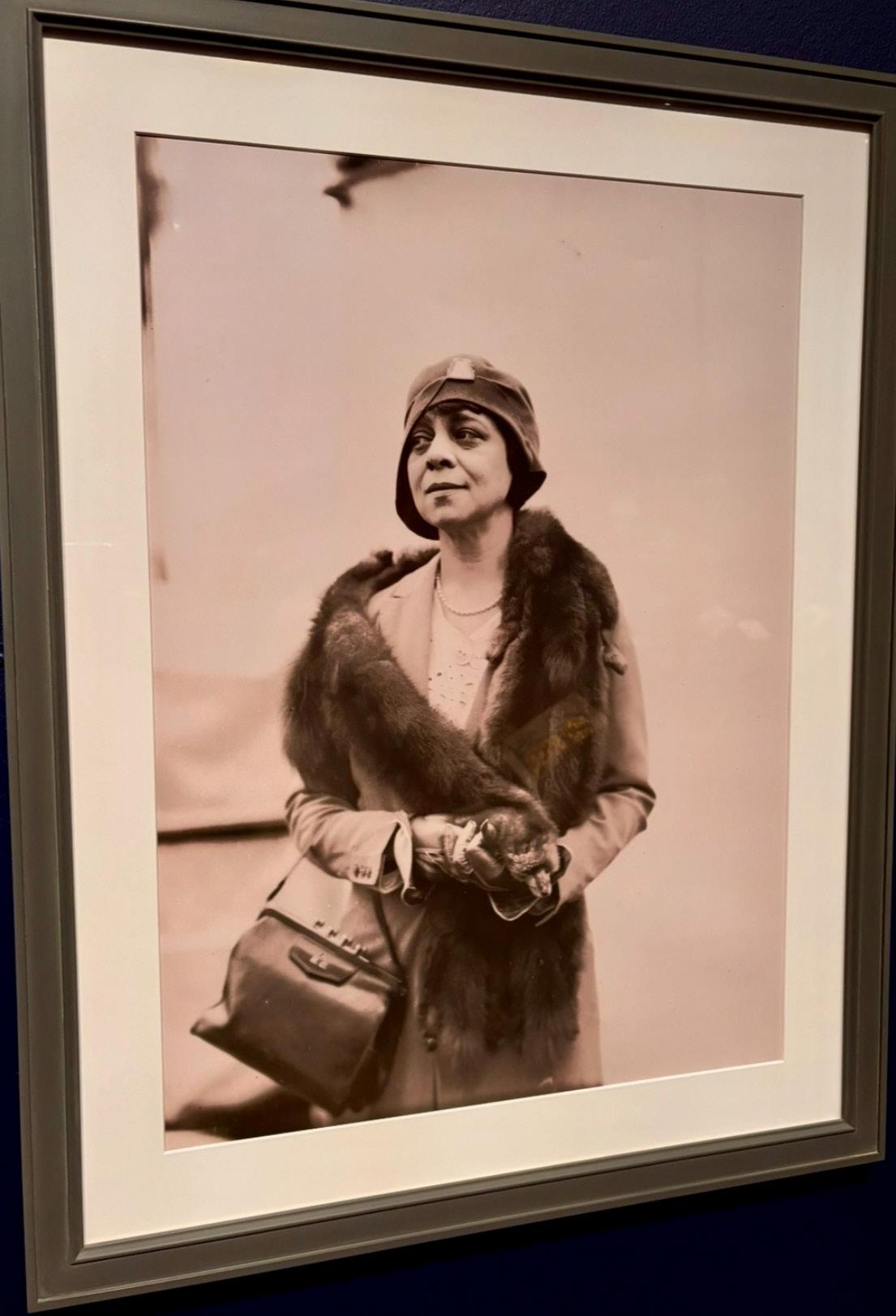
Throughout her 43-year career, Greene dressed in the height of fashion, wearing clothes by major Parisian couturiers, such as Paul Poiret and Jacques Fath. Belle Green’s custom-made card catalog.
Still chic, a mature Greene photographed by Mattie Edwards Hewitt in 1929.
Greene, hard at work at her desk, to the last, in this circa 1949 image.
(Michael henry Adams photos)
Newark community members gather at Sounds of the City for Junior Marvin & the Legendary Wailers
By JOHNNY KNOLLWOOD Special to the AmNews
The sun shone bright over the New Jersey Performing Arts Center (NJPAC) in Newark on July 10 as Junior Marvin and the Legendary Wailers took to the stage at Horizon Sounds of the City, a free outdoor concert series hosted by NJPAC in partnership with health insurance provider Horizon Blue Cross Blue Shield. The series, held every summer, co-locates music, local food vendors, and no-cost healthcare services in NJPAC’s courtyard, providing space for the community to drink, dance, and be merry. Local performers Briannagh Dennehy and Shorn Biscette opened the evening alongside poet Brittany Barker to warm the crowd up for a 90-minute set
jam packed with hits and crowd favorites.
Junior Marvin, who has collaborated with Steve Winwood, Toots & the Maytals, and T-Bone Walker, is best known for his work with Bob Marley & the Wailers from 1977 until Marley’s passing in 1981, appearing on classic albums that include Exodus, Kaya, and Uprising. He continued to record with the Wailers band after Marley’s death and has performed with various incarnations of the group in recent decades. Currently, he is the only member of the Legendary Wailers who performed alongside Marley.
Fans of all ages, including NJPAC president and CEO John Schreiber, were scattered across the courtyard on benches, in lawn chairs, and on their feet — dancing and singing along to fan favorites like “Buf-

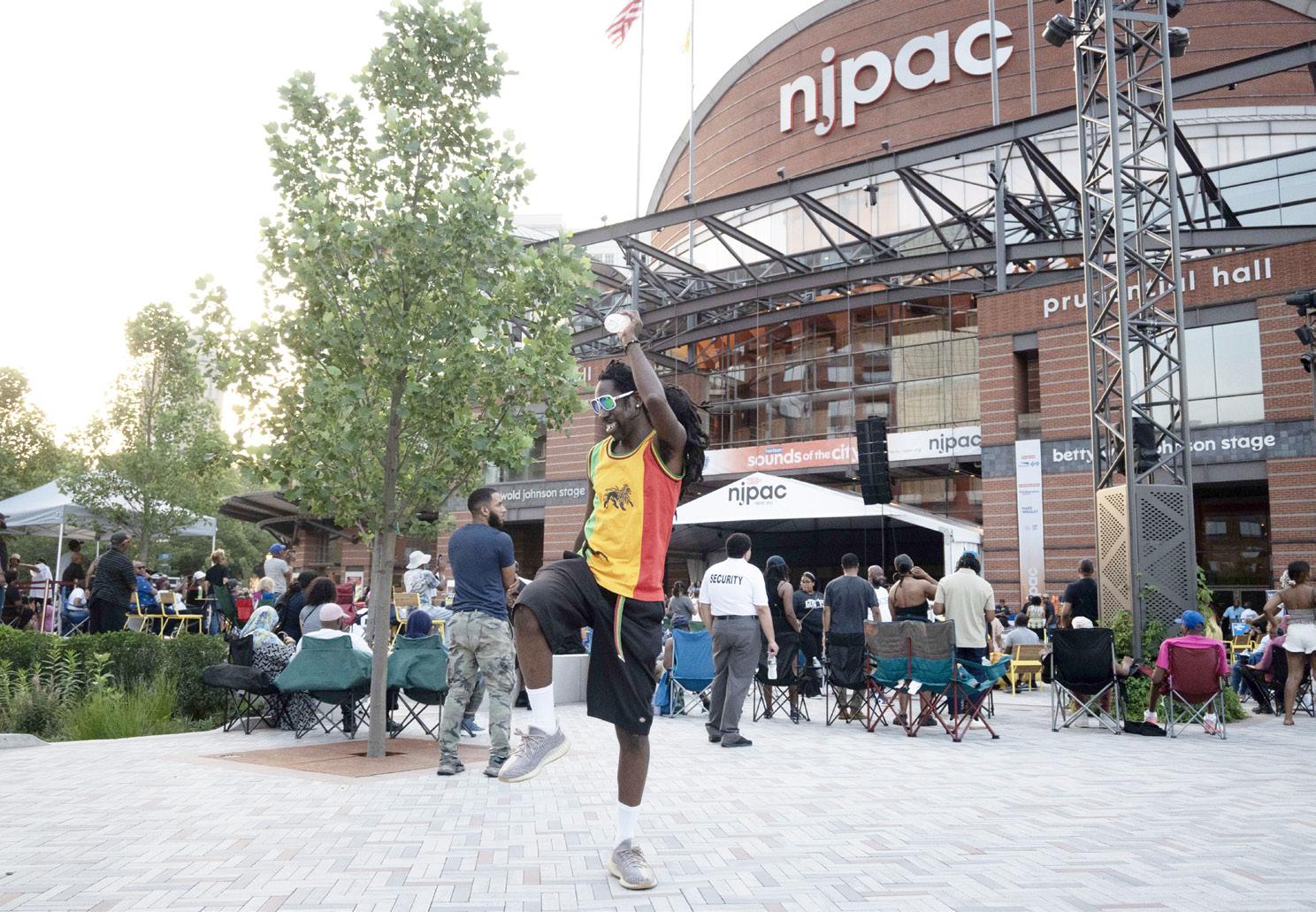
falo Soldier,” “Stir it Up,” and “Could You Be Loved.“ Local food trucks sold burgers, ice cream, and steaks, and games like mini golf and a football toss were placed throughout the square. At the far end of the courtyard, set up next to the bar, were tents for Horizon NJ Health and RWJ Barnabas Hospital, giving out sunscreen and offering no-cost healthcare services like blood pressure and glucose screenings. They were located next to Patrón Tequila, who were onsite handing out promotional merchandise and offering a photo booth to passers by, an illustration of how art and community engagement can be used to promote a sense of health as well as fun.
The Wailers wasted no time, saying very little with their words and whole lot with their music. The songs, nearly half a cen-
tury old, still feel relevant today in their messaging for freedom, justice, love and happiness. Amidst the increasingly divisive political climate of today, the Wailers’ do not ignore all that is ugly, “I Shot the Sheriff,” could have been written yesterday – but they remind us over and over again in classics like “No Woman, No Cry,” and “Three Little Birds,” that there is indeed hope. It seemed as if there was no shortage of hope, togetherness, and community in the courtyard of New Jersey Performing Arts Center, as hundreds sang together. “Don’t worry about a thing,” they cried. “Cos’ every little thing, is gonna be alright.” Horizon Sounds of the City runs through August 7. To stay up to date and for more info, visit njpac.org/series/horizon-soundsof-the-city.
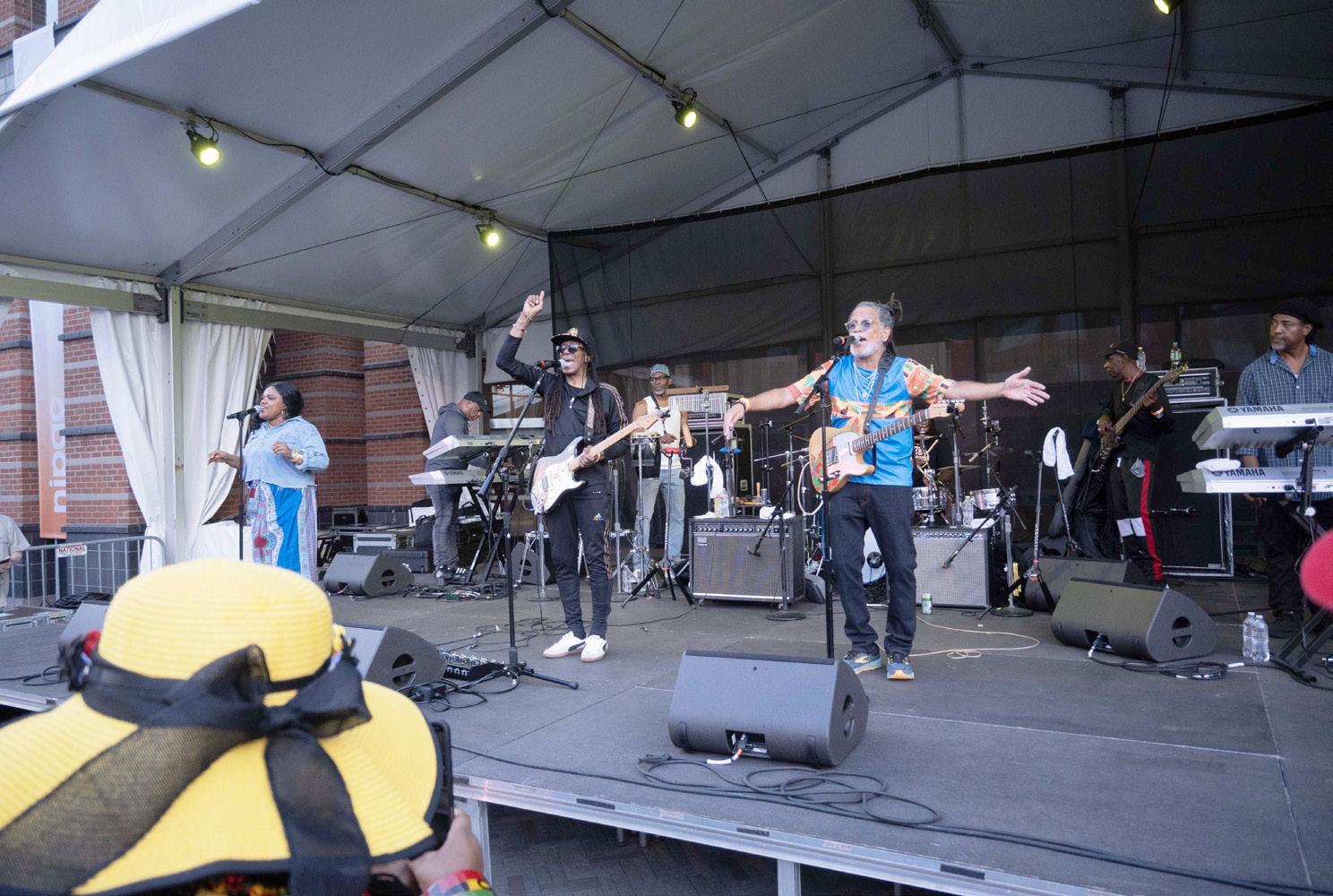

The Wailers leading the audience in song at NJPAC.
Junior Marvin & the Wailers, live at NJPAC’s Sounds of the City on July 10, 2025. (Johnny Knollwood photos)
Fans enjoying The Wailers at NJPAC.
Grammy nominated percussionist Bobby Sanabria & Ascensión provide danceable pathway to cultural connection

By JOHNNY KNOLLWOOD Special to the AmNews
On an unassuming side street in the thick of midtown Manhattan, dog walkers, lucky passersby and workers on their lunch hour gathered at Worldwide Plaza on July 10 to take in the sounds of Grammy nominated percussionist and educator, Bobby Sanabria who brought his latest Latin-jazz outfit, Ascensión, to the square for two energetic midday sets. Sanabria was joined by Jack Glottman on piano, bassist Donald Nicks, Chris Washburne on Trombone, percussionist Oreste Abrantes, Kali Rodriguez on trumpet, and saxophonists Peter Brainin and Jeff Lederer.
The free bi-weekly summer concert series is produced by Berman Arts International and personally curated by CEO Gail Berman, a former arts educator and NYU alum who has produced public programming in the city for nearly four decades. “Bobby and I go back to my first summer series in 1985 at Rockefeller Center. He taught me about Afro-Cuban music,” Berman told the AmNews. “He’s the only one that I bring back every year.” Sanabria, who has collaborated with legendary figures across jazz and Latin music; that includes Celia Cruz, Dizzy Gillespie, and Tito Puente, has released cutting-edge music under his own banner since the early 90’s, and was most recently nominated for a Grammy in 2023. He has also written for magazines Modern Drummer and Downbeat, and hosts the “Latin Jazz Cruise” radio show on WBGO 88.3 FM.
Ascensión’s performance was like a tasting menu of Latin styles. From Colombia
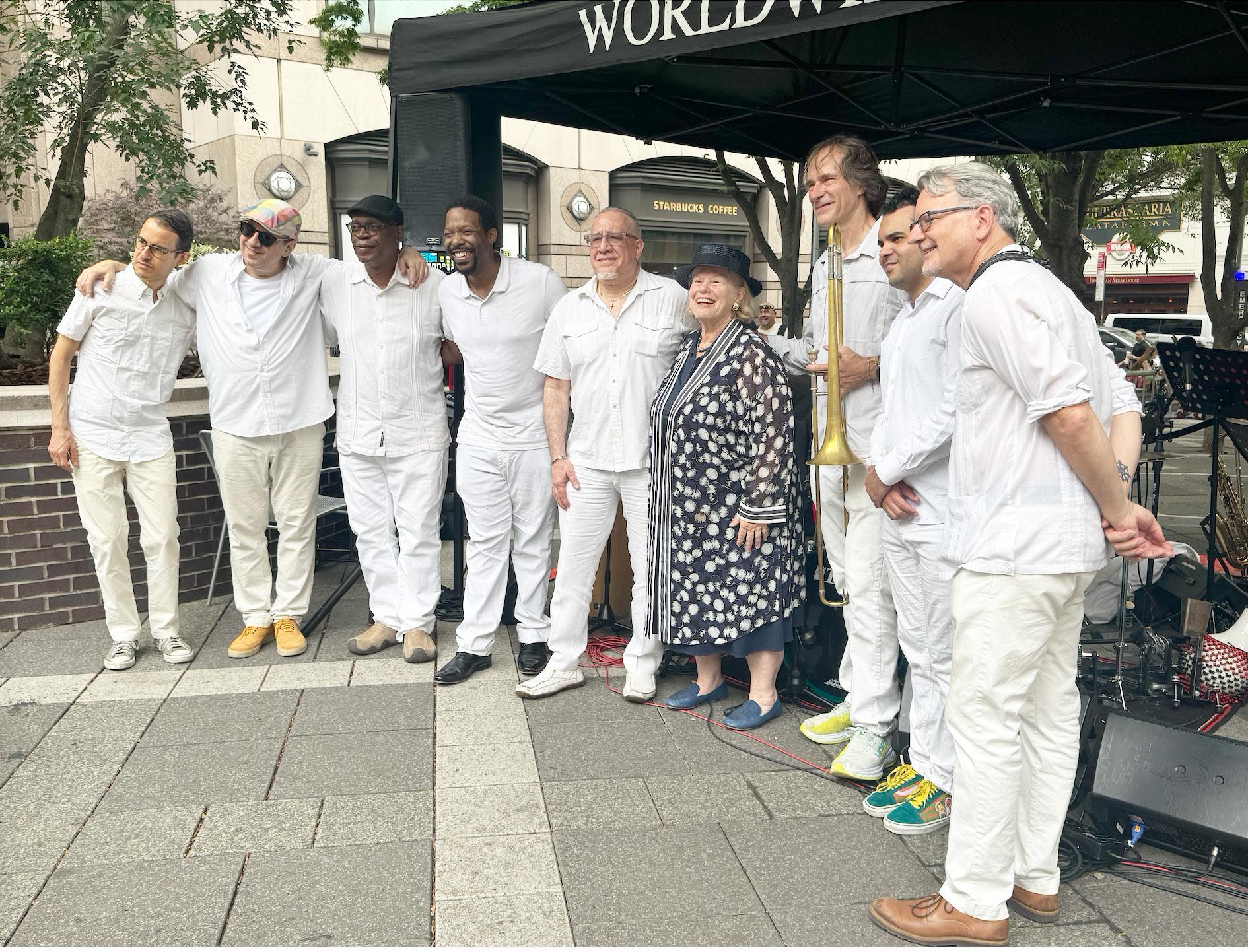

to Venezuela to Cuba — Sanabria and his band showcased the depth of their ability, and understanding of the deep rhythmic sensibilities that allow this music to be. The crowd, seated and scattered across the plaza at tables and benches, couldn’t help but tap their feet to the smorgasbord of sound delivered by Sanabria and his band that included moments of intense improvisation, hit songs, and bits of history. Sanabria, an avid educator who is on staff at The New School and has released critically acclaimed instructional videos like
Conga Basics, took time in between songs to explain the origin of the rhythms and songs his band performed, which ranged from an 1870’s Cuban tune to a rendition of “Bésame Mucho,” which Sanabria called “probably the most recorded song in the history of Latin music,” to an enthusiastic crowd. “Even the Beatles did a version of it.”
He taught the audience about the montuno, a vamp or repeated rhythmic pattern present in Cuban music, the clave, a rhythmic pattern in Cuban and Brazilian music, and the origin of Latin jazz in Harlem,
which was born by incorporating these elements into Jazz compositions performed by Black Americans in the early 20th century. “Every time he gives a performance, he also gives a history lesson,” said attendee and local artist Bill Buchman, who sat front row for the show. “Not just in his lecture, but in how he plays his drums.”
Throughout the set, the rhythm section held down an intense, locked-in groove, giving the horn players the opportunity to explore and express themselves through their instruments.
At one point, Sanabria opened the floor to requests and performed popular tunes like Herbie Hancock’s “Watermelon Man,” and “Oye Como Va,” which was originally performed by Tito Puente in 1962, but was a hit for Carlos Santana in 1970. Angelica, a woman from Buenos Aires seated in the crowd, requested music from her homeland, and in a moment of sporadic beauty, Sanabria called a rendition of Duke Ellington’s “In a Sentimental Mood,” using a rhythm and feel that originated in Argentina. Angelica watched with joy as the group presented a unique take on a classic tune. Bobby Sanabria’s sound is as New York City as it gets — it is the melting pot, a fusion of Black American Music, and the rhythms of Cuba, Brazil, and Argentina crafted amidst the sidewalks and subways of the Bronx and Upper Manhattan. It is reflective of the diverse cultural landscape that allows the arts to flourish and progress in the city. “It really is reflective of New York,” added Berman. Free concerts at Worldwide Plaza are offered every other Thursday at 12 p.m. through September 18. Stay up to date at @ baimusic23 on Instagram.
Bobby Sanabria taking a mean drum solo at Worldwide Plaza on July 10, 2025
(L-R): Pianist Jack Glottman, saxophonist Jeff Lederer, bassist Donald Nicks, percussionist Oreste Abrantes, bandleader and drummer Bobby Sanabria, showrunner Gail Berman, trombonist Chris Washburne, trumpeter Kali Rodriguez, and saxophonist Peter Brainin led the audience at Worldwide Plaza in song and dance on July 10.
Bobby Sanabria & Ascensión (Johnny Knollwood photos)
‘Ella’ review, Sista’s Place, Jazz in July

The whisper of America’s greatest song stylist Ella Fitzgerald’s name strikes a kinetic force — you want to move, dance, swing. Her distinct timbre was a fascinating jaunt of crazy improvised scats, perfect pitch, and joyful rhythms dancing in life’s galaxy, encompassing the sun, moon, stars, clouds, and Milky Way. After all, she is known as the ‘First Lady of Song.”
Throughout her illustrious career and after her transition on June 15, 1996, Fitzgerald’s life has been well-documented. However, her tumultuous adolescent years in Yonkers and Harlem left gaps with room for speculation.
The writer and playwright Diane Richards has integrated those speculative gaps into an imaginative, melodramatic novel, “Ella” (Amistad, 2024). Richards vividly constructs a castle of dreams where Ella could retreat as her life quickly spiraled down into the depths of Hades.
After her mother’s death, Ella and her younger sister Frannie were left with her stepfather, a big brute of a man who abused Ella, forcing her to run away, tearfully leaving her younger sister behind. She found refuge in Harlem at her aunt’s apartment, where she became entangled in street life as a numbers runner while pursuing her dream of becoming a famous dancer. Unfortunately, her school truancy earned her a free bus ride to upstate New York to a girls’ reformatory school where the white matrons eagerly treated Black girls to a harsh dose of racism.
Never giving up hope and always resourceful, she eventually escaped and returned to Harlem, only to fall into a pit of homelessness. However, Ella remained confident and, in the midst of despair, one night, she found herself patiently waiting in her soiled clothes on a long line for a chance to show off her talent at Amateur Night at the Apollo Theater. That historic night in 1934 introduced the magical voice of Ella Fitzgerald, whose improvised style shattered the sound of modern music and redefined the Great American Songbook.
“Ella” is a descriptive novel — a verbal film that directly transports readers to the streets of Harlem, as Ella ducks down dangerous alleyways, or sits locked in a closet by her stepfather. Ella comes to life as you see her dancing at the front of the Savoy Ballroom. You hear an older, successful Ella candidly facing those horrible demons of racism, psychological abuse, and the many concealed hurdles that appeared in her path. “Ella” is a story of a young lady, one of America’s most brilliant icons, who remained confident, and in the darkest moments, refused to give up her dream.

“Ella” represents a quiet salute to Black mothers and the Black women in her life, who offered her hope. Many times, it was the recurring words of her mother and aunt that kept her grounded.
“Ella” is improvisational, like her song “Rough Ridin,’” scattin’ high flyin.’ Listen to her sing the blues on “Ella Hums the Blues” — it’s not sad, baby; her voice is riffing like a horn finding its way home. In “Ella,” the words flow like romping rhythms; there’s always a way out, a sweet song at the end of the tunnel.
Richards, executive director of the Harlem Writer’s Guild, did in-depth research for this book. “This is historical fiction,” she said. She also said that Ella was her idol (at one point, Richards was also a singer).
Jimmy Scott’s vocal career was menaced by a stormy cloud of obscurity, but his unique, high-pitched voice secured a devoted core of cult fans throughout his career, which began to glow in his twilight years.
On July 19, Scott’s longtime saxophonist TK Blue with the Jazz Expressions will pay tribute to the iconic jazz vocalist at Brooklyn’s jazz oasis Sista’s Place. Blue will be joined by two fellow Scott alumni: bassist and his longtime musical director Hill Greene, and drummer Dwayne Cook Broadnax, along with pianist Alva Nelson, and featured vocalist Queen Esther.
“We wanted to celebrate Jimmy’s centennial — he is an unsung innovator of jazz vocals,” said Blue during a phone interview. “He taught me how to complement a singer by not overpowering but to enhance with continuity. He was a master of the slow tempo, similar to Shirley Horn.” Blue said Scott had an uncanny inventiveness of phrasing lyrics that gave the most traveled
standard a new destination.
Scott, born on July 17, 1925 was one of America’s most revered vocalists, whose sound was so beautiful, it could stop a nightingale in mid-song. As a vocal treasure, he was never fully acknowledged for his undeniable contribution to the jazz canon. Hopefully, this is the first of many celebrations that will honor his 2025 centennial. Reservations are a must — call 718-398-1766.
The Jazz in July series, now in its 40th season, presented by 92NY (1395 Lexington Avenue), is overflowing with renowned artists performing now through July 26. Concerts are in person and online.
On July 19, homage to the tenor saxophone, a longtime favorite instrument whether being played in rock & roll or jazz, will be celebrated with Tenors of our Time,
featuring Melissa Aldana, Chris Lewis, Walter Smith III, and Lew Tabackin, and an explosive rhythm section led by pianist and composer Aaron Diehl, with bassist Yashushi Nakamura and the exciting young drummer Kush Abadey.
“In my second year as Jazz in July’s artistic director, I want to keep the foundation of the series and the framework built over the decades, while introducing new ideas and artists,” said Diehl. “I want the festival to showcase the vast landscape of jazz — both the music’s roots and its continuing evolution.”
On July 22, the series presents Celebrating Geri Allen & Mary Lou Williams, two of America’s inventive jazz pianists and composers. Williams’s arranging capabilities left a mark on the big band era while influencing the likes of Thelonious Monk and Randy Weston. NEA Jazz Master drummer Teri Lyne Carrington, who collaborated with Allen on many occasions, will be joined by vocalist Vanisha Gould, who delivers her own intriguing jazz interpretations; saxophonist Nicole Glover; Diehl on piano; and bassist Nakamura.
The pianist and composer Marta Sanchez Quintet performs on July 23. Sanchez, not to be categorized, is steeped in her homeland rhythms, world music, and influences of American jazz. Her ongoing tours with the innovative saxophonist David Murray expanded her concept of free expression, opening the door to avant gardism. Her most recent album, “Perpetual Void,” released in 2024, is a trio project featuring the captivating drummer Savannah Harris and bassist Chris Tordini.
The July 26 closing will feature composer-bandleader Darcy James Argue’s 18-piece ensemble Secret Society. The ensemble joins Diehl for the world premiere of “A Banquet for the Birds,” Argue’s new suite for piano and jazz orchestra, written for Diehl and co-commissioned by 92NY and the NDR Bigband. All concerts start at 7:30 p.m. For more information and for tickets, visit 92ny.org.
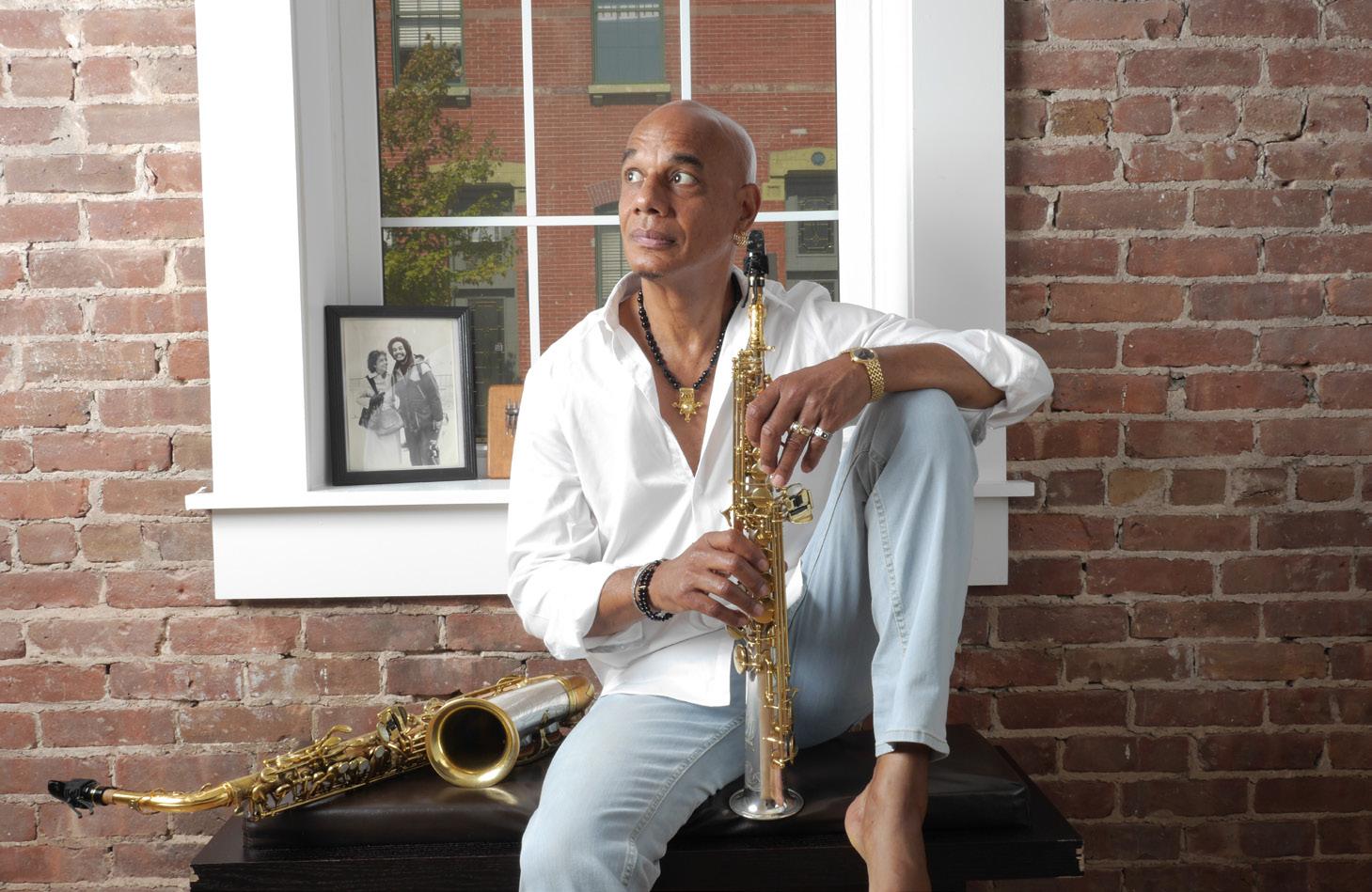
Diane Richards (Nancy Adler photo)
AG James encourages DoorDash workers to collect settlement money
By TANDY LAU AmNews Staff
No need for a mad dash to claim DoorDash settlement money — at least not yet. Sept. 30 marks the deadline for qualifying deliveristas to collect their funds from a lawsuit alleging the app-based company pilfered tips to offset payroll between May 2017 and Sept. 2019. They can file a claim online at www.nydoordashsettlement.com.
State Attorney General Letitia James secured the $16.75 million settlement this past February against DoorDash, the largest food delivery platform. The lawsuit also mandated revised payment practices, pay policy transparency and worker access to delivery history for at least four years. James advises that eligible “Dashers” claim their restitution as soon as possible.
“I am proud to return millions to the pockets of hardworking Dashers and ensure transparency in DoorDash’s payment practices going forward,” said A.G. James in a statement. “I urge any Dasher who received notice of the settlement to file a claim now to get their money back before the deadline on September 30, 2025.”
James’ investigation found DoorDash allegedly misled customers into believing their tips would unilaterally support their deliverista. Instead, “Dashers” allegedly received the same earnings no matter how much they were tipped unless the gratuity exceeded their base
pay (the company would then pay them $1 on top of their total tips). DoorDash did not admit fault in the settlement and discontinued the model in 2019.
“I have been delivering for DoorDash since they started, but I do not work for them as much anymore because the system was not clear and they were taking our tips,” said Dasher Lee Vaughn earlier this year. “DoorDash never told us accurate distances and the payment amount they would promise was not always true. They would show us an amount plus tips, but they were not telling us the truth. We worked hard and we deserve to be paid.”
Roughly 63,000 people qualify for claims for delivering food between May 2017 and Sept. 2019 in New York. Undocumented immigrants can also file a claim regardless of status.
Minnesota-based settlement administrator Atticus Administration received roughly $1 million from DoorDash to issue the restitution and kicked off outreach in April. Dashers are informed of their eligibility through mail, email or text message. However, Luis Cortes, director of Los Deliveristas Unidos at Worker Justice Project, says people can be skeptical of third-party notices.
“Sometimes they got the email [but] they don’t read it or they don’t know what it means.” said Cortes. “People are very afraid of being scammed. So we’re trying to go out and tell them if they did deliveries between 2017 and 2019, they might qualify to get this money.”
from how much he or she lost, how much money is available and how many people actually file a claim (the AG’s Office projects some workers may be owed up to $14,000 on the highest end). Eligible Dashers will receive at least $10. Payment can be sent through physical check, virtual Mastercard or digital money transfer services like Zelle or Venmo.
“We remain committed to making sure that Dasher earnings are always fair and transparent, and the allegations settled were related to an old pay model that was retired in 2019,” said a DoorDash spokesperson. “To be clear: Dashers always keep 100% of tips from orders on the DoorDash app. While we believe that our practices properly represented how Dashers were paid during this period, we are pleased to have resolved this years-old matter and look forward to continuing to offer a flexible way for millions of people to reach their financial goals.”
Deliveristas secured another majority victory this past Monday when a five-bill package passed, further regulating how app-based delivery companies treated their workers. The legislation will bring back tips at checkout — DoorDash moved the tipping option to post-checkout after New York City instituted minimum pay laws in 2023.
The bill package will also mandate appbased delivery companies to disclose their pay calculation and breakdown worker earnings each pay period, as well as expand existing 9.6”
Exactly how much a claimant receives stems
See AG JAMES on page 44
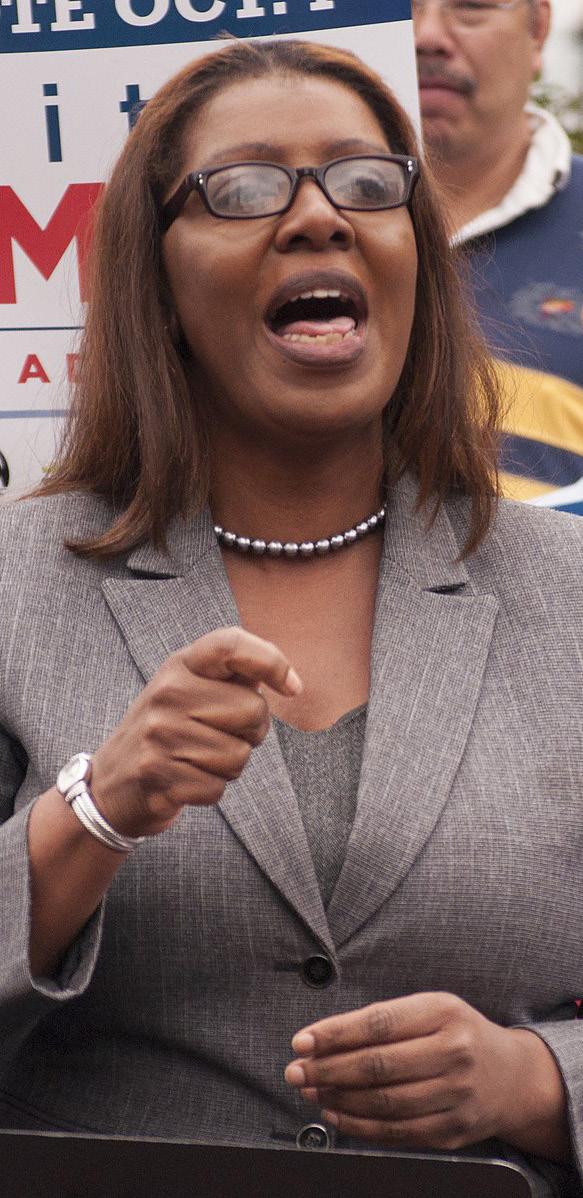
YOUCOULDBEWINNING
Letitia James at a rally. (Matthew Cohen photo via Wikimedia)
Education
Nyla Clayton makes Harlem sweeter with her bakery
By Esmeralda Moran Special to the AmNews
Nyla Clayton stands behind the counter of her shop, smiling as she hands a box of strawberry donuts to the woman in front of her. She thanks the woman for her time and bids her farewell before ad justing her stand, counting the remain ing boxes of donuts on the table — two. The bakery has only been open one hour and she is close to running out.
Clayton is a 17-year-old entrepreneur that got her start during Covid. During the pandemic, Clayton became vegan and found herself wanting to pick up a new hobby. Reminded of a mini donut maker gifted to her, she used the tools to make desserts.
“In Harlem there’s no vegan bakeries. You have to go downtown for them and because we were at home I just decided to bake at home,” said Clayton.
As her interest for baking grew, so did the idea of turning the hobby into a busi ness. When the world returned to inperson events and shifted away from quarantining, Clayton expanded her business, serving not only her mother and sister but anyone that was interested in her vegan donuts.
“From then I was like ‘this is it.’ We made the business idea and did pop-ups in Brook lyn, we did pop-ups in Harlem and this spot opened up. This opened up in February and we took it over in March.”
After five years of building her business, Clayton saved enough money to rent out a store-front at 405 W 145 St. where she sells gluten-free donuts to everyone that walks through the door. Clayton reminisces on opening day, recounting her biggest lesson learned from the experience.

people stick together. As long as we have our community tight, that’s all that matters.”
Despite the challenges presented, Clayton continues her journey as a businesswoman, taking pride in her business and her role as a Black woman in the business industry.
“I really learned to never underestimate the amount of people that walk in.”
She takes this to heart as she pauses to interact with customers that enter the storefront, answering questions about the flavors of the day and catching up with customers that have followed her business for a while. Clayton attributes her ability to communicate with her customers to her family who are also entrepreneurs.
“I tend to learn how to talk to people more naturally because as a kid, I was very business up-front. My mom is an entrepreneur, my dad is an entrepreneur, my grandma is an entrepreneur so it’s been very ingrained to me on how to talk to people in a certain way.”
Clayton was recently featured on popular Instagram account Secret NYC’s page, highlighting her business, which garnered over half a million views, and even getting the attention of famed musician Questlove.
“I get a lot of little kids in here and I tell them don’t let anybody omit what you want to do and what you need to do. Don’t let yourself get discouraged, that’s what I always tell the kids. Don’t let yourself get discouraged because of your age, because of your race, gender, everything.”
Now a senior in high school, Clayton is looking forward to attending college where she will major in psychology. She still plans to continue her business while in school.
Clayton sees the dwindling amount of donuts left on the counter and excuses herself as she makes the trip back to her home nearby where she will make another batch of mini donuts from her kitchen to sell to the community until closing time. Though she has only been open an hour, she approaches her first sell out of the day and with the media traction she has been receiving, it looks like it won’t be the last.

Nyla Clayton (Esmeralda Moran photo)
Staten Island
Continued from page 4
exceeded other candidates so far with $266,430 in private funds and $162,890 in public matching funds, said the New York City Campaign Finance Board (NYCCFB).
Blas, 38, a Brooklyn native, is the founder of Community Impact Strategies and an executive director at Staten Island Women Who March, a lifelong progressive, and advocate for working families as a mother of six. She has a background in public health as a hospice care worker. She got 15.12% on Election Night.
Even though she didn’t have a strong showing, she pivoted to the Independent line and is now running in the general election in November — in the same way incumbent Mayor Eric Adams and former Governor Andrew Cuomo jumped ship to being Independent candidates against Democratic mayoral nominee Zohran Mamdani. Blas has also unsuccessfully ran for Senate District 23 in 2022 and Congress District 11 in 2024.
“So our strategy was to focus on getting on not one line, but three lines. The councilmember, Hanks, and this is public information, her strategy was to knock as many folks off the ballot as possible, to silence as many voices as possible,” said Blas. “And so we spent the bulk of our funds, the bulk of our resources in battling not one, not two, but 11 legal challenges. So we showed
up to court 11 times.”
Hanks caught a lot of heat for knocking city council candidate Jozette Carter-Williams, whose ex-husband was an NYPD officer killed in the line of duty in 1998, off the ballot after petitioning season. Hanks has also not been endorsed by the SI Dems Party for re-election.
Blas said her campaign has since consolidated support from the Democratic candidates that made the ballot and community leaders that announced their candidacy. She claimed that Hanks has been “absent” in the community, so being an Independent candidate won’t hurt her chances of winning. Blas has raised $17,522 in private funds and $68,308 in public matching funds so far, said NYCCFB.
“I think that especially given the state of our government now, the state of some of our elected officials, past and present, not showing up in the community,” said Blas. “I think folks are feeling very disenfranchised and that whole, ‘I’m just going to vote because they’re blue,’ is not enough anymore. They want to vote for someone that has a track record of showing up, a track record of doing things. Grassroots candidates are what folks are looking for, not establishment candidates.”
Meanwhile, the Republican challenger John Shea, a retired first responder raised on the North Shore, is looming over the Dem stronghold on SI. He has raised $15,190 in private funds and $48,134 in matching funds from the city so far, said the NYCCFB.
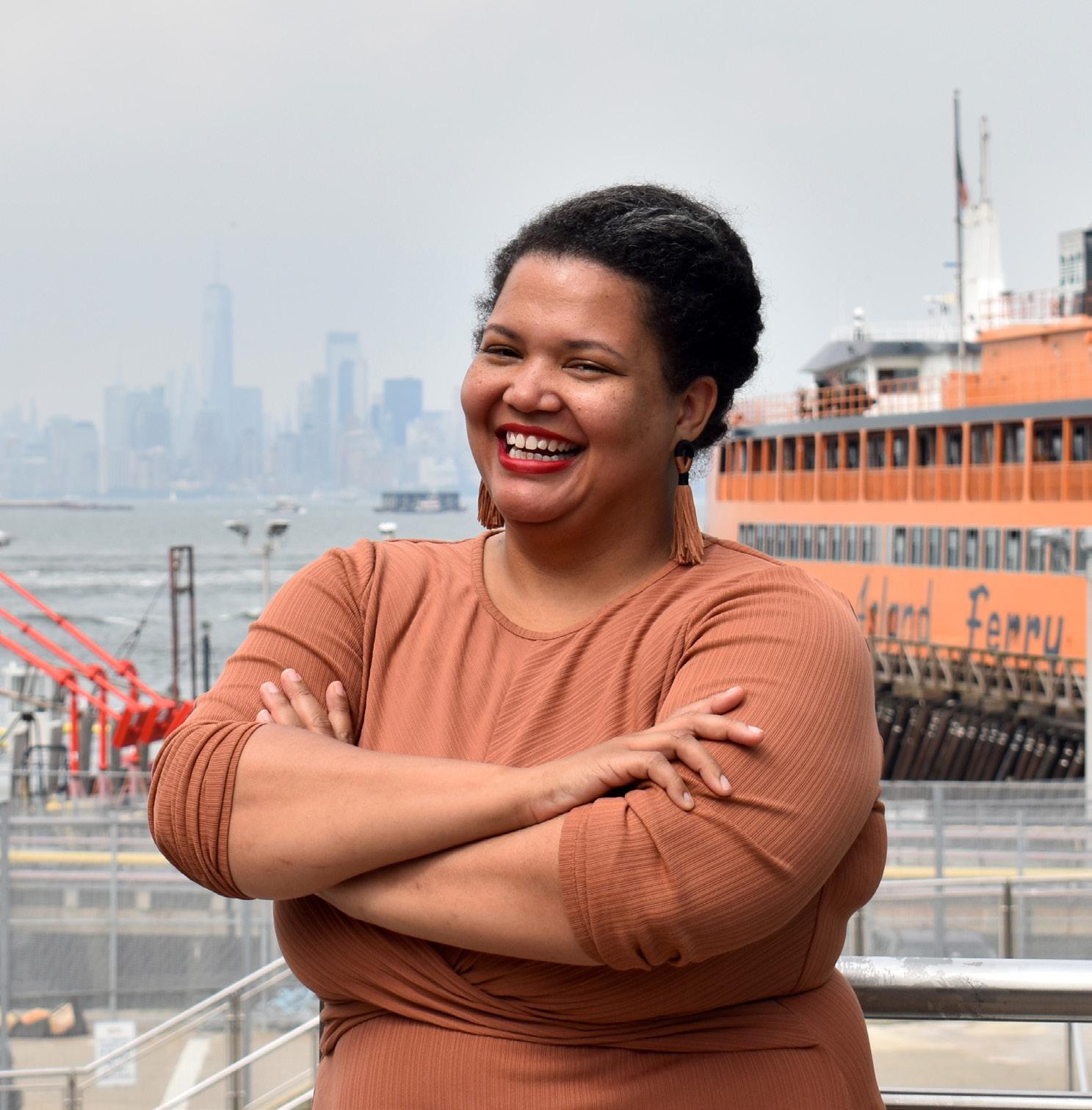

City council candidate Sarah Blas on the North Shore waterfront. (Ariama C. Long photo)
Coliving as a housing solution for aging New Yorkers
By TAAYOO MURRAY Special to the AmNews
Amit Ahuja was living in Queens and, like many others, was looking for an affordable place to rent in May of 2024. “I was living somewhere that wasn’t good at all, and des perately wanted to move,” shared Ahuja, 68, who was born in India. He explained that he heard of a coliving facility while at one of the day centers, and reached out. Un fortunately, there were no vacancies at the time and he was put on a waitlist. His luck changed in August 2024 when one of the residents moved out of state, and he got off the waitlist.
The Office of New York State Comptroller estimates that in 2022, 3 million New York households experienced housing insecu rity, which is characterized by issues like burdensome housing costs, inadequate or unsafe living conditions, and the risk of eviction.
Minority populations are even more im pacted. Black and Hispanic New York City residents are disproportionately affected by housing insecurity. The same Comptrol ler’s report showed that fifty-five percent of households headed by a Hispanic, and fifty percent of homes with a Black head of household, had at least one housing in security problem, in comparison with the thirty-one percent of households headed by a white person. Coliving can be a viable housing solution for aging New Yorkers be cause, when done correctly, it can offer a unique and tailored blend of community living, affordability and support services.
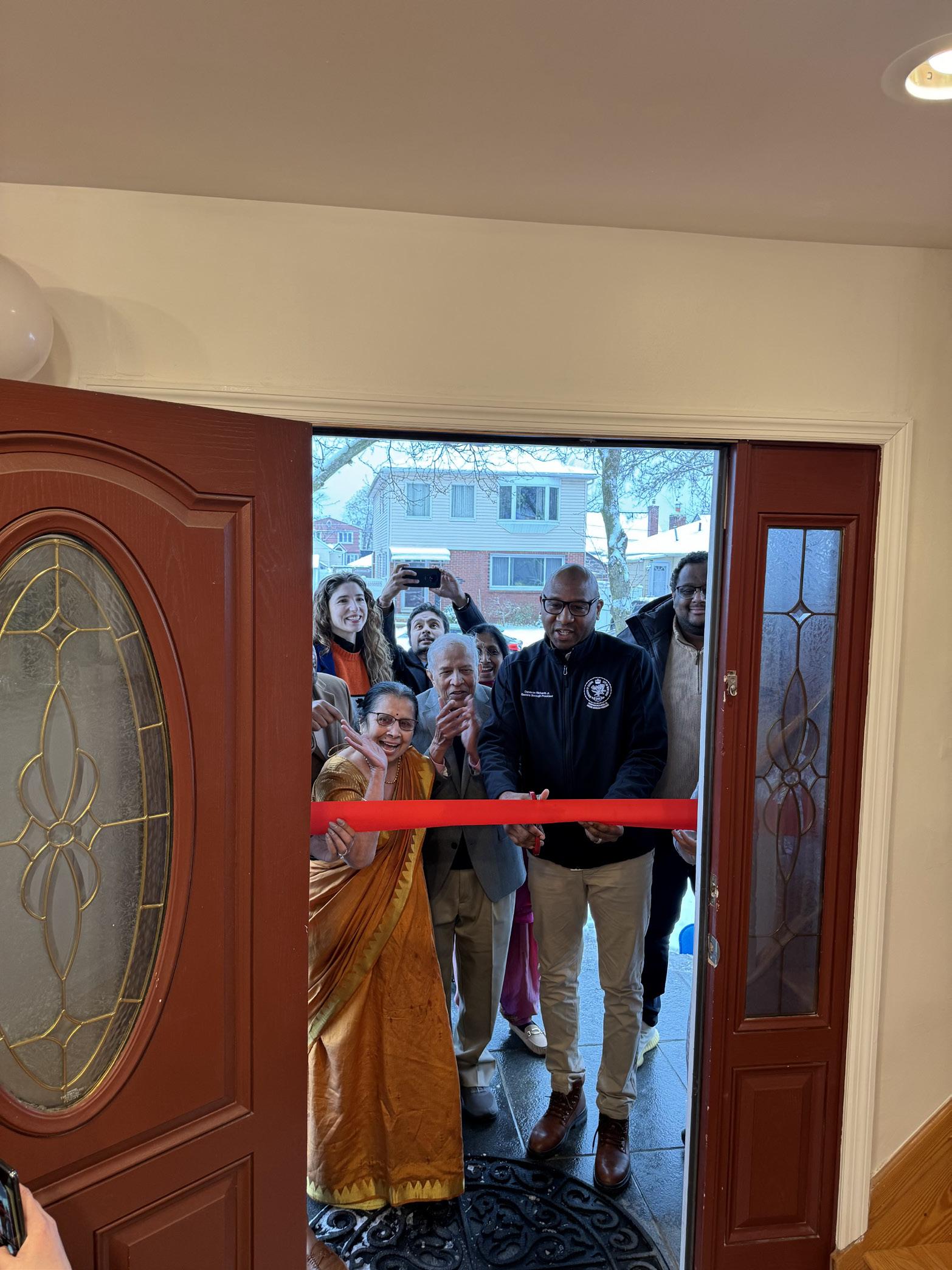
A burgeoning issue that complicates the housing crisis in New York is the rapidly aging population. The 65 and older pop ulation has increased by 53% since 2000, making the growth of the older population almost 17 times faster than that of the city’s total population. Asian Americans, which includes Indians, are the fastest-growing senior population in New York City. The Asian American and Hispanic senior popu lation doubled between 2000 and 2023, and the Black senior population has increased by 68% during the same time period. The increasing number of immigrants arriving in New York City from Asia and Latin Amer ica, fueled this growth.
nities have a history of multigenerational families living under one roof. The concept of coliving draws inspiration from the traditional model of joint families, a practice that has been part of immigrant communities for centuries. A 2024 study of independent retired women in co-living communities found that many residents viewed aging as a continuation of meaningful living rather than a decline. They embraced opportunities for lifelong learning, connection, and contribution and saw themselves as active, engaged members of their community rather than passive recipients of care. This mindset is beneficial across the board, and appears to include those in co-living spaces as well.
Samra Rashid, social work director at India Home Care shared that “coliving homes promote social and emotional well-being by creating opportunities for interaction, engagement, and a sense of belonging.” Rashid went on to say that coliving provides activities and support systems designed to combat loneliness and isolation, while promoting independence and personal growth.
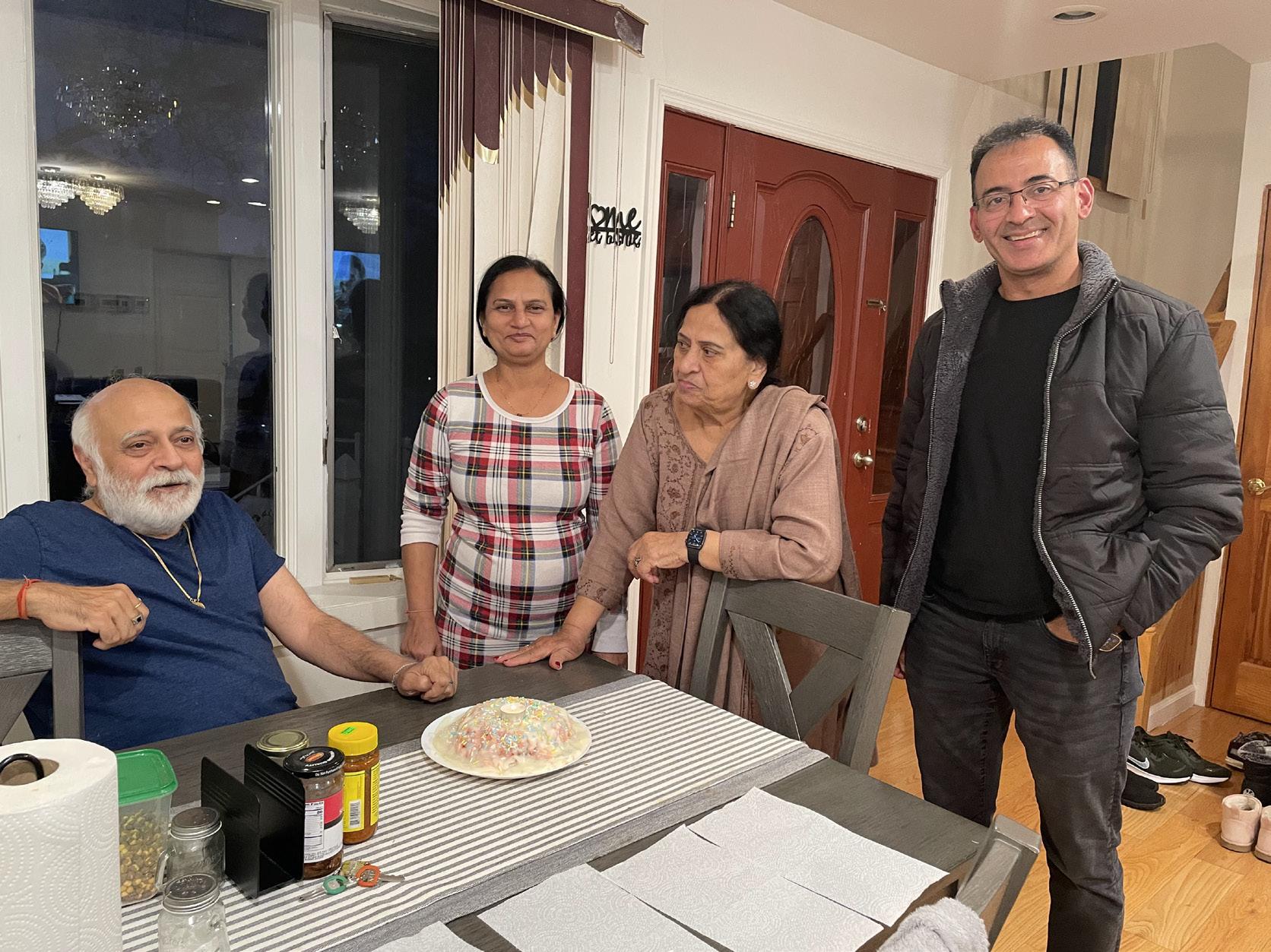
The convergence of aging, housing insecurity and immigration is a real issue in New York City.
Affordable housing for seniors is crucial as they often live on limited, diminished or no income other than social security benefits. With the average social security check for a 65-year-old being $1611 per month, and the median rent for a two bedroom in New York City at $3397 per month as of early 2025, housing security is a real prob-
lem for some of the city’s most vulnerable. As the city grapples with this multilayered problem, one facility has presented a promising model for a solution. India Home Care, a nonprofit organization founded in 2007 and dedicated to addressing the needs of the South Asian senior immigrant community, operates the coliving facility Ahuja moved into, located in Queens, New York City.
“Coliving addresses social isolation, and
housing needs while making use of existing housing in a quicker, more intimate and meaningful way,” said Sharaanya Pillai, deputy director at India Home Care.
A housing solution rooted in history and community
Coliving has historical roots in ancient agricultural communities, and communes of the hippie era, driven largely by the need for social contact, economic necessity, or a combination of both. Immigrant commu-
“Co-living works well when there are shared values and clear expectations,” explained Michelle Feng, Ph.D., a licensed psychologist with specialty training in geriatric psychology and medicine, “To maximize the positive impacts, it’s helpful to have a structured way for residents to participate, including organized community activities and shared responsibilities. This helps not just in clarifying roles and responsibilities, but can add to the sense of purpose and connection.”
Sudesh Kaboor, 84, also born in India, lives at the coliving facility in Queens operated by India Home Care. “It was an experiment. I was living with my son, and I wanted to try living alone. I wanted to also give my son’s family some privacy,” said Kaboor, an accessible place where her children can still visit every day.
The India Home Care coliving facility currently has four residents, all over 65. They all have individual rooms with their own bathroom, and share living spaces. The rent charged ranges from $1000 to $1400 per month. India Home subsidizes the cost to residents from their own funds, and also provides a weekly cleaning service and shelf-stable groceries.
“Coliving can be a culturally responsive way to support older adults, especially when shaped by the residents themselves,” explains Feng, “It’s most effective when residents help set the tone and norms of the community, and when cultural traditions are respected. That could include aspects like language access, familiar foods, and See story on next page
7/16/25, 1:33 PM
IMG 20250709 115044 heic
Opening of the center in Jan 2024, Mrs Mehta, Mukund Mehta, (board president), Queens Borough President Donovan Richards. (India Home Care photos)
Amit’s birthday celebration. Pictured from left to right - Amit Ahuja(resident), Maushami Shah (resident), Sudesh Kapoor (resident), and Sudesh’s son. (India Home Care photos)
caregiving practices that reflect residents’ values and backgrounds.”
Residents go to the adult day centers two days per week, and spend time at home or go out the rest of the days. Two of the four residents have jobs. Kaboor still cooks sometimes, favoring her native dhal and rice, and Ahuja loves spending time in the gardens outside. All four residents love playing card games together. “I love Rummy,” said Kaboor, “and sometimes I play it at the center too.”
Conflicts can occur at the coliving facility, like any other home.“In our unique living situation, we have encountered obstacles,” shares Rashid, “For instance, one senior may be an early riser, while another prefers to stay up late, leading to friction over daily agendas.” Conflicts can also arise from differences in cleaning standards, noise tolerance, temperature preferences, or personal space requirements.
While coliving for seniors may meet the social and cultural needs in some aging communities, it is not suitable for all. “Coliving may not work well for individuals who highly value personal control over their environment, struggle with compromise, or prefer solitude over shared responsibility,”said Feng.
“Those with advanced cognitive impairment without appropriate supports like dementia-informed design or caregiving infrastructure, can also pose challenges in co-living settings. This is particularly true when mutual participation is expected.”
NeighborWorks
they were saying, ‘Yes: We’re not just helping people get into their homes. We want their home to be an asset-building opportunity for the next generation as well.’ So we are absolutely making sure that people
India Home Care coliving facility does not admit seniors who need assisted living facilities, but does use their day centers to provide mental health support. With a predominantly South Asian community, discussions about mental health are not often welcome.
“To tackle this issue, we conduct monthly educational sessions on mental health at the day centers,” said Rashid. India Care Home also operates an adult daycare program that serves clients in the early to moderate stages of dementia and Alzheimer’s disease. The services include an on-site social worker who provides direct services three days a week for seniors, as well as support groups for their caregivers.
Access to affordable housing for all ages continues to be a problem in New York City. While there is no other senior living facility in New York comparable to India Home Care, there are housing developments in Florida that offer commercial versions of senior coliving. Creating coliving facilities with existing homes for older New Yorkers is possible, but until this and other suitable options are widely available, the NYC Department for the Aging has programs to help seniors with housing issues. NYC Aging works with the Mayor’s Public Engagement Unit and the Department of Finance to ensure that older qualified residents sign up for or renew their Senior Citizen Rent Increase Exemption (SCRIE) Program and the Disability Rent Increase Exemption (DRIE) Program.
Seniors at risk of eviction can get support through the Tenancy and Eviction Support
know what their options are; making sure that they have that plan in place for what’s going to happen to the home is definitely a part of our work.”
Douglas Robinson, NeighborWorks’ media relations expert, said that people need to know that a national organization like NeighborWorks America is focusing its funds and attention on educating local nonprofits about ways they can help fami-
Services (TESS). Additionally, there are three providers at the Legal As sistance for the Elderly Program that offer free legal services to older adults aged 60 years or older, in all five boroughs and in multiple lan guages. Assistance can include rep resentation, advice, counseling, and/or referrals in housing matters such as landlord/tenant disputes, foreclosure, and utility shut-offs. Where and how older New York ers live has a big impact on their overall health, particularly mental health. According to the San Diego Psychiatric Society, feelings of lone liness are linked to a risk of devel oping dementia, and other forms of cognitive decline. Some studies show an increased risk of 31% for all-cause dementia, and a 15% in crease for cognitive impairment. The bidirectional relationship be tween loneliness, depression and cognitive decline, causes one con dition to exacerbate the other. All of this can lead to an increased risk for premature death. Coliving can de crease social isolation and afford more opportunities to connect with others in closer proximity.
The reporting for this article was supported by a journalism fellow ship from the Gerontological Soci ety of America, Journalists Network on Generations, and Common wealth Fund.
lies navigate the property inheritance issue.
Three local organizations in New York City are part of the NeighborWorks net work. The Fifth Avenue Committee (FAC), Neighborhood Housing Services of New York City (NHSNYC), and Asian Americans for Equality have begun working with NeighborWorks on property inheritance issues.

“I think that what NeighborWorks wants erty, and to communicate that to every one so they all know. We have a blog post on our website by one of my colleagues about her family’s experience with property inheritance, and how people made assumptions about who’s going to live in grandma’s house, and those assumptions are not always correct.”
can’t step more than two feet into the establishment before she looks up from her station to greet you and offer support and expertise in choosing the night’s libation.
“She’s a serious oenophile, she’s very well versed,” says Elijah Servance, Market Manager for Ten To One Rum for the Tri-State area. He has only dealt with Kilolo in a professional capacity but says he’s had nothing but wonderful interactions since the first time he met her.
“I remember it was a really crappy, rainy day and she was there and just warm and welcoming. A few weeks later I booked my first tasting in the store and it’s just always been red carpet treatment.” Servance says he visits about 30
liquor stores monthly and, of them, about less than 25% are black owned and even less are women owned.
As a native New Yorker, Servance recognizes the cultural and communal shifts happening in the outer boroughs. Where Brooklyn used to be predominantly inhabited by people within the African diaspora, those people and communities have either left or been displaced. The importance of Fermented Grapes is beyond just being woman owned, it is also inadvertently “maintaining cultural presence,” he says, adding “Also showing acumen, as well, because to own a wine shop specifically you have to be well versed in these products, in these spirits. So, I think it’s just great to have that representation.”
Strobert acknowledges that being a Black woman in a predominantly non-Black male dominated space is both power and protest.
She encourages people interested in entering the wine space as a shop owner, winery owner, or sommelier to have discussions and build community with other likeminded individuals. She mentions groups like Anything
But Vinifera and Babe Winebar and how they are slowly building momentum for the queer BIPOC community in the natural wine space through events across the U.S. “These are all younger people,” she says. “All of these people are looking for spaces or building their communities around inclusivity and diversity.”
While Strobert is not natural wine focused, she does carry traditional, organic, and biodynamic wines in store, as well as, rums, vodkas, and her least favorite beverage to drink, Japanese sake. Though the store is not curated to her taste, Fermented Grapes’ Out the Box Wine Club is. She provides two bottles, once a month for about $70 with a tasting note directly from
her. “The wine club is based off of me. It’s what I like. It’s what I would want to drink everyday. I have a bomb ass palate,” she says laughing. The best part of the wine club? It’s exclusivity. “Once we run out in the store, the chance of you being able to get it again probably won’t happen.”
When she’s not helping customers directly, organizing shelves, or dealing with paperwork, Strobert is on Instagram promoting weekly Saturday tastings. “I didn’t want to do that. That came out of necessity,” she admits. However, the in-person vibe of Fermented Grapes and Strobert’s personality can be felt through the screen. In every reel, she’s laughing, she’s dancing, and she’s inviting. “I just think wine should be fun. Wine should be interesting, it should be approachable and my industry is very famous for making it the total opposite. I had to break through all of that to understand that I did have a place here.”
Amit in blue shirt cutting his birthday cake at his celebration at the coliving home. (India Home Care photo)
Bridging Two Worlds Through Telehealth

By RASHIDAH BERNAY FOWLER Special to AmNews
With the emergence of COVID19 in 2020, telehealth services have surged globally. According to the Center for Disease Control and Prevention (CDC) in the United States, March to June of 2020 saw an increase of 766% in all telehealth services. Since then, the percentage of physicians who have opted in using telemedicine has grown to 88% and with every industry on the upswing, marginalized communities were being left behind. However, it took a few who recognized the need and were equipped with the knowledge to
build out infrastructures to lead the charge in creating telehealth platforms that provided care to Black and Brown communities.
While on vacation with family in Mali, Mariam Diakité visited a clinic and saw the lack of care provided to some of the patients without the ability to pay. She witnessed a man being hassled for payment while his pregnant wife awaited a C-section.
“The time that they spend delaying because of payment, a life could be lost or another complication could arise,” says Diakité. She said she noticed how hard it was for people to see a doctor without money. It was something
let me start with where I’m from. And if I can make a difference there, then I can make a difference anywhere.”
As of 2024, the maternal mortality rate in Mali is 565 deaths to 100,000 live births — 80% of which are preventable, according to the National Institutes of Health (NIH). In the United States, Black and Brown birthing individuals also face disproportionately high maternal mortality rates compared to the national average. Targeted telehealth initiatives centered on these communities could play a pivotal role in reducing preventable deaths.
Currently, the 21-year-old is preparing to begin her senior
year at Hunter College. She is majoring in Human Biology with minors in both Africana Studies and Entrepreneurship. Her childhood aspiration was always to be a pediatrician because she wanted to help children. While working towards her degree completion and with at least another 10 years before becoming an actual doctor, Diakité is building out her Demé Health Network. She is aware of the additional efforts needed to grow her initiative due to her research and connecting with others in the nonprofit space whom she said, “rallied around me, they’d offered support.”
See TELEHEALTH continued on next page
that didn’t sit well with her. During this same trip, she got news that a friend of hers back home in the Bronx had passed away and after grieving, decided to move forward with the idea that she had been holding to honor his memory. The idea was the Demé Health Network initiative, a nonprofit organization dedicated to providing telehealth services to the Bronx and rural Mali. Diakité’s choice to focus on these two communities is because they are both home. Born and raised in the Bronx, Diakité is also Malian by ancestry and says, “I could do it here, but it’s also good to pour back to your homeland, as well. So, I said before I start anywhere,

Mariam Diakité, Founder of Demé Health Network (Mariam Diakité photos)
Continued from page 2
space for Harlem-based businesses, local unions are excited about the approval.
“As the largest union of property service workers in the country, including more than 90,000 residential and commercial property service workers in New York City, 32BJ supports responsible developers who invest in the communities where they build,” said 32BJ SEIU Secretary-Treasurer John Santos in a statement. “The One45 for Harlem developers have made a credible commitment to creating prevailing-wage
Madison J. Gray
investigative unit, Reyes will be heading to Stanford University in the fall where he will be a John S. Knight Journalism Fellow. He will transition to become an AmNews’ editor-at-large where he will advise and consult for the newspaper
jobs for the workers who will permanently staff the building. As the cost of living rises and working New Yorkers struggle to stay in their homes, it is more important now than ever to create affordable housing and good jobs [that] uphold the industry standard in the city — which is why we are proud to support this project.”
However, some housing activists and organizers are still deeply unhappy with the affordability level in the One45 development. A small group gathered at the Adam Clayton Powell Jr. State Office Building on West 125th Street last Friday, July 11, to protest at Salaam’s office.
The last step in the city’s Uniform Land
and occasionally contribute journalism as well.
“We are exceptionally grateful to Damaso Reyes who, working with Publisher Tatum, created Blacklight, the first ever investigative unit at a legacy Black newspaper and has served with distinction, vision and ambition as our first executive editor. We are so proud to have Madison, with his dis -
Affordability Agenda
Continued from page 13
Hochul is also committed to making New York the most business-friendly and worker-friendly state in the nation.
The Governor’s economic development and workforce proposals include new access to low-interest capital for small businesses, free community college for adults pursuing degrees in high-demand fields, enhancing the performance-based Excelsior Jobs Tax Credit with a new tier for semiconductor supply chain companies and protecting workers from wage theft. Let’s focus on the free tuition. Right now, there are over 400,000 jobs available in the State of New York. At the
same time, over four million adults ages 25 to 55 don’t have a college degree or credential, which is often the key to unlocking better paying jobs. So, here’s what we’re going to do — the State is going to pay for community college for those adults ages 25 to 55 who are studying to be in one of the indemand fields like healthcare, education, or technology. Because we know it’s often the cost that is the barrier.
If you’re working minimum wage and you’re trying to pay for childcare, and then maybe cover the cost of a community college to lift yourself up, it just doesn’t add up. But with this plan you
Use Review Procedure (ULURP) process is to have the project receive mayoral approval. Mayor Eric Adams is a huge proponent of building more housing across the city, as evidenced by his City of Yes for Housing Opportunity plan.
According to the developer, Bruce Teitelbaum, Adams is already in favor of the One45 project. “Thanks to Mayor Adams’ support and the backing of Councilmember Salaam, Harlem won today,” said Teitelbaum in a statement.
Salaam also announced that his office will have two street co-namings coming up, honoring influential Harlem figure Malcolm X and Salaam’s predecessor, the late Councilmember Bill Perkins. “The Bill Perkins Plaza, named after my mentor, champion, and friend, is a bittersweet moment,” Salaam said at the meeting. “[The] Honorable Bill Perkins exemplified what it means to have a seat at the table and to make sure that you were not on the menu. He was his own man and made bold moves, such as being the first elected official in New York to endorse thenSenator Barack Obama for president. This is Bill’s home, and now he will have a plaza forever reminding people of his impact on making this city great by fiercely defending and protecting the rights of all of its citizens.”
tinguished achievements and accomplishments, next in line to lead Amsterdam News’ storied and awardwinning newsroom,” emphasized Siobhan “Sam” Bennett, Amsterdam News President/CRO.
Over the past four years, the AmNews has experienced tremendous growth and raised the quality of its journalism. The newspaper and its staff have
won’t have to choose.
And we’re investing big in our small businesses and downtowns. The Affordability Agenda works hand in hand with the successful economic development programs we already have in our state, like the Downtown Revitalization Initiative and NY Forward program, to boost local businesses, improve housing, and create places where people want to live, work and play. And with this year’s budget, we will continue offering millions of dollars for communities in every region of our State to bring their downtowns into the 21st Century.
As of today, we have awarded more than $1 billion to more than 124 cities, towns and villages around the state. In New York City, Harlem was one of the winners of this program and we are
received awards from: The Deadline Club, The National Association of Black Journalists, The New York Press Association, The Newswomen’s Club of New York, The New York Association of Black Journalists, The Solutions Journalism Network, Editor & Publisher, The National Headline Awards, and The Local Media Association, among others.
working to help make it a great renaissance story of the city. We also have other communities such as Jamaica, Far Rockaway, Long Island City in Queens, and other areas in the Bronx, Brooklyn and Manhattan’s Chinatown, who are already seeing big differences in their communities because of these programs.
With the FY26 Budget and Governor Hochul’s 2025 Affordability Agenda, we are rewriting the New York story. This budget is about building a State where working families don’t just survive, they thrive.
This is more than a policy plan and a budget, it’s a promise to continue fighting for the working people and families in New York State and to make life more affordable for everyone.
With this initiative, Diakité will become one of the newer voices in the Black telehealth community. In 2020, Benjamin Lefever witnessing the lack of medical support for his immediate family and community was inspired to build out a telehealth service for his care management company, Certintell. That same year, Cheryle R. Jackson, the former CEO of Chicago Urban League — a nonprofit organization with the purpose of building a thriving community for Black Chicagoans — became CEO of Black Telehealth, a network claiming to have a list of premier Black health providers committed to delivering high-quality care.There
has even been a rise in telehealth in parts of Sub-Saharan Africa. In Mali, RAFT (Reseau Afrique Francophone pour la Télémédecine) network, provides most of the telehealth care connecting health care professionals to a number of French-speaking countries throughout the continent.
Diakité is working to establish herself in New York City and rural Mali. The Demé Health Network is supported by a team of medical professionals who are volunteering their time and services free of charge. Because the initiative is in its early stages, Diakité is actively seeking funding through a recently launched GoFundMe campaign. Additionally, Diakité is hoping to gather resources and supplies to send abroad. To learn more or to support this project, visit the Demé Health Network on Instagram at @DeméHealthNetwork.

Immigration agents demand tenant information from landlords, stirring questions and confusion
By R.J. RICO Associated Press
ATLANTA (AP) — Immigration authorities are demanding that landlords turn over leases, rental applications, forwarding addresses, identification cards, and other information about their tenants, a sign that the Trump administration is targeting them to assist in its drive for mass deportations.
Eric Teusink, an Atlanta-area real estate attorney, said several clients recently received subpoenas asking for entire files on tenants. A rental application can include work history, marital status, and family relationships.
The two-page “information enforcement subpoena,” which Teusink shared exclusively with the Associated Press, also asks for information about other people who lived with the tenant. One, dated May 1, is signed by an officer for the U.S. Citizenship and Immigration Services (USCIS) anti-fraud unit. However, it is not signed by a judge.
It is unclear how widely the subpoenas were issued, but they could signal a new front in the administration’s efforts to locate people who are in the country illegally, many of whom were required to give authorities their U.S. addresses as a condition for initially entering the country without a visa. President Donald Trump largely ended temporary status for people who were allowed in the country under his predecessor, Joe Biden.
Experts question whether landlords must comply
Some legal experts and property managers say the demands pose serious legal questions because they are not signed by a judge and that, if landlords comply, they might risk violating the Fair Housing Act, which prohibits discrimination on the basis of race, color, or national origin.
Critics also say landlords are likely to feel intimidated into complying with something that a judge hasn’t ordered, while the person whose information is being requested may never know that their private records are in the hands of immigration authorities.
“The danger here is overcompliance,” said Stacy Seicshnaydre, a Tulane University law professor who studies housing

law. “Just because a landlord gets a subpoena, doesn’t mean it’s a legitimate request.”
ICE officers have long used subpoenas signed by an agency supervisor to try to enter homes. Advocacy groups have mounted a “Know Your Rights” campaign, urging people to refuse entry if a subpoena was not signed by a judge.
The subpoena reviewed by the AP is from USCIS’s fraud detection and national security directorate, which, like ICE, is part of the Department of Homeland Security. Although it isn’t signed by a judge, it threatens that a judge may hold a landlord in contempt of court for failure to comply.
Tricia McLaughlin, a Homeland Security spokeswoman, defended the use of subpoenas against landlords without confirming if they are being issued.
“We are not going to comment on law enforcement’s tactics surrounding ongoing investigations,”
McLaughlin said. “However, it is false to say that subpoenas from ICE can simply be ignored. ICE is authorized to obtain records or testimony through specific administrative subpoena authorities. Failure to comply with an ICE-issued administrative subpoena may result in serious legal penalties. The media needs to stop spreading these lies.”
These requests are new to many landlords
Teusink said many of his clients oversee multifamily properties and are used to getting subpoenas for other reasons, such as requests to hand over surveillance footage or give local police access to a property as part of an investigation. However, he said, those requests are signed by a judge.
Teusink said his clients were confused by the latest subpoenas. After consulting with immigration attorneys, he concluded that compliance is optional. Unless signed
by a judge, the letters are essentially just an officer making a request.
“It seemed like they were on a fishing expedition,” Teusink said.
Boston real estate attorney Jordana Roubicek Greenman said a landlord client of his received a vague voicemail from an ICE official last month, requesting information about a tenant. Other local attorneys told her that their clients had received similar messages. She told her client not to call back.
Anthony Luna, CEO of Coastline Equity, a commercial and multifamily property management company that oversees about 1,000 units in the Los Angeles area, said property managers started contacting him a few weeks ago about concerns from tenants who heard rumors about the ICE subpoenas. Most do not plan to comply if they receive them.
“If they’re going after criminals, why aren’t they going through court documents?” Luna said.
“Why do they need housing pro-
vider files?”
ICE subpoenas preceded Trump’s first term in office, although they saw a significant uptick under him, according to Lindsay Nash, a law professor at Yeshiva University’s Cardozo School of Law in New York who has spent years tracking them. Landlords rarely got them, though. State and local police were the most common recipients.
ICE can enforce the subpoenas, but it would first have to file a lawsuit in federal court and get a judge to sign off on its enforcement — a step that would allow the subpoena’s recipient to push back, Nash said. She said recipients often comply without telling the person whose records are being divulged.
“Many people see these subpoenas, think that they look official, think that some of the language in them sounds threatening, and therefore respond, even when, from what I can tell, it looks like some of these subpoenas have been overbroad,” she said.
Immigration and Customs Enforcement (ICE) Enforcement and Removal Operations (ERO) in Los Angeles, California, June 12, 2025. (DHS photo by Tia Dufour)
2 dead in New Jersey after floodwaters carry away vehicle during heavy rains that hit Northeast

By SUSAN HAIGH and JENNIFER PELTZ Associated Press
Two people in New Jersey were killed after their vehicle was swept up in floodwaters during a storm that moved across the U.S. Northeast overnight, authorities said Tuesday.
Gov. Phil Murphy, a Democrat, noted the deaths occurred in the northern New Jersey city of Plainfield, where there were two stormrelated deaths on July 3. A third person was killed in North Plainfield during that previous storm.
“We’re not unique, but we’re in one of these sort of high-humidity, high-temperature, highstorm intensity patterns right now,” Murphy told reporters after touring storm damage in Berkeley Heights. “Everybody needs to stay alert.”
The names of the two latest victims were not immediately released on Tuesday. Local officials said the vehicle they were riding in was swept into a brook during the height of the storm.
“Emergency personnel responded quickly, but tragically, both individuals were pronounced dead at the scene,” according to a statement the city posted online.
The heavy rains also caused flash floods in New York and south-central Pennsylvania on Monday night into early Tuesday, prompting road closures and snarling some service on the New York City subway.
It was the second-highest onehour rainfall ever recorded in Central Park at more than 2 inches (5 centimeters), surpassed only by the remnants of Hurricane Ida in 2021, according to local officials.
Flooding in the New York City subway
Viral videos posted online showed water flooding down into one Manhattan subway station, submerging the platform while passengers in a train watched on.
Janno Lieber, chair and CEO of the Metropolitan Transportation Authority, told ABC 7 in New York that the city’s sewer system got overwhelmed by the rain and
backed up into the subway tunnels and to the stations. In several cases, he said, the backup “popped a manhole,” creating the dramatic “geyser” seen in some videos.
“What happened last night is something that is … a reality in our system,” he told the TV station, noting the backup happens when more than 1 3/4 inches of rain falls in an hour. “We’ve been working with the city of New York to try to get them to increase the capacity of the system at these key locations.”
City officials said their venerable sewer system worked as well as it could, but it simply was not built to handle that much rain.
“Imagine putting a two-liter bottle of water into a one-liter bottle. Some of it’s going to spill,” Environmental Protection Commissioner Rohit Aggarwala said at a virtual news briefing on Tuesday. Lieber said full service was restored to the subway, as well as commuter rails, after hundreds of people worked overnight to restore operations.
Flooding has proven to be a stubborn problem for New York’s subway system, despite years and billions of dollars’ worth of efforts to waterproof them.
Superstorm Sandy in 2012 prompted years of subway repairs and flood-fighting ideas, and some have been put into practice.
In some places, transit officials have installed or are installing storm barriers at subway station entrances, seals beneath subway air vents, and curbs to raise the vents and entrances above sidewalk level.
Meanwhile, summer thunderstorms and the remains of hurricanes have repeatedly flooded parts of the subway system anew.
In 2021, the remnants of Hurricane Ida killed more than a dozen New York City residents, largely in basement apartments, and sent water cascading again into subways, renewing attention to resiliency proposals.
Storm’s effects in New Jersey and Pennsylvania
The storm prompted multi-
ple water rescues in Lancaster County, Pennsylvania, where streets and basements flooded after roughly 7 inches (18 centimeters) of rain fell. Some roads remained closed in parts of Pennsylvania and New Jersey on Tuesday. Murphy said the pavement buckled in some locations, and state and local officials were assessing the level of damage in several counties, noting the White House had reached out to his office.
A major east-to-west highway in New Jersey was closed to make emergency repairs while dozens of flights were delayed or canceled at area airports on Tuesday. Most flash flood watches and warnings had expired in parts of New Jersey, New York, and Pennsylvania as the rain moved on.
In one flooded North Plainfield neighborhood, a house caught on fire and collapsed during the storm. Murphy said there was an explosion at the house but the family was not home and there were no injuries. The cause was under investigation.
Debris, rubble and a damaged car lie on a street after flooding from rains in the area of North Plainfield, N.J. (AP Photo/Seth Wenig)
A federal program helps NYC families eat healthy meals. Trump’s new legislation cuts it.
By ELIZA FAWCETT AND AMY ZIMMER ChalkbeatNY
This story was originally published by Chalkbeat. Sign up for their newsletters at ckbe.at/newsletters
On a sweltering afternoon this week, Ana Garcia, 41, and her 3-year-old son, Elliott, arrived at the Goodhue Community Center on Staten Island to pick up their weekly haul of fresh, affordable produce.
Garcia tasted a sample of tabbouleh salad. She and her son surveyed a spread of leafy greens, zucchini, summer squash, and peaches. For eight years, her family has returned regularly to buy a box of locally sourced produce. This week’s box — priced at $14, or $7 for those with Supplemental Nutrition Assistance Program, or SNAP, benefits — included a bounty of fresh fruit and vegetables, plus a recipe for tabbouleh.
“It’s awesome,” Garcia said. “We love coming here.”
But the Food Box program, administered by the nonprofit Children’s Aid, may not exist much longer. President Donald Trump’s “One Big Beautiful Bill” — passed by Congress and signed by Trump last week — eliminated funding for the Supplemental Nutrition Assistance Program Education, or SNAP-Ed, and made other changes to SNAP. SNAP-Ed, which funds nutrition education and anti-obesity initiatives nationwide, is set to expire on Sept. 30.
That will mean the disappearance of programs that help people on a limited budget eat healthier and shop smarter, teach children and families how to cook meals from scratch, and promote physically active lifestyles. Those efforts seem to align with the Trump administration’s Make America Healthy Again, or MAHA, initiative, but will be impacted nonetheless.
Advocates are bracing for how the legislation will affect childhood hunger across the city and state. Changes to SNAP, including new eligibility rules, could result in hundreds of thousands of parents losing their food benefits. In all, New York state is facing up to $1.4 billion in annual SNAP cuts and cost shifts, with the state expected to start covering $1.2 billion for the program by October 2027.
“Not just in New York, but nationwide, we will see increases in child hunger,” said Dr. Jennifer Cadenhead, a research assistant professor at Columbia’s Teachers College, who focuses on diet, food quality, and food insecurity issues. “That really makes me sad.”
While SNAP cuts might affect free school meals in other districts, New York City’s universal breakfast and lunch program is safe because the city’s high poverty rate will continue to qualify the whole school
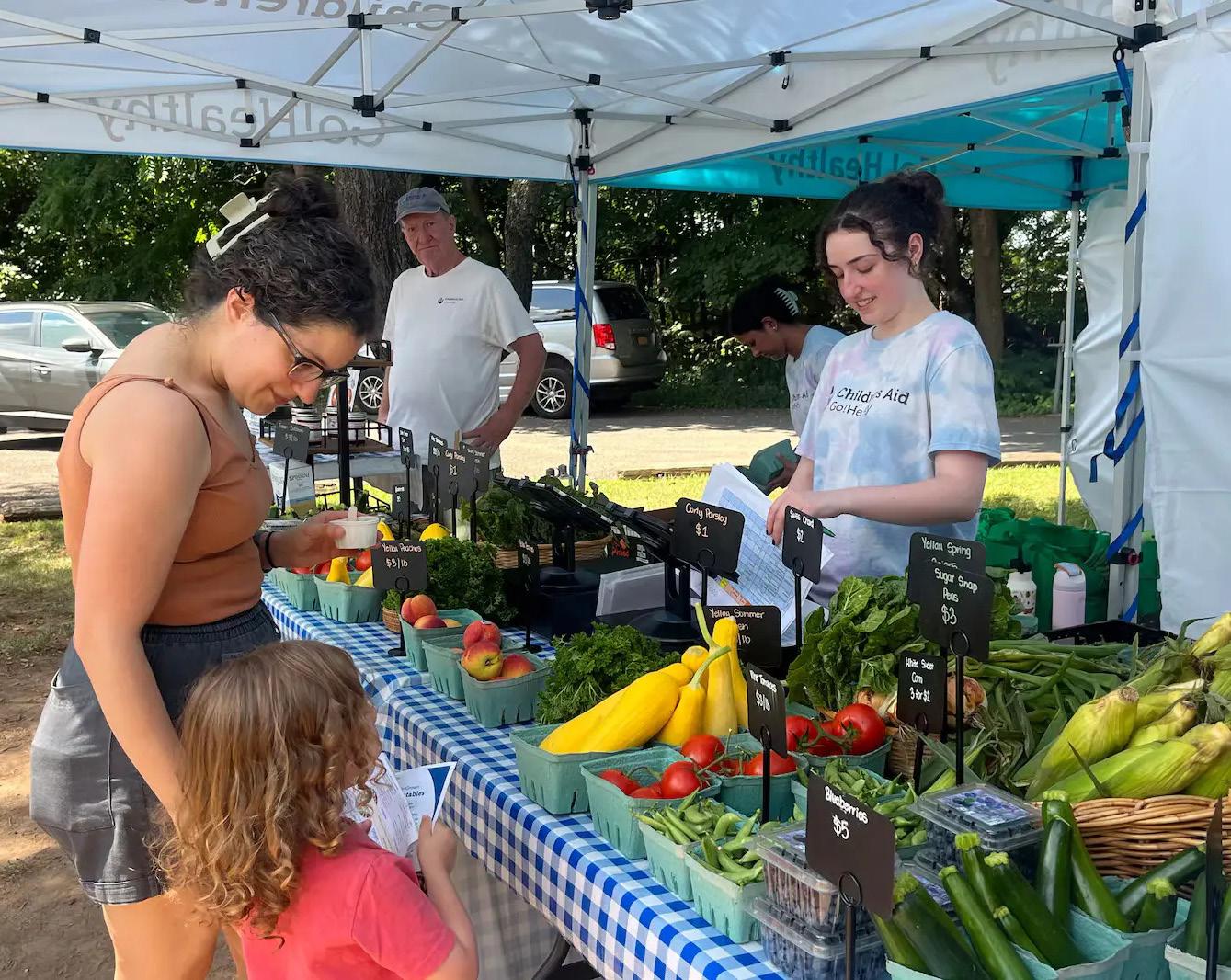
system for the program. But individual families will likely be hit hard, which could in turn lead to higher absenteeism rates and affect student performance.
On Staten Island, Garcia said that the end of the Food Box program would mean less fresh produce in her family’s diet — a loss for her two children.
“I want my kids to have all the vegetables,” she said.
Small program has a big impact
A roughly $536 million annual program with a 30-year history, SNAP-Ed is among the U.S. Department of Agriculture’s largest nutrition education programs. In a 2024 paper from the Journal of Nutrition Education and Behavior, researchers described it as a “critical pillar in the nation’s public health infrastructure.” Still, it’s a fraction of SNAP’s $99.8 billion in total spending in fiscal year 2024.
By offering evidence-based nutrition and food education, SNAP-Ed pays dividends for families’ long-term health, said Cadenhead, of Teachers College.
“A lot of times, a doctor will say, ‘You need to eat better,’ but people don’t know how,” she said. “They don’t know how to prepare a balanced meal. They may not have time. They don’t understand what they need to do, they can get overwhelmed in the grocery store.”
Funded with $29 million in federal dollars, New York’s SNAP-Ed programs reached over 2.2 million individuals across the state last fiscal year, through efforts like Eat Well Play Hard. That program educates pre-
schoolers on how their food is grown and encourages their caregivers to prepare and serve local produce to their families.
Darren O’Sullivan, a spokesperson for the state’s Office of Temporary and Disability Assistance, said in a statement that the federal legislation eliminating SNAPEd “increases the risk that New Yorkers in need will experience food insecurity, health issues, and economic hardship.”
Through the $1 million grant Children’s Aid gets through SNAP-Ed, the organization operates Food Box sites throughout the city, as well as programs in schools. Currently, the organization is running youth nutrition workshops and cooking demonstrations at Summer Rising sites, the city’s free summer school program.
“We hear from parents that their kids are coming home and asking, ‘Can we make this recipe at home?’” said Taisy Conk, director of food and nutrition programs at Children’s Aid. “This is opening up their palettes and their minds and getting them excited about it. It really makes an impact on children’s health.”
Through SNAP-Ed, Children’s Aid brought nutrition education to 20 sites, including 11 schools last year. The organization analyzed its programs’ impacts for the year before, and found that across its 176 workshops that reached nearly 430 kids, young people improved their vegetable consumption by 35%, with more than 60% reporting eating at least two fruits a day at the end of the course.
Conk said she worries that changes to SNAP will have far-reaching effects, with

people assuming they’re no longer eligible or struggling with new requirements. She said Children’s Aid is urging the city and state to explore some bridge funding to keep the programs going and is looking to philanthropy to help plug the gaps.
Families brace for reductions in fresh produce
On Staten Island, the Food Box stand was open during dismissal for a summer camp at the Goodhue Community Center. Some families stopped by to learn about the program or buy armfuls of corn.
“It’s been great to have affordable produce,” said Tara Messenger, 50, as she and her 9-year-old daughter collected their Food Box.
Without the Food Box program, Messenger, an art teacher, said she’d have to rely more on her local grocery store, and they’d likely eat more processed food.
“It wouldn’t be as fresh, as local, as affordable,” she said. “I probably wouldn’t have as many vegetables and fruits in our diet.”
Sarah Kabalkin, 46, a local culinary educator, said she worried that cuts to SNAP would have a “devastating” impact on her community, with more residents going hungry.
Losing the Food Box program would affect her family, she said. Without their weekly boxes of fresh produce, Kabalkin said she’d have to find a way to grow more in her community garden plots.
“I can’t produce this kind of variety,” she said. “So it will limit what we’re eating at home.”
Ana Garcia, 41, and her 3-year-old son, Elliott, pick up a Food Box at the Goodhue Community Center on Staten Island on Tuesday. (Eliza Fawcett / Healthbeat photos)
This “Food Box” includes fresh produce, including ingredients for tabbouleh salad and the recipe for it, at the Goodhue Community Center on Staten Island on Tuesday.
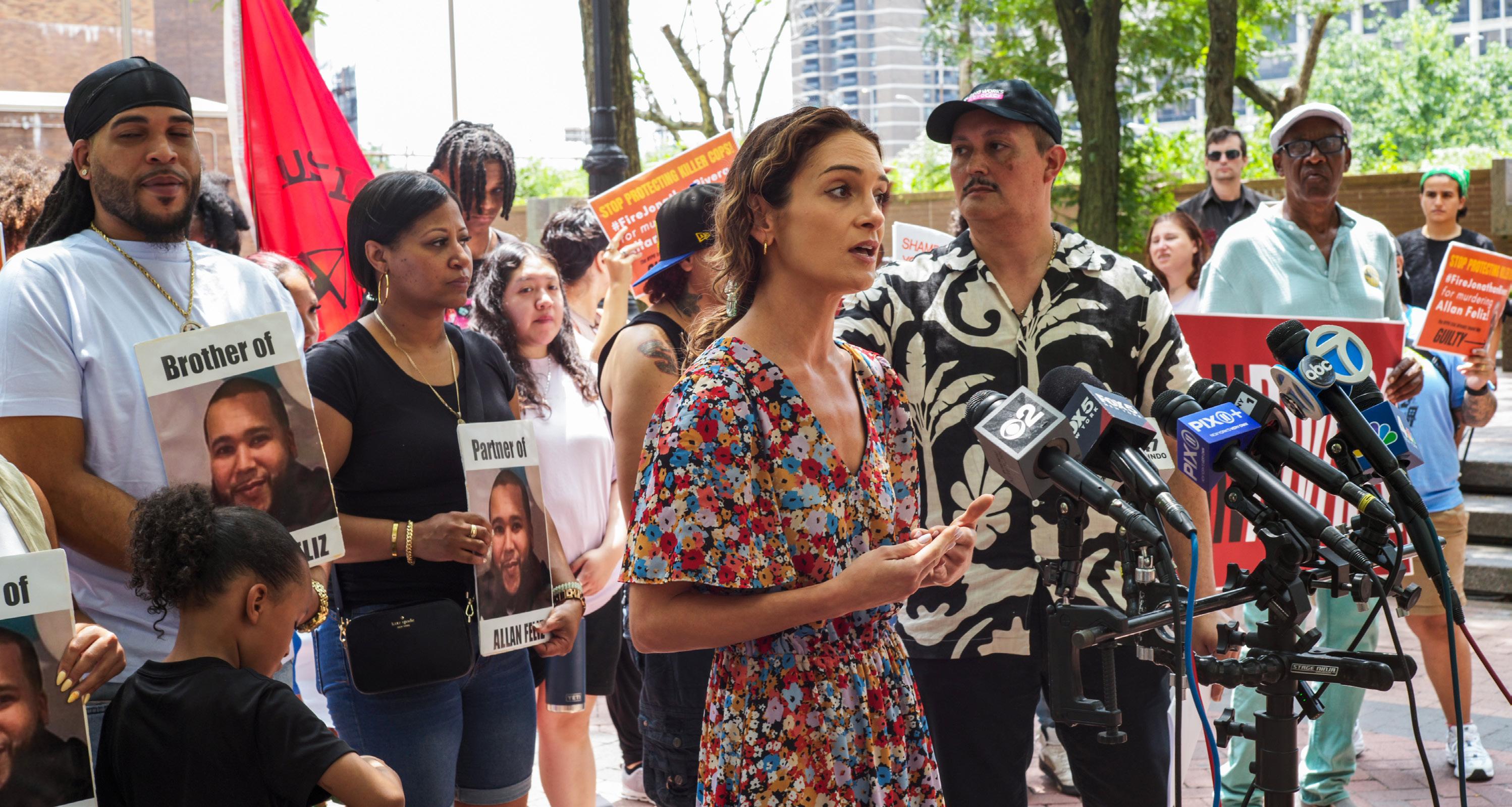
Allen Feliz
Continued from page 11
were some of many of the groups that have been alongside the Feliz family since Allan’s death. The family expressed their gratitude for the support they have been given from the groups.
“The support from the city is something that everyone wants, that everyone deserves as well. And especially if it’s members of your community and organizations that are highly thought about and respected in the community, it’s even more meaningful,” said Feliz.
Following the rally, the Feliz family and legal advocates hand delivered a letter from the Civilian Complaint Review Board in response to the decision. Friday was the last day for the CCRB to deliver a response. The family faced initial difficulty delivering the letter to Tisch from the visitor’s center.
Once the letter was delivered, the family rallied around City Hall. Though Friday was the last day for the CCRB to respond, Commissioner Tisch does not have a deadline to overturn the decision. If the response does not overturn the decision, the Verdeja says they will keep fighting.
“We’re only asking for justice, we’re only asking for accountability. It shouldn’t be too much to ask for, despite all the hurdles and obstacles that we face. So we will continue to explore what our next options are.” Ashley

Verdeja, sister of Allan, called the commissioner’s decision a “slap in the face.”
State Senator Julia Salazar called for Lt. Jonathan Rivera to be fired. (Damaso Reyes photos)
CLASSIFIED ADS
RULES AND REGULATIONS
CANCELLATIONS must be made in writing by 12 Noon Monday.
The forwarding of an order is construed as an acceptance of all advertising rules and conditions under which advertising space is sold by the NEW YORK AMSTERDAM NEWS. Publication is made and charged according to the terms of this card.
Rates and regulations subject to change without notice. No agreements as to position or regulations, other than those printed on this.
Til forbid orders charged for rate earned. Increases or decreases in space take the rate of a new advertisement.
The New York AMSTERDAM NEWS reserves the right to censor, reject, alter or revise all advertisements in accordance with its rules governin g the acceptance of advertising and accepts no liability for its failure to insert an advertisement for any cause. Credit for errors in advertisements allowed only for first insertion.
CLASSIFIED
• Classified advertisements take the regular earned rate of their classification. Four line minimum on all ads except spirituals and horoscopes (14 lines).
CLASSIFIED DISPLAY
• Classified Display (boarder or picture) advertisements take the regular earned rate of their classification. Display (boarder or picture) advertisements one column wide must be 14 lines deep; two columns, 28 lines deep; 3 columns, 56 lines deep. Classified Display (boarder or picture) placed as close to classifications as rules and makeup permit.
CLASSIFICATIONS
All advertisement accepted for publication is classified according to the standard classifications. Misclassification is not permitted.
BASIS OF CHARGE
Charges are based on point size and characters per line. Upon reaching 15 lines the rate converts to column inch. Any deviation from solid composition such as indentation, use of white space, bold type, etc., will incur a premium.
SUPREME COURT ‑ COUNTY OF NEW YORK.
CITIMORTGAGE, INC., Plaintiff ‑against‑ JADE D FONTENAY A/K/A JADE FONTENAY, et al Defendant(s). Pursuant to a Judgment of Foreclosure and Sale dated February 5, 2025 and entered on April 21, 2025, I, the under signed Referee will sell at pub lic auction in Room 130 of the New York County Courthouse, 60 Centre Street, New York, NY on August 6, 2025 at 2:15 p.m. premises situate, lying and being in the Borough of Manhattan, County, City and State of New York, known and designated as Unit known as Residential Unit No. 3D in the building known as "PS 90 Con dominium" together with an un divided 1.3082% interest in the Common Elements. Block: 2033 Lot: 1030
Said premises known as 220W 148TH STREET, 3D, NEW YORK, NY 10039
Approximate amount of lien $316,162.94 plus interest & costs.
Premises will be sold subject to provisions of filed Judgment and Terms of Sale.
If the sale is set aside for any reason, the Purchaser at the sale shall be entitled only to a return of the deposit paid. The Purchaser shall have no further recourse against the Mortgagor, the Mortgagee or the Mortgag ee’s attorney.
Index Number 850502/2023.
MATTHEW D. HUNTER III, ESQ., Referee David A. Gallo & Associates LLP
Attorney(s) for Plaintiff 47 Hillside Avenue, 2nd Floor, Manhasset, NY 11030 File# 7777.293
{* AMSTERDAM*}
NOTICE OF SALE SUPREME COURT COUNTY OF NEW YORK U.S. BANK NATIONAL ASSOCIATION, AS TRUSTEE FOR BANC OF AMERICA FUNDING CORPORATION MORTGAGE PASS-THROUGH CERTIFICATES, SERIES 2006-D, Plaintiff AGAINST DEVIKA KAMBOH, ET AL., Defendant(s) Pursuant to a Judgment of Foreclosure and Sale duly entered April 4, 2025, I, the undersigned Referee will sell at public auction at the New York County Courthouse in Room 130, located at 60 Centre Street, New York, NY on August 6, 2025 at 2:15 PM, premises known as 630 1st Avenue, Unit 34E, New York, NY 10016. All that certain plot piece or parcel of land, with the buildings and improvements erected, situate, lying and being in the Borough of Manhattan, County, City and State of New York, Block 968 Lot 1464. Approximate amount of judgment $1,156,389.64 plus interest and costs. Premises will be sold subject to provisions of filed Judgment Index #850534/2023. Mark McKew, Esq., Referee Gross Polowy, LLC 1775 Wehrle Drive Williamsville, NY 14221 23-001521 85402
NOTICE OF SALE SUPREME COURT COUNTY OF NEW YORK Wilmington Savings Fund Society, FSB, not in its individual capacity but solely as Owner Trustee of CSMC 2018SP3 Trust, Plaintiff AGAINST Sreeram Mallikarjun; et al., Defendant(s) Pursuant to a Judgment of Foreclosure and Sale duly entered April 23, 2025, I, the undersigned Referee, will sell at public auction in room 130 at the New York County Courthouse, 60 Centre Street, New York, NY 10007 on August 13, 2025, at 2:15PM, premises known as 350 West 42nd Street Apartment 53C, New York, NY 10036. The Condominium Unit (the "Unit") in the premises known as Orion Condominium and by the street number 350 West 42nd Street, Borough of Manhattan, City, County and State of New York, Block 1032 Lot 1484. Approximate amount of judgment $1,206,958.02 plus interest and costs. Premises will be sold subject to provisions of filed Judgment Index# 850224/2021. Doron Leiby, Esq., Referee LOGS Legal Group LLP f/k/a Shapiro, DiCaro & Barak, LLC Attorney(s) for the Plaintiff 175 Mile Crossing Boulevard Rochester, New York 14624 (877) 430-4792 Dated: May 8, 2025 85618
NOTICE OF SALE SUPREME COURT. NEW YORK COUNTY. WELLS FARGO BANK, NATIONAL ASSOCIATION, AS TRUSTEE, FOR THE BENEFIT OF THE HOLDERS OF CD 2019-CD8 MORTGAGE TRUST COMMERCIAL MORTGAGE PASSTHROUGH CERTIFICATES, SERIES 2019-CD8, Pltf. vs. 63 SPRING LAFAYETTE, LLC, et al Deft. Index# 850042/2022. Pursuant to judgment of foreclosure and sale entered April 23, 2025, I will sell at public auction in Room 130 of the New York County Courthouse, 60 Centre Street, New York, NY on August 13, 2025 at 2:15 p.m. prem. k/a 63 Spring Street, New York, NY a/k/a Block 496, Lot 34. Approximate amount of judgment is $28,125,967.56 plus cost and interest. Sold subject to terms and conditions of filed judgment and terms of sale.
ELAINE SHAY, Referee. BALLARD SPAHR LLP, Attys. for Pltf., 1675 Broadway, 19 Floor, New York, NY. #102355
Notice of Formation of a NY Limited Liability Company. Name: Bar4Bar Rap League LLC. Articles of Organization filing date with Secretary of State (SSNY) was 01/18/2025. Office location: New York County. SSNY has been designated as agent of LLC upon whom process against it may be served and SSNY shall mail copy of process to 228 Park Ave S PMB 446776New York, New York 10003-1502 US. Purpose is to engage in any and all business activities permitted under NYS laws.
NOTICE OF SALE SUPREME COURT COUNTY OF NEW YORK U.S. BANK TRUST NATIONAL ASSOCIATION, NOT IN ITS INDIVIDUAL CAPACITY BUT SOLELY AS OWNER TRUSTEE FOR RCF 2 ACQUISITION TRUST, Plaintiff AGAINST ANDREW G. DYSART, ET AL., Defendant(s) Pursuant to a Judgment of Foreclosure and Sale duly entered January 24, 2025, I, the undersigned Referee will sell at public auction at the New York County Courthouse in Room 130, located at 60 Centre Street, New York, NY on August 6, 2025 at 2:15 PM, premises known as 170 West 23rd Street, Apt. 6J, New York, NY 10011. All that certain plot piece or parcel of land, with the buildings and improvements erected, situate, lying and being in the Borough of Manhattan, City, County and State of New York, Block 798 Lot 1116. Approximate amount of judgment $514,274.44 plus interest and costs. Premises will be sold subject to provisions of filed Judgment Index #850661/2023. Matthew D. Hunter III, Esq., Referee Gross Polowy, LLC 1775 Wehrle Drive Williamsville, NY 14221 23002684 85151
NOTICE OF SALE SUPREME COURT COUNTY OF New York, U.S. Bank Trust National Association, As Trustee For LB-Dwelling Series V Trust, Plaintiff, vs. Kimberly Ann Busi a/k/a Kimberly A. Busi a/k/a Kimberly Busi, ET AL., Defendant(s). Pursuant to a Judgment of Foreclosure and Sale and Decision + Order on Motion duly entered on February 18, 2025, I, the undersigned Referee will sell at public auction at Room 130 of the New York County Courthouse, 60 Centre Street, New York, NY 10007 on July 30, 2025 at 2:15 p.m., premises known as 1 Wall Street Court, Unit 605 a/k/a 82 Beaver Street, Unit 605, New York, NY 10005. All that certain plot, piece or parcel of land, with the buildings and improvements thereon erected, situate, lying and being in the Borough of Manhattan, County of New York, City and State of New York, Block 28 and Lot 1043 together with an undivided 1.5944 percent interest in the Common Elements. Approximate amount of judgment is $1,129,124.74 plus interest and costs. Premises will be sold subject to provisions of filed Judgment Index #850472/2023. Tom Kleinberger, Esq., Referee Friedman Vartolo LLP, 85 Broad Street, Suite 501, New York, New York 10004, Attorneys for Plaintiff. Firm File No.: 223745-1
NOTICE OF SALE
SUPREME COURT: NEW YORK COUNTY CI NOTES LLC v. 7 TH REALTY HOLDINGS, LLC et al.
Pursuant to a Judgment of Foreclosure and Sale dated April 11, 2025 and filed with the Clerk of the Supreme Court, New York County on April 17, 2025, bearing Index no. 850657/2023, I will sell at public auction on Wednesday, August 13, 2025 at 2:15 pm in Room 130 of the New York County Supreme Courthouse, 60 Centre Street, New York, New York 10007 the premises known as 2291 7th Avenue a/k/a 2291 Adam C. Powell Jr. Blvd., New York, NY 10030 (Block: 1919, Lot: 63). Premises sold subject to filed Judgment of Foreclosure and Sale and Terms of Sale. Judgment amount $1,382,233.85 plus interest and costs. The foreclosure sale will be conducted in accordance with the New York County Supreme Court Policies. Location and time are subject to revision based on Court policy, current protocols and health conditions. It is requested that Auction attendees practice social distancing whenever possible.
Roberta Ashkin, Esq., Referee. Harry Zubli, Esq., attorney for plaintiff (516) 487-5777. SUPREME COURT-NEW YORK COUNTY- HILTON RESORTS CORP., Pltf. v. MARTINA SMITH, Deft. - Index # 850486/2024. Pursuant to Judgment of Foreclosure and Sale dated June 2, 2025, I will sell at public auction in Room 130 of the New York County Courthouse located at 60 Centre Street, New York, NY on Thursday, July 24, 2025, at 2:15 pm, an interest of an undivided 0.00493200000% tenant in common interest in the timeshare known as 57TH STREET VACATION SUITES located at 102 West 57th Street, New York, NY. Approximate amount of judgment is $19,544.14 plus costs and interest as of March 13, 2025. Sold subject to terms and conditions of filed Judgment and Terms of Sale which includes annual maintenance fees and charges. Doron Leiby, Esq., Referee. Cruser, Mitchell, Novitz, Sanchez, Gaston, & Zimet LLP, Attys. for Pltf., 341 Conklin Street, Farmingdale, NY.
Notice of Qualification of STORAGE POST / 4396 BROADWAY, LLC Appl. for Auth. filed with Secy. of State of NY (SSNY) on 06/20/25. Office location: NY County. LLC formed in Delaware (DE) on 06/03/25. SSNY designated as agent of LLC upon whom process against it may be served. SSNY shall mail process to Corporation Service Co., 80 State St., Albany, NY 12207-2543. DE addr. of LLC: 251 Little Falls Dr., Wilmington, DE 19808. Cert. of Form. filed with Secy. of State, Div. of Corps., John G. Townsend Bldg., 401 Federal St. - Ste. 4, Dover, DE 19901. Purpose: Any lawful activity.
SUPREME COURT-NEW YORK COUNTY- HILTON RESORTS CORP., Pltf. v. VANESSA TASHINGA NGARU, Deft. - Index # 850485/2024. Pursuant to Judgment of Foreclosure and Sale dated June 2, 2025, I will sell at public auction in Room 130 of the New York County Courthouse located at 60 Centre Street, New York, NY on Thursday, July 24, 2025, at 2:15 pm, an interest of an undivided 0.00493200000% tenant in common interest in the timeshare known as 57TH STREET VACATION SUITES located at 102 West 57th Street, New York, NY. Approximate amount of judgment is $23,610.46 plus costs and interest as of March 13, 2025. Sold subject to terms and conditions of filed Judgment and Terms of Sale which includes annual maintenance fees and charges. Doron Leiby, Esq., Referee. Cruser, Mitchell, Novitz, Sanchez, Gaston, & Zimet LLP, Attys. for Pltf., 341 Conklin Street, Farmingdale, NY.
Notice of Formation of US OVERSIGHT PROPERTIES LLC Arts. of Org. filed with Secy. of State of NY (SSNY) on 07/08/25. Office location: NY County. Princ. office of LLC: 641 Lexington Ave., 15th Fl., NY, NY 10022. SSNY designated as agent of LLC upon whom process against it may be served. SSNY shall mail process to the LLC at the addr. of its princ. office. Purpose: Any lawful activity.
NOTICE OF SALE, SUPREME COURT, NEW YORK COUNTY NewBank v. 43 Mott Realty Owner LLC et al. , Index No. 850034/2022
Pursuant to a Judgment of Foreclosure and Sale dated January 31, 2025 (the “Judgment”), I will sell at public auction to the highest bidder in Room 130 of the Supreme Court of the State of New York, County of New York, 60 Centre Street, New York, New York 10007 on July 30, 2025 at 2:15 p.m. the premises known as 43-45 Mott Street, New York, New York 10013, Borough of Manhattan, Block 164, Lots 28 and 29 (the “Premises”). The approximate amount of the Judgment is $554,281.17, plus interest, costs, attorneys’ fees, and disbursements. The Premises will be sold subject to the provisions of the Judgment and terms of sale. Said auction will be conducted “rain or shine.”
Christy Demelfi, Esq., Referee
Plaintiff’s attorneys: Meyer, Suozzi, English & Klein, P.C. 990 Stewart Avenue, 3rd Floor Garden City, New York 11530 516-741-6565 (tel.) 516-741-6706 (fax)
Uwabideli Brands LLC Arts. of Org. filed with the SSNY on March 12, 2025. Office location: Bronx County. SSNY has been designated as an agent upon whom process against it may be served & shall mail to: 5680 Broadway #1039, Bronx, NY 10463. Purpose: Any lawful act.
NOTICE OF SALE
SUPREME COURT - COUNTY OF NEW YORK
DEUTSCHE BANK NATIONAL TRUST COMPANY AS TRUSTEE FOR HARBORVIEW MORTGAGE LOAN TRUST 2007-2,
SUPREME COURT - COUNTY OF NEW YORK
DEUTSCHE BANK NATIONAL TRUST COMPANY AS TRUSTEE FOR HARBORVIEW MORTGAGE LOAN TRUST
2007-2,
Plaintiff, Against HARVEY LEVINE, CAROLE LEVINE, ET AL
Plaintiff, Against HARVEY LEVINE, CAROLE LEVINE, ET AL
Defendant(s)
Defendant(s)
Pursuant to a Judgment of Foreclosure and Sale, duly entered 09/13/2024, I, the undersigned Referee, will sell at public auction, in Room 130 at 60 Centre Street, New York, NY 10007 on 8/13/2025 at 2:15PM, premises known as 455 Central Park West, Unit 17B, New York, New York 10025, and described as follows:
Pursuant to a Judgment of Foreclosure and Sale, duly entered 09/13/2024, I, the undersigned Referee, will sell at public auction, in Room 130 at 60 Centre Street, New York, NY 10007 on 8/13/2025 at 2:15PM, premises known as 455 Central Park West, Unit 17B, New York, New York 10025, and described as follows:
ALL that certain plot piece or parcel of land, with the buildings and improvements thereon erected, situate, lying and being in the Condominium Unit (Hereinafter Referred To As The "Unit") Known As Unit No. 17B In The Premises Known As 455 Central Park West Condominium, And By The Street Number 455 Central Park West, Borough Of Manhattan, County City And State Of New York. TOGERTHER with an undivided 0.625% percent interest in the Common Elements. Block 01841 Lot 1276
ALL that certain plot piece or parcel of land, with the buildings and improvements thereon erected, situate, lying and being in the Condominium Unit (Hereinafter Referred To As The "Unit") Known As Unit No. 17B In The Premises Known As 455 Central Park West Condominium, And By The Street Number 455 Central Park West, Borough Of Manhattan, County City And State Of New York. TOGERTHER with an undivided 0.625% percent interest in the Common Elements. Block 01841 Lot 1276
The approximate amount of the current Judgment lien is $3,088,341.91 plus interest and costs. The Premises will be sold subject to provisions of the aforesaid Judgment of Foreclosure and Sale; Index # 850318/2014
Roberta Ellen Ashkin, Esq., Referee.
The approximate amount of the current Judgment lien is $3,088,341.91 plus interest and costs. The Premises will be sold subject to provisions of the aforesaid Judgment of Foreclosure and Sale; Index # 850318/2014
Roberta Ellen Ashkin, Esq., Referee.
MCCABE, WEISBERG & CONWAY, LLC, 10 Midland Avenue, Suite 205, Port Chester, NY 10573
MCCABE, WEISBERG & CONWAY, LLC, 10 Midland Avenue, Suite 205, Port Chester, NY 10573
Dated: 6/4/2025 File Number: 17-301350 CA
Dated: 6/4/2025 File Number: 17-301350 CA
DRINK X FRESH LLC Arts. of Org. filed with the SSNY on 5/18/2025. Office location: NEW YORK County. SSNY has been designated as an agent upon whom process against it may be served & shall mail to: 228 PARK AVE S#715255, NEW YORK, NY, 10003. Purpose: Any lawful act.
WRM HOLDING LLC Arts. of Org. filed with the SSNY on 01/31/2025. Office location: NY County. SSNY has been designated as an agent upon whom process against it may be served & shall mail to: 2O ATLAS COURT, EAST MEADOW, NY 11554. Purpose: Any lawful act.
GROUNDED STARS LLC Arts. of Org. filed with the SSNY on 03/19/2025. Office location: New York County. SSNY has been designated as an agent upon whom process against it may be served & shall mail to: 535 Fifth Avenue, 4th Floor, #1021, New York, NY 10017 Purpose: Any lawful act.
ITSHAK HOLTZ FINE ART LLC Arts. of Org. filed with the SSNY on 12/3/2024. Office location: NY County. SSNY has been designated as an agent upon whom process against it may be served & shall mail to: Registered Agents Ince, 418 Broadway, STE R, Albany, NY 12207. Purpose: Any lawful act.
NOTICE OF SALE SUPREME COURT. NEW YORK COUNTY. USALLIANCE FEDERAL CREDIT UNION BY MERGER WITH NEW YORK METRO FEDERAL CREDIT UNION, Pltf. vs., UNKNOWN HEIRS AT LAW OF JAMES MCCASKILL A/K/A JAMES MC CASKILL, HIS NEXT OF KIN, DISTRIBUTEES, EXECUTORS, ADMINISTRATORS, TRUSTEES, DEVISEES, LEGATEES, ASSIGNEES, LIENORS, CEDITORS, AND SUCCESSORS IN INTEREST, AND GENERALLY ALL PERSONS HAVING OR CLAIMING, UNDER, BY OR THROUGH SAID DEFENDANT WHO MAY BE DECEASED, BY PURCHASE, INHERITANCE, LIEN OR OTHERWISE, ANY RIGHT TITLE OR INTEREST IN AND TO THE PREMISES DESCRIBED IN THE COMPLAINT HEREIN, ALL OF WHOM AND WHOSE NAMES AND PLACES OF RESIDENCE ARE UNKNOWN TO THE PLAINTIFF AND CANNOT AFTER DILIGENT INQUIRY BE ASCERTAINED, et al Deft. Index #850257/2022. Pursuant to judgment of foreclosure and sale entered August 12, 2024, I will sell at public auction on July 30, 2025 at 2:15 p.m. prem. k/a 61 West 126 th Street, New York, NY 10027 a/k/a Block 1724, Lot 11. Approximate amount of judgment is $180,402.84 plus cost and interest. Sold subject to terms and conditions of filed judgment and terms of sale and the right of the United States of America to redeem within 120 days from the date of sale as provided by law. CHRISTY M. DEMELFI, Referee., MARGOLIN, WEINREB & NIERER, LLP., Attys. for Pltf., 575 Underhill Blvd., Suite 224, Syosset, NY. #102268
SUPREME COURT ‑ COUNTY OF NEW YORK.
ALMA BANK, Plaintiff ‑against‑ N.V. JUDSON CORPORATION, et al Defendant(s). Pursuant to a Judgment of Foreclosure and Sale dated April 11, 2025 and entered on April 28, 2025 I, the undersigned Referee will sell at public auction in Room 130 of the New York County Court house, 60 Centre Street New York, NY on August 20, 2025 at 2:15 p.m. premises situate, lying and being in the Borough of Manhattan, City, County and State of New York, known and designated as Unit No. 29G in the condominium known as "Olympic Tower Condomini um" together with an undivided .2213396% interest in the com mon elements. Block: 1287 and Lot: 1063
Said premises known as 641 5TH AVENUE, UNIT NO. 29G, NEW YORK, NY 10022
Approximate amount of lien $2,004,580.73 plus interest & costs.
Premises will be sold subject to provisions of filed Judgment and Terms of Sale. Index Number 850068/2023. MATTHEW D. HUNTER III, ESQ., Referee
SHERMAN ATLAS SYLVES TER & STAMELMAN LLP
Attorney(s) for Plaintiff 1185 Avenue of the Americas, 3rd Floor, New York, NY 10036 {* AMSTERDAM*}
EL REY VENTURES LLC Arts. of Org. filed with the SSNY on 12/17/2024. Office location: NY County. SSNY has been designated as an agent upon whom process against it may be served & shall mail to: 136 Madison Avenue, New York, NY 10016. Purpose: Any lawful act.
NOTICE OF SALE SUPREME COURT - COUNTY OF NEW YORK. BOARD OF MANAGERS OF THE 610 PARK AVENUE CONDOMINIUM, Plaintiff -against16EF APARTMENT, LLC and MARA ENTERPRISES, et al Defendant(s). Index Number 151261/2023.
Pursuant to a Judgment of Foreclosure and Sale and Decision + Order on Motion duly entered herein and dated September 29, 2023, I, the undersigned Referee will sell at public auction located in Room 130 of the New York County Courthouse, 60 Centre Street New York, NY New York on July 30, 2025 at 2:15 p.m. E.T.,
premises situate, all that certain plot, piece or parcel of land, with the buildings and improvements thereon erected, lying and being in the Borough of Manhattan, City, County and State of New York, known as Unit No. PH16E in the building designated as 610 Park Avenue Condominium. Together with an undivided 4.0581% interest in the common elements. Block: 1379 Lot: 1189 Said premises known as 610 PARK AVENUE, PH16E, NEW YORK, NEW YORK 10065
Approximate amount of lien is $171,820.02 plus post-judgment interest & costs. Premises will be sold subject to provisions of the filed Judgment of Foreclosure and Sale and Decision + Order on Motion and Terms of Sale. CHRISTY M. DEMELFI, ESQ., Referee
Sheppard, Mullin, Richter & Hampton, LLP
Attn: Benjamin O. Gilbert bogilbert@sheppardmullin.com
Attorney(s) for Plaintiff 30 Rockefeller Plaza, New York, NY 10112 (212) 896-0682 {* AMSTERDAM*}
SUPREME COURT - COUNTY OF NEW YORK CITIMORTGAGE, INC., Plaintiff -against- TREVOR C. MORAN, et al Defendant(s). Pursuant to a Judgment of Foreclosure and Sale entered herein and dated April 22, 2022, I, the undersigned Referee will sell at public auction at the New York County Courthouse located in Room 130 of the New York County Courthouse, 60 Centre Street New York, NY on August 6, 2025 at 2:15 p.m. The Unit known as Residential Unit No. 10A in the building known as The Heritage at Trump Place, 240 Riverside Boulevard, in the Borough of Manhattan, City, County and State of New York, Together with an undivided 0.7911% interest in the common elements. Block: 1171 Tax Lot: 2111. Said premises known as 240 RIVERSIDE BOULEVARD, UNIT 10A, NEW YORK, NY 10069. Approximate amount of lien $5,673,292.89 plus interest & costs. Premises will be sold subject to provisions of filed Judgment and Terms of Sale. If the sale is set aside for any reason, the Purchaser at the sale shall be entitled only to a return of the deposit paid. The Purchaser shall have no further recourse against the Mortgagor, the Mortgagee or the Mortgagee’s attorney. Index Number 850110/2019.
THOMAS KLEINBERGER, ESQ., Referee, David A. Gallo & Associates LLP, Attorney(s) for Plaintiff 47 Hillside Avenue, 2nd Floor, Manhasset, NY 11030. File# 5025.1930
SUPREME COURT - COUNTY OF NEW YORK. NYCTL 1998-2 TRUST AND THE BANK OF NEW YORK MELLON, AS COLLATERAL AGENT AND CUSTODIAN, Plaintiffs -against- CIAO-DI RESTAURANT CORPORATION, et al Defendant(s). Pursuant to a Judgment of Foreclosure and Sale entered herein on March 31, 2025, I, the undersigned Referee will sell at public auction in Room 130 of the New York County Courthouse, 60 Centre Street New York, NY on July 30, 2025 at 2:15 p.m. premises situate, lying and being in the Borough of Manhattan, County of New York, City and State of New York, known and designated as Block 552 and Lot 1322, 1323 and 1327 on the New York County Tax Assessment Map, and being further known on such tax rolls as 88 Washington Place a/k/a West Washington Place, Unit S6, Unit S7 and S11, New York, NY 10011.
Said premises known as 88 WASHINGTON PLACE, UNIT S6, UNIT S7 AND UNIT S11, NEW YORK, NY 10011
Approximate amount of lien $14,968.16 plus interest & costs.
Premises will be sold subject to provisions of filed Judgment and Terms of Sale. Index Number 154141/2023. SOFIA BALILE, ESQ., Referee Phillips Lytle LLP Attorney(s) for Plaintiffs 28 East Main Street, Suite 1400, Rochester, NY 14614
{* AMSTERDAM*}
SUPREME COURT - COUNTY OF NEW YORK. 7G 123 LAFAYETTE LLC, Plaintiff -against- 123 LAFAYETTE LLC, et al Defendant(s). Pursuant to a Judgment of Foreclosure and Sale entered herein and dated March 5, 2025, I, the undersigned Referee will sell at public auction in Room 130 of the New York County Courthouse, 60 Centre Street New York, NY on July 30, 2025 at 2:15 p.m. premises situate, lying and being in the Borough of Manhattan, County, City and State of New York, bounded and described as follows: BEGINNING at a point on the easterly side of Lafayette Street, distant 95 feet 8-5/8 inches northerly from the corner formed by the intersection of the northerly side of Canal Street and the easterly side of Lafayette Street; being a plot 51 feet 6 inches by 62 feet 9 inches by 51 feet 9-3/4 inches by 62 feet 9 inches. Block: 208 Lot: 4
Said premises known as 123127 LAFAYETTE STREET, NEW YORK, NY
Approximate amount of lien $21,759,120.80 plus interest & costs.
Premises will be sold subject to provisions of filed Judgment and Terms of Sale.
Index Number 850316/2024. ALLISON FURMAN, ESQ., Referee
Warshaw Burstein, LLP
Attorney(s) for Plaintiff 575 Lexington Avenue, 7th Floor, New York, NY 10022
{* AMSTERDAM*}
Clear Process Engineering LLC Arts. of Org. filed with the SSNY on 5/14/2025. Office location: NY County County. SSNY has been designated as an agent upon whom process against it may be served & shall mail to: 19376 N. 9th St., Covington, LA 70433. Purpose: Any lawful act.
MTA Procurement
The MTA encourages vendors who have not done business with us to register for our bidders list using MY MTA Portal for vendors at www. mymta.info. Registered vendors can search for procurement opportunities across all MTA agencies and receive invitations to bid or propose on the types of goods and services they can provide. Certified minority and women-owned businesses (M/WBE), service-disabled veteran-owned businesses (SDVOB), and disadvantaged businesses (DBE), are strongly encouraged to compete for MTA opportunities. Visit our website at https://new.mta.info/doing-business-with-us for detailed information and guidelines.
NOTICE OF SALE SUPREME COURT. NEW YORK COUNTY. FLUSHING BANK, Pltf. vs. GACH, LLC
A/K/A PBAK LLC, et al Deft. Index #850038/2024. Pursuant to judgment of foreclosure and sale entered April 25, 2025, I will sell at public auction in Room 130 of the New York County Courthouse, 60 Centre Street, New York, NY on August 20, 2025 at 2:15 p.m. prem. k/a 43 East 25 th Street, Unit C6, New York, NY 10016 a/k/a Block 855, Lot 1007. The Unit known as Unit No. C6 in the Building known as The Stanford, located at 43-51 East 25 th Street in the Borough of Manhattan, County of New York, City and State of New York and also designated and described as Unit No. C6 in the Declaration establishing the Standford (hereinafter called the “Property”), made under the Condominium Act of the State of New York as amended ( Article 9-B of the Real Property Law of the State of New York dated March 31, 1986 and recorded in the New York County Office of the Register of the City of New York on May 5, 1986 in Reel 1058 Page 1675 as amended by Amendment to Declaration dated August 8, 1986 and recorded September 5, 1986 in Reel 1113 Page 464 and further amended by Second Amendment dated June 22, 1987 and recorded July 20, 1987 in Reel 12362 Page 1345 and further amended Third Amendment dated October 15, 1987 and recorded December 8, 1987 in Reel 1328 Page 2003 and by Fourth Amendment dated June 13, 1988 and recorded June 17, 1988 in Reel 1418 Page 442). Which Unit is also designated as Tax Lot No. 1007 in Block 866 of Section 3 on the Floor Plans of the Building, certified by Liebman, Liebman Associates, P.C. on the 23 rd day of April 1986 and filed simultaneously with said Declaration in the said Office of the Register of the City of New York, County of New York as Map No. 4454. Together with an undivided 3.2788% percent interest in the Common Elements of the Condominium. Approximate amount of judgment is $1,188,476.36 plus cost and interest. Sold subject to terms and conditions of filed judgment and terms of sale. JERRY MEROLA, Referee. CERTILMAN BALIN ADLER & HYMAN, LLP Attys. for Pltf., 100 Motor Parkway, Ste. 560, Hauppauge, NY 11788. File No. 12914.0513- #102291
Notice of Formation of KIRKWOOD HOUSE ACQUISITION, LLC Arts. of Org. filed with Secy. of State of NY (SSNY) on 06/18/25. Office location: NY County. Princ. office of LLC: 30 Hudson Yards, 72nd Fl., NY, NY 10001. SSNY designated as agent of LLC upon whom process against it may be served. SSNY shall mail process to Corporation Service Co., 80 State St., Albany, NY 12207. Purpose: Any lawful activity.
REFEREE'S NOTICE OF SALE IN FORECLOSURE
SUPREME COURT - COUNTY OF NEW YORK
APSEC RESOLUTION, LLC, A DELAWARE LIMITED LIABILITY COMPANY, Plaintiffagainst - WEST 21ST ASSOCIATES LLC, et al Defendant(s).
Pursuant to a Judgment of Foreclosure and Sale entered on March 4, 2025. I, the undersigned Referee will sell at public auction in Room 130 of the New York County Courthouse located at 60 Centre Street, New York, New York 10007 on the 6th day of August, 2025 at 2:15 PM. All that certain plot, piece or parcel of land, situate, lying and being in the Borough of Manhattan, County of New York, City and State of New York. Premises known as 34 West 21st Street, New York, NY 10010.
(Block: 822, Lot: 59)
Approximate amount of lien $8,820,122.46 plus interest and costs.
Premises will be sold subject to provisions of filed judgment and terms of sale.
Index No. 850497/2023. Jeffrey Robert Miller, Esq., Referee. McCalla Raymer Leibert Pierce, LLC
Attorney(s) for Plaintiff
420 Lexington Avenue, Suite 840
New York, NY 10170
Tel. 347/286-7409
Dated: March 20, 2025
During the COVID-19 health emergency, bidders are required to comply with all governmental health requirements in effect at the time of sale including but not limited to, wearing face coverings and maintaining social distancing (at least 6-feet apart) during the auction, while tendering deposit and at any subsequent closing. Bidders are also required to comply with the Foreclosure Auction Rules and COVID-19 Health Emergency Rules issued by the Supreme Court of this County in addition to the conditions set forth in the Terms of Sale
Notice of Formation of ALAN MENKEN LLC Arts. of Org. filed with Secy. of State of NY (SSNY) on 06/16/25. Office location: NY County. Princ. office of LLC: c/o Fulton Vittoria LLP, One Rockefeller Plaza, Ste. 301, NY, NY 10020. SSNY designated as agent of LLC upon whom process against it may be served. SSNY shall mail process to the LLC at the addr. of its princ. office. Purpose: Any lawful activity.
NOTICE OF SALE SUPREME COURT NEW YORK COUNTY
MORGAN STANLEY PRIVATE BANK, NATIONAL ASSOCIATION, Plaintiff against
PHILIP LAJAUNIE, et al Defendant(s)
Attorney for Plaintiff(s) Stern & Eisenberg, P.C., 20 Commerce Drive, Suite 230, Cranford, NJ 07016 and 1131 Route 55, Suite 1, Lagrangeville, NY 12540.
Pursuant to a Judgment of Foreclosure and Sale entered October 21, 2024, I will sell at public auction to the highest bidder at Motion Support Room 130 in the New York Supreme Court, 60 Centre Street, New York, New York 10007 on August 20, 2025 at 2:15 PM. Premises known as 62 East First Street, Unit 4S, New York, NY 10003. Block 443 Lot 1108. All that certain plot, piece or parcel of land, situate lying and being the Borough of Manhattan, City, County and State of New York. Approximate Amount of Judgment is $1,609,440.57 plus interest, fees, and costs. Premises will be sold subject to provisions of filed Judgment Index No 850341/2018.
During the COVID-19 health emergency, Bidders are required to comply with all governmental health requirements in effect at the time of the sale including but not limited to wearing face coverings and maintaining social distancing (at least 6-feet apart) during the auction, while tendering deposit and at any subsequent closing. Should a bidder fail to comply, the Referee may refuse to accept any bid, cancel the closing and hold the bidder in default. Bidders are also required to comply with the Foreclosure Auction Rules and COVID-19 Health Emergency Rules issued by the Supreme Court of this County in addition to the conditions set forth in the Terms of Sale. Referee will only accept a certified bank check made payable to the referee.
Paul Sklar, Esq., Referee File # NY201800001401-1
NOTICE OF FORMATION OF MULLEN, ARMS & FITZPATRICK LLP.
Articles of Organization filed with the Secretary of State of NY (SSNY) on 05/16/2025. Office Location: New York County.
SSNY has been designated as agent upon whom process against it may be served. The Post Office address to which the SSNY shall mail a copy of any process against the LLP served upon him/her is: 745 Fifth Avenue Suite 500 New York, NY 10151.
The principal business address of the LLP is 745 Fifth Avenue Suite 500 New York, NY 10151. Purpose: Practice of Law.
225 Willow LLC Arts. of Org. filed with the SSNY on July 13, 2025. Office location: Bronx County. SSNY has been designated as an agent upon whom process against it may be served & shall mail to: 601 Wales Ave, Bronx, NY 10455 Purpose: Any lawful act.
NOTICE OF SALE
SUPREME COURT COUNTY OF New York , Stormfield Opportunity Fund, LP , Plaintiff, vs . Glotser Living, LLC , ET AL., Defendant(s).
Pursuant to a Consent Judgment of Foreclosure and Sale duly entered on April 9, 2025 , I, the undersigned Referee will sell at public auction at Room 130 of the New York County, 60 Centre Street, New York, NY 10007 on August 13, 2025 at 2:15 p.m., premises known as 166 East 63rd Street, Unit 16D, Manhattan, NY 10065. All that certain plot, piece or parcel of land, with the buildings and improvements thereon erected, situate, lying and being in the Borough of Manhattan, County of New York, City and State of New York, Block 1397 and Lot 1341 together with an undivided 0.611252 percent interest in the Common Elements, as well as all personal property of Borrower as identified in that certain Mortgage, Assignment of Rents, Security Agreement and Fixture Filing, dated as of September 17, 2021, and recorded on October 7, 2021 as CRFN 2021000395478, and excluding any funds held by Plaintiff in any reserve, escrow, or suspense fund, and excluding any funds held by Plaintiff in any cash management account. Approximate amount of judgment is $970,128.57 plus interest and costs. Premises will be sold subject to provisions of filed Judgment Index #850572/2023. Roberta Ashkin, Esq., Referee Polsinelli PC, Aaron P. Davis, Esq., 600 Third Avenue, 42nd Floor, New York, New York 10016, Attorneys for Plaintiff
NOTICE OF SALE
SUPREME COURT: NEW YORK COUNTY. NYCTL 2021A TRUST AND THE BANK OF NEW YORK MELLON AS COLLATERAL AGENT AND CUSTODIAN, Pltf. vs., JILA SOROUDI, Defts. Index #157345/2022. Pursuant to for judgment of foreclosure and sale entered May 8, 2024 and order extending time to sell entered July 12, 2024 and decision and order entered April 16, 2025, I will sell at public auction in Room 130 of the New York County Courthouse, 60 Centre Street, New York, NY on August 13, 2025 at 2:15 p.m. prem. k/a 150 West 51 st Street, Unit 155, New York, NY 10019 a/k/a Block 01003 Lot 1240. Judgments amount $52,273.92 Sold subject to terms and conditions of filed judgment and terms of sale. DORON LEIBY, Referee. THE DELLO-IACONO LAW GROUP, P.C., Attys. For Pltf., 312 Larkfield Road, Lower Level, East Northport, NY. File No. 22-000027 - #102297
Notice of Qualification of TWO SIGMA PULSAR PORTFOLIO, LLC
Appl. for Auth. filed with Secy. of State of NY (SSNY) on 06/04/25. Office location: NY County. LLC formed in Delaware (DE) on 03/25/25. SSNY designated as agent of LLC upon whom process against it may be served. SSNY shall mail process to the LLC, 100 Ave. of the Americas, 16th Fl., NY, NY 10013. DE addr. of LLC: Corporation Service Co., 251 Little Falls Dr., Wilmington, DE 19808. Cert. of Form. filed with Secy. of State of the State of DE, Div. of Corps., John G. Townsend Bldg., 401 Federal St., Ste. 4, Dover, DE 19901. Purpose: Any lawful activity.
Notice of Qualification of TRYON PROPERTY OWNER, LP Appl. for Auth. filed with Secy. of State of NY (SSNY) on 05/29/25. Office location: NY County. LP formed in Delaware (DE) on 04/27/18. Princ. office of LP: 440 S. Church St., Ste. 880, Charlotte, NC 28202. NYS fictitious name: TRYON PROPERTY OWNER, L.P. Duration of LP is Perpetual. SSNY designated as agent of LP upon whom process against it may be served. SSNY shall mail process to Corporation Service Co., 80 State St., Albany, NY 12207-2543. Name and addr. of each general partner are available from SSNY. DE addr. of LP: 251 Little Falls Dr., Wilmington, DE 19808. Cert. of LP filed with DE Secy. of State, 401 Federal St., Ste. 4, Dover, DE 19901. Purpose: Any lawful activity.
Notice of Qualification of NMG Term Loan PropCo LLC Appl. for Auth. filed with Secy. of State of NY (SSNY) on 05/20/25. Office location: NY County. LLC formed in Delaware (DE) on 04/29/19. SSNY designated as agent of LLC upon whom process against it may be served. SSNY shall mail process to Corporation Service Co. (CSC), 80 State St., Albany, NY 122072543. DE addr. of LLC: c/o CSC, 251 Little Falls Dr., Wilmington, DE 19808. Cert. of Form. filed with Secy. of State, John G. Townsend Bldg., 401 Federal St., Ste. 3, Dover, DE 19901. Purpose: Any lawful activity.
Notice of Qualification of WING AVIATION LLC Appl. for Auth. filed with Secy. of State of NY (SSNY) on 07/03/25. Office location: NY County. LLC formed in Delaware (DE) on 05/16/17. SSNY designated as agent of LLC upon whom process against it may be served. SSNY shall mail process to Corporation Service Co., 80 State St., Albany, NY 12207-2543. DE addr. of LLC: 251 Little Falls Dr., Wilmington, DE 19808. Cert. of Form. filed with Secy. of State, John G. Townsend Bldg., 401 Federal St., Ste. 4, Dover, DE 19901. Purpose: Any lawful activity.
CUSHION MENTAL HEALTH
COUNSELING PLLC Arts. of Org. filed with the SSNY on 6/23/25. Office location: NY County. SSNY has been designated as an agent upon whom process against it may be served & shall mail to: 374 W 116TH STREET, NEW YORK, NY 10026. Purpose: Any lawful act.
Notice of Qualification of TWO SIGMA PULSAR ENHANCED FUND, LP
Appl. for Auth. filed with Secy. of State of NY (SSNY) on 06/04/25. Office location: NY County. LP formed in Delaware (DE) on 03/24/25. NYS fictitious name: TWO SIGMA PULSAR ENHANCED FUND, L.P. Duration of LP is Perpetual. SSNY designated as agent of LP upon whom process against it may be served. SSNY shall mail process to the Partnership, 100 Ave. of the Americas, 16th Fl., NY, NY 10013. Name and addr. of each general partner are available from SSNY. DE addr. of LP: Corporation Service Co., 251 Little Falls Dr., Wilmington, DE 19808. Cert. of LP filed with Secy. of State of the State of DE, John G. Townsend Bldg., 401 Federal St., Ste. 4, Dover, DE 19901. Purpose: Any lawful activity.
Notice of Qualification of ADVANTAGE SALES & MARKETING LLC Appl. for Auth. filed with Secy. of State of NY (SSNY) on 06/18/25. Office location: NY County. LLC formed in Nevada (NV) on 12/30/24. Princ. office of LLC: 8001 Forsyth Blvd., Ste. 1025, Clayton, MO 63105. SSNY designated as agent of LLC upon whom process against it may be served. SSNY shall mail process to Corporation Service Co., 80 State St., Albany, NY 12207-2543. Cert. of Form. filed with Secy. of State, 101 N. Carson St., Ste. 3, Carson City, NV 89701. Purpose: Any lawful activity.
Notice of Qualification of CSIP VII GENERAL PARTNER, LLC Appl. for Auth. filed with Secy. of State of NY (SSNY) on 06/10/25. Office location: NY County. LLC formed in Delaware (DE) on 03/11/25. SSNY designated as agent of LLC upon whom process against it may be served. SSNY shall mail process to Corporation Service Co. (CSC), 80 State St., Albany, NY 12207-2543. DE addr. of LLC: c/o CSC, 251 Little Falls Dr., Wilmington, DE 19808. Cert. of Form. filed with Secy. of State of the State of DE, 401 Federal St., Ste. 3, Dover, DE 19901. Purpose: Any lawful activity.
Notice of Qualification of HANDSOME BROOK FARM, LLC Appl. for Auth. filed with Secy. of State of NY (SSNY) on 06/11/25. Office location: NY County. LLC formed in Delaware (DE) on 08/03/16. SSNY designated as agent of LLC upon whom process against it may be served. SSNY shall mail process to the LLC, 555 W. 57th St., Ste. 1103B, NY, NY 10019. DE addr. of LLC: 251 Little Falls Dr., Wilmington, DE 19808. Cert. of Form. filed with DE Secy. of State, Div. of Corps., John G. Townsend Bldg., 401 Federal St. - Ste. 4, Dover, DE 19901. Purpose: Any lawful activity.
Notice of Qualification of STORAGE POST / 4388 BROADWAY, LLC Appl. for Auth. filed with Secy. of State of NY (SSNY) on 06/20/25. Office location: NY County. LLC formed in Delaware (DE) on 06/03/25. SSNY designated as agent of LLC upon whom process against it may be served. SSNY shall mail process to Corporation Service Co., 80 State St., Albany, NY 12207-2543. DE addr. of LLC: 251 Little Falls Dr., Wilmington, DE 19808. Cert. of Form. filed with DE Secy. of State, Div. of Corps., John G. Townsend Bldg., 401 Federal St. - Ste. 4, Dover, DE 19901. Purpose: Any lawful activity.
Notice of Qualification of REDUS EL, LLC Appl. for Auth. filed with Secy. of State of NY (SSNY) on 01/23/25. Office location: NY County. LLC formed in Delaware (DE) on 02/03/09. Princ. office of LLC: 401 S. Tryon St., Charlotte, NC 28202. SSNY designated as agent of LLC upon whom process against it may be served. SSNY shall mail process to Corporation Service Co., 80 State St., Albany, NY 12207-2543. DE addr. of LLC: 251 Little Falls Dr., Wilmington, DE 19808-1674. Cert. of Form. filed with DE Secy. of State-Div. of Corps., 401 Federal St., Ste. 4, Dover, DE 19901. Purpose: Any lawful activity.
Notice of Formation of LEAPS AND HURDLES, LLC Arts. of Org. filed with Secy. of State of NY (SSNY) on 05/28/25. Office location: NY County. SSNY designated as agent of LLC upon whom process against it may be served. SSNY shall mail process to the LLC, 2410 8th Ave., Apt. 13F, NY, NY 10027. Purpose: Any lawful activity.
Notice of Formation of NEKO HEALTH 2 LLC Arts. of Org. filed with Secy. of State of NY (SSNY) on 05/28/25. Office location: NY County. SSNY designated as agent of LLC upon whom process against it may be served. SSNY shall mail process to Corporation Service Co., 80 State St., Albany, NY 12207-2543. Purpose: Any lawful activity.
Notice of Formation of NEKO HEALTH 3 LLC Arts. of Org. filed with Secy. of State of NY (SSNY) on 05/28/25. Office location: NY County. SSNY designated as agent of LLC upon whom process against it may be served. SSNY shall mail process to Corporation Service Co., 80 State St., Albany, NY 12207-2543. Purpose: Any lawful activity.
V76 LLC Arts. of Org. filed with the SSNY on May 21, 2025. Office location: New York County. SSNY has been designated as an agent upon whom process against it may be served & shall mail to: C/O Dontzin Kolbe & Fleissig LLP, 31 East 62nd Street, 7th Floor, New York, NY 10065. Purpose: Any lawful act.
CRG CAPITAL GROUP LLC Arts. of Org. filed with the SSNY on 05/08/2025. Office location: NY County. SSNY has been designated as an agent upon whom process against it may be served & shall mail to: 134 West 29th Street, 4th Fl, New York, NY 10001. Purpose: Any lawful act.
Empire Data Advisory LLC Arts. of Org. filed with the SSNY on June 16th, 2025. Office location: New York County. SSNY has been designated as an agent upon whom process against it may be served & shall mail to: 26 Cornelia St., New York, New York, 10014. Purpose: Any lawful act.
Greater Harlem Chamber SPV1, LLC LLC Arts. of Org. filed with the SSNY on 5/8/25 Office location: New York County. SSNY has been designated as an agent upon whom process against it may be served & shall mail to: 200A W136th Street, New York, NY 10030. Purpose: Any lawful act.
GEMSIGHT LLC Arts. of Org. filed with the SSNY on 08/04/2023. Office location: NEW YORK County. SSNY has been designated as an agent upon whom process against it may be served & shall mail to: 300 E 40TH ST, APT 8F, NEW YORK NY 10016. Purpose: Any lawful act.
GUNBAI LLC Arts. of Org. filed with the SSNY on 5/31/2025. Office location: New York County. SSNY has been designated as an agent upon whom process against it may be served & shall mail to: 313 W 22nd St, Apt 1B, New York, NY 10011. Purpose: Any lawful act.
Etico Managment LLC Arts. of Org. filed with the SSNY on 1/29/2025. Office location: New York County. SSNY has been designated as an agent upon whom process against it may be served & shall mail to: 211 Thomspon Street APT 2E, New York, NY 10012. Purpose: Any lawful act.
SUPREME COURT - COUNTY OF NEW YORK.
WOORI AMERICA BANK, Plaintiff -against- DK BEAUTY INC., et al Defendant(s). Pursuant to a Judgment of Foreclosure and Sale entered herein and dated March 27, 2025, I, the undersigned Referee will sell at public auction in Room 130 of the New York County Courthouse, 60 Centre Street New York, NY on August 6, 2025 at 2:15 p.m. premises situate, lying and being in the Borough of Manhattan, County, City and State of New York, known as Unit No. 2010 in the building known as the "20 West 33rd Street Condominium" together with an undivided 7.1629 percent interest in the common elements.
Block: 834 Lot: 1013
Said premises known as 18-28 WEST 33RD STREET, UNIT 2010, NEW YORK, NY Approximate amount of lien $6,021,316.46 plus interest & costs.
Premises will be sold subject to provisions of filed Judgment and Terms of Sale. Index Number 850042/2024.
SOFIA BALILE, ESQ., Referee Bronstein, Gewirtz & Grossman, LLC
Attorney(s) for Plaintiff 40 Calumet Ave, Lake Hiawatha, NJ 07034 {* AMSTERDAM*}
Notice is hereby given that a license, serial #NA-0340-25100961 for beer, wine & liquor has been applied for by the undersigned to sell beer, wine & liquor at retail in a restaurant under the ABC Law at 507 Columbus Ave., New York, NY 10024 for on-premises consumption; Eshel Avraham Mediterranean Grill LLC
West Atlantic Law Firm, PLLC Arts. of Org. filed with the SSNY on 05/08/2025. Office location: New York County. SSNY has been designated as an agent upon whom process against it may be served & shall mail to: 104 West 40th Street, Suite 400 , New York, NY, 10018 Purpose: Any lawful act.
Kimbro LLC filed w/ SSNY 6/22/04. Off. in NY Co. Process served to SSNY - desig. as agt. of LLC & mailed to Mike Katz, 630 Third Ave, 23rd Fl, NY, NY 10017. Any lawful purpose.
TEACHER
Preschool Teacher (3K-UPK). Brooklyn, NY. Create daily lesson plans, plan creativeactivities, teach classes for preschool children, organize group games, supervise children in classroom and on playground, communicate with parents. Req’d: Bachelor’s degree in preschool or secondary education, 1 year of exp. job duties. M-F, 8:304:30. $56,070/yr. Send resume to Sunny World Daycare Corp. DBA Gold Material BK, 105 Kings Hwy, Brooklyn, NY 11214
Young Democrats have called for a rebrand. They’re vying to replace the party’s old guard
By CHARLOTTE KRAMON and SEJAL GOVINDARAO Associated Press
PHOENIX (AP) — Deja Foxx celebrated her April birthday in a way most 25-year-olds don’t: The extra candle meant she was now eligible to represent Arizona in Congress, and she marked the occasion with a fundraiser.
She’s part of a wide-ranging group of young Democratic candidates, many running to replace older incumbents, who have grown restless waiting for their turn to lead their party back to power.
After a crushing 2024 election loss, they say the party desperately needs a rebranding — and young leaders should steer it.
In southern Arizona on Tuesday, Foxx was one of several Democrats hoping to step into a deep-blue seat left vacant by the death of Rep. Raúl Grijalva, a longtime political power broker in Tucson. He had become one of the most senior lawmakers on Capitol Hill over two decades in Congress. Grijalva’s daughter, Adelita, is one of the contenders, and three Republicans are vying in the GOP primary.
The push for younger leaders won’t end there. In next year’s midterm elections, primary challengers have already begun to emerge in states like California and Indiana who will give Democratic voters choices between longtime lawmakers and younger candidates.
In Georgia, for example, 80-yearold Democratic Rep. David Scott’s decades-long legacy could end with a primary he’s expected to join. This has drawn challengers fed up with his refusal to step aside, despite years of concern about his declining health and rare public appearances. The primary got crowded almost a year after former President Joe Biden dropped out of the 2024 presidential election race amid similar scrutiny over his age.
Challenging well-connected candidates can be daunting, but progressive leaders say the moment calls for urgency.
“Passing of the torch implies the leaders are handing it off,” said Amanda Litman, head of a group called Run for Something that bolsters progressive young candidates. “What we’re seeing right now is the new generation is taking the torch. They’re not waiting for it to be passed.”
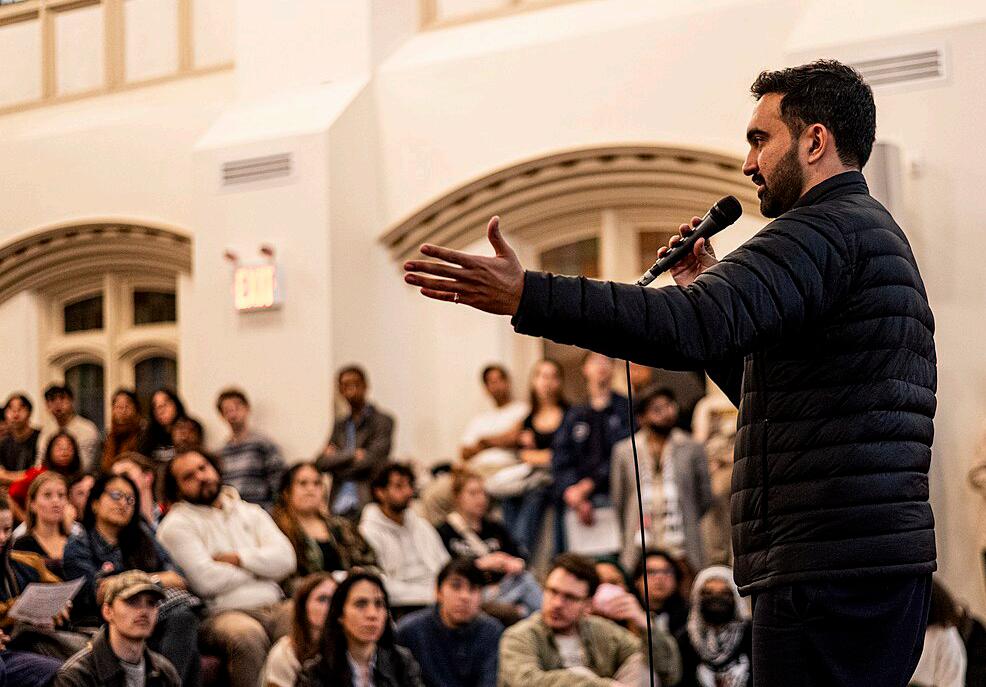
Campaigning online
Many Boomer and Gen Z candidates alike have largely abandoned the traditional playbook of spending millions on TV ads in favor of TikTok and social media, but it’s a pivot that older political hands would recognize from an older playbook: meeting voters where they are.
Foxx, a digital strategist, led influencer strategy for Kamala Harris’s 2020 presidential campaign bid.
On TikTok, she speaks to nearly 400,000 followers, saying she’d be the first woman of “our” generation elected to Congress.
In 2022, Florida voters elected the generation’s first congressmember — Democratic Rep. Maxwell Frost. The Congressional Progressive Caucus PAC, which Frost co-chairs, has endorsed Adelita Grijalva.
Foxx has leaned into popular Gen Z internet slang in branding her district tour “Crashout or Congress.”
“Does the news make you feel like you’re about to crash out? Be honest,” Foxx posted.
Foxx said her campaign turned a corner after a primary debate in late May, when some clips of her performance drew the eyes of millions and helped spark a fundraising boost.
If Scott seeks another term in his suburban Atlanta district, he’ll face several candidates in the Democratic primary next May, including microbi-
ologist and state Rep. Jasmine Clark, 42; state Sen. Emanuel Jones, 66; and 33-year-old Everton Blair, former chair of the state’s largest school district. Scott’s campaign did not respond to requests for an interview.
Clark racked up 7,000 TikTok followers after a popular influencer reposted her. She occasionally pops in with solutions to people’s problems on NextDoor and is sometimes recognized as a podcast host instead of a state representative. She said Republicans have done a better job at saturating social media with their messaging.
“Instead of looking at Republicans and wagging our fingers at them, we could take some lessons from them,” she said.
Message or messenger?
Voters have been crushed by high living costs, Clark said, but Republicans, not Democrats, have been the ones to tell people their pain is real — even though Democrats have better ideas for fixing things.
Blair agreed that Democrats have better policy prescriptions for addressing voters’ economic concerns, but he said too many longtime lawmakers have stifled the party’s ability to get that message across. He said Trump is fattening the wallets of billionaires but cheating low- and middle-income
pendent U.S. Sen. Bernie Sanders, has pushed back. She said she brings her own credentials to the table. Her father was progressive and anti-establishment, and she said she is, too.
But Foxx, who benefited personally from some government programs the Trump administration has slashed or is looking to slash, said Democrats need to do more to reach new voters.
“We are bringing people into this party, into this democracy, who have felt left out — by and large young people and working-class folks,” Foxx said.
A positive vision
In New York City, 33-year-old Zohran Mamdani recently won the mayor’s primary race with an upbeat campaign that leaned heavily on TikTok and emphasized finding new ways to make city life more affordable.
voters “out of the American dream.”
“We have an incumbent who is just not doing the job, and we need a better fighter,” Blair said. “The stakes are just too high.”
Young people have grown up in a political climate dominated by algorithms, said 21-year-old Akbar Ali, first vice chair of the Democratic Party in Gwinnett County, home to some of Scott’s district. That gives them a built-in understanding of how information spreads today, he said, but doesn’t replace on-the-ground outreach to voters of all ages.
Ali said Scott’s physical absence is palpable, both in the community and as a voice in Congress.
“A lot of people are upset on a national level because we can’t hit back with enough vigor,” he said.
Grijalva carries a household name in Tucson and is regarded as the front-runner. Former state lawmaker Daniel Hernandez, who is credited with helping save thenU.S. Rep. Gabrielle Giffords’s life after an attempted assassination more than a decade ago, is also in the mix of Democrats.
To Foxx, Grijalva benefits from her “legacy” last name.
Grijalva, who has received several endorsements, including from Democratic U.S. Rep. Alexandria Ocasio-Cortez and inde-
In an era where so many young people doubt they’ll ever be better off than their parents, they’re increasingly willing to ditch pragmatism for bold policy platforms, said David Hogg, who was removed from his leadership role with the Democratic National Committee, which said his election broke party rules. His decision not to run again followed his push to oust long-serving Democrats in safe congressional seats. He has not backed away from his vow to replace primary “asleep-at-the-wheel” Democrats with fresher faces.
People of all ages want a fighter who understands what’s at stake as Trump cuts Medicaid and other programs that millions of Americans rely on, Hogg said. That’s why his political action committee, Leaders We Deserve, endorsed Foxx.
Young voters were key to Democratic wins in recent years, but some swung to the right as Trump made gains in 2024. Hogg said he’s looking for candidates to “win them back” by talking about how change happens.
Older candidates can do that, too, he said, but for better or worse, young people aren’t yet “jaded” by politics.
“In this dark moment, we need people who can provide us a general sense of hope, as crazy as that can feel sometimes,” Hogg said. “To believe that maybe things won’t be as screwed up forever as they are now.”
NYC Democratic mayoral nominee Zohran Mamdani.
(Bingjiefu He photo via Wikimedia)
Overdose Deaths
Continued from page 6
substance use disorders.
“The Health Department’s job is to keep New Yorkers alive and connected to the dignified, evidence-based care and resources they need, and we will continue to prioritize these lifesaving resources no matter what.”
DOHMH currently funds 14 syringe service providers like VOCAL-NY at 21 sites, which assist roughly 22,000 people a year. The organizations offer access to safer drug use, the life-saving medication naloxone, and hepatitis C and HIV testing. The health department also directly operates Relay, an emergency response unit tasked with connecting clients to service providers.
Questions remain about how helpful the most recent city data can be toward overdose prevention efforts, due to the time passed. Toni Smith, Drug Policy Alliance director of New York State, said better and faster data continues to dominate the con-
versation during opioid settlement advisory board meetings. The need also applies to the city level.
“It’s not groundbreaking because the state has already announced that there have been declines across the state,” said Smith, “but this is helpful to begin to contextualize what that means for New York City. Also, these are provisional numbers, and so those are obviously still subject to changes as more data becomes available and is backfilled.
“Also, the provisional data does not give us a granular look into how the reductions are distributed across the city … One of the ongoing concerns has been that underneath the big headlines in the reduction of overdose death, we know that overdose deaths are not coming down equitably across the state,” Smith added.
While the downward trend from 2024’s third quarter is certainly good news, Smith said much remains left to chance for where the right resources are being deployed, due to a lack of real-time data for where the “crisis is most acute.”
This past May, the state reported a 32%
drop in reported overdose deaths in 2024 compared to 2023. The New York State Department of Health boasts more than 1,300 opioid registered programs spread throughout 5,000 sites statewide.
Black and Brown New Yorkers face some of the highest rates of overdose death, along with New Yorkers living in low-income neighborhoods and those between the ages 55 and 64, according to the DOHMH.
Centers for Disease Control and Prevention epidemiologic research shows a general overdose death decline in Bronx County since 2022, but sharp racial disparities persist. White, non-Hispanic residents faced higher overdose rates than Black residents in 2022, but that changed in 2023, despite a steady decline in Black overdoses as well. Still, such decreases are a promising sign.
“Perhaps deaths are beginning to come down among Black and Latino people in New York City,” said Smith. “If that’s the case, that is what we are looking for to see as a trend. However, as we brace for federal funding cuts and as the city is ramping up criminalization, we know that the first people who are going to be hurt and hurt
the most are Black New Yorkers.”
Overdose deaths increased during the COVID-19 pandemic and peaked during 2022’s fourth quarter, when 859 people died. Hotspots throughout the Bronx and in parts of Upper Manhattan, Central Brooklyn, and Staten Island face the highest rates per resident.
To be clear, opioid overdose deaths are largely preventable and opioid overdoses can be reversed by naloxone, the generic brand name for Narcan. The DOHMH said more than naloxone kits and 56,000 fentanyl test strips were distributed last year.
“For too long, opioid overdoses have ripped families and communities apart, but there is light on the horizon with opioid overdose deaths citywide seeing their lowest numbers in five years,” said Adams. “We are committed to maintaining this downward trend by continuing to invest in the programs and treatments that support those who are struggling. With smart investments, including those awarded through opioid settlement funds, we are making our city safer, healthier, and the best place to raise a family.”
Continued from page 6
Congressmember Espaillat is the first Dominican American and the first formerly undocumented immigrant to be elected to serve in the U.S. Congress. Espaillat said that he and Mamdani bonded over their similar background. He added that it’s important to honor who the people have chosen as their nominee.
“This is a city that is at a tipping point, at a precipice, unlike ever before,” said Espaillat at a gathering at the grand United Palace Theater in Washington Heights he held to celebrate his endorsement of Mamdani on July 10. He was joined by members of the Northern Manhattan Dems for Change; Councilmembers Shaun Abreu and Carmen De La Rosa, and Councilmember-elect Elsie Encarnacion. “And so we need someone that will represent those tenants, those small business people, those families that are up against the wall.”
“Now we have had a robust primary. We had a tough primary,” Espaillat added. “The Democratic Party is a big tent party with different opinions, with different people
from all over the world, with different subgroups that bring a lot of ideas to the table. That’s what makes us a strong party. The diversity of our membership. And I would be damned if I see the party go down. We gonna make sure we unite. A united Democratic Party cannot be defeated.”
Unity is key
Espaillat said that it is imperative that the Dem party stay united in the face of President Donald Trump’s “fundamentally un-American” mass deportation agenda regardless of differences.
Mamdani also spent the past weekend campaigning in the Bronx. He was endorsed by Councilmember Pierina Sanchez on July 10. Sanchez emphasized the urgent need for a shift in city leadership that centers the needs of working-class, immigrant, and low-income communities.
“Zohran’s campaign isn’t just inspiring — it’s bold, urgent, and rooted in the realities of neighborhoods like mine, where families are fighting to stay housed, fed, and hopeful,” said Sanchez in a statement. “Our city’s most vulnerable — Black, Brown, immigrant, and low-income New Yorkers — deserve more than survival.”
For voters like the Party for Socialism and
Liberation (PSL), the shift towards accepting a socialist is unsurprising.
“When we do outreach, people do talk about socialism without using that specific term. If you ask people, ‘how would you fix this?’ They would say like free buses or neighborhood watch. When they have solutions, people speak about them taking the power or coming up with a plan,” said Rosanna Garcia of PSL, who is based in the South Bronx.
Garcia pointed out that social programs, like free school lunches, already exist in the U.S. but leftist ideologies associated with the Soviet Union and communism have been “demonized” from 1917 to the 1950s. “The Red Scare, I mean, ever since World War II, like, the U.S., unfortunately, has been attacking communism, socialism and just any socialist project out there has been shut down,” said Garcia. “They don’t want to see examples of what socialism can do for other people, so this is why there’s this pushback from the elite class right now with Mandani sharing this message.”
Former NYC Mayor Fiorello La Guardia, ran on socialist ideals despite being Republican, and physically transformed the city’s landscape with public housing programs and transportation infrastructure.
The city’s first Black mayor, the late David Dinkins also belonged to a socialist club, the now controversial Democratic Socialists of America (DSA).
Garcia said that the current issue of unaffordability in housing, rise of homelessness, and authoritarianism from Trump and federal agencies dictates a need for change. “At this point, it’s a requirement. It’s a must,” she said.
Mamdani’s currently facing Independent candidates Eric Adams, the incumbent and city’s second Black mayor, Andrew Cuomo, the former governor, and the Republican candidate Curtis Sliwa.
A recent poll from HarrisX, and even a conservative survey like American Pulse, still show Mamdani leading the fiercely competitive race. In a “four-way race,” Mamdani is just ahead of the pack with 26% of the vote, Cuomo 23%, and Sliwa 22%.
Adams is trailing at 13% and 15 percent of voters are undecided, said HarrisX.
“These numbers show a volatile race still taking shape,” said Dritan Nesho, CEO of HarrisX. “While the progressive base is fueling Mamdani’s rise, Cuomo’s broad name recognition and moderate appeal make him a formidable general election challenger.”
baseline protections to deliveristas on smaller platforms and grocery-based apps.
“These bills represent more than policy — they are a step toward justice for communities who have too often been invisible in the workforce,” said Adama Bah, Afrikana chief executive director and founder in a state-
ment. “We believe every worker, especially Black migrants and immigrants in the delivery sector, should be protected, respected and paid fairly.”
DoorDash’s senior manager of government relations Kassandra Perez-Desir commended the bill to extend protections to app-based grocery delivery workers.
“INT 1135 reflects a pragmatic step toward treating all delivery workers consistently, regardless of what they deliver,” said Perez-Desir over email statement. “DoorDash
supports fairness and parity for all delivery workers — whether they’re delivering a hot meal or a bag of groceries. As always, we look forward to working with city leaders on smart, balanced policies that uplift workers, support small businesses, and strengthen New York’s local economy.”
But the fight continues. Cortes points to worker deactivations as the next major battle for deliveristas. He says many fear speaking out against unfair practices with no protections against their apps kicking them off. Ad-
ditionally, the platforms offer varying appeal channels, with some lacking any real process. Meanwhile, deliveristas usually invest substantial overhead in bikes and delivery gear. “We want to have these protections because the companies are sending [them] to do unrealistic deliveries,” said Cortes. “The workers are going to cross red, going in the opposite direction [and] going on the sidewalk because they’re afraid of losing their jobs. It’s not because they feel like superheroes.”
Knicks and Nets clash at the NBA Summer League on varying timelines
By JAIME C. HARRIS AmNews Sports Editor
Statistics can be misleading and lead to faulty measures when assessing players at the NBA Summer League being held in Las Vegas. Each team’s objective varies; each team’s development plan is designed for their specific needs and vision of constructing a championship roster, so a player’s 3-point shooting percentage or efficiency rating for guarding ball screens isn’t definitively revelatory.
The Knicks’ squad lacks a player who has distinguished himself as a surefire mainstay of new Head Coach Mike Brown’s rotation next season. However, there’s still hope that second-year point guard Tyler Kolek; 24-year-old small forward MarJon Beauchamp (the 24th overall pick in the first round by the Milwaukee Bucks in 2022); or Kevin McCullar Jr., a 24-year-old shooting guard who had a stellar college career at Texas Tech and then Kansas before being selected by the Phoenix Suns in the second round (No. 56 overall) and traded to the Knicks on draft night, can emerge as reliable bench depth — a weakness for the team last season.
It’s still debatable but moot as to whether there was a talent deficit among the reserves, or if former Knicks Head cCoach Tom Thi-
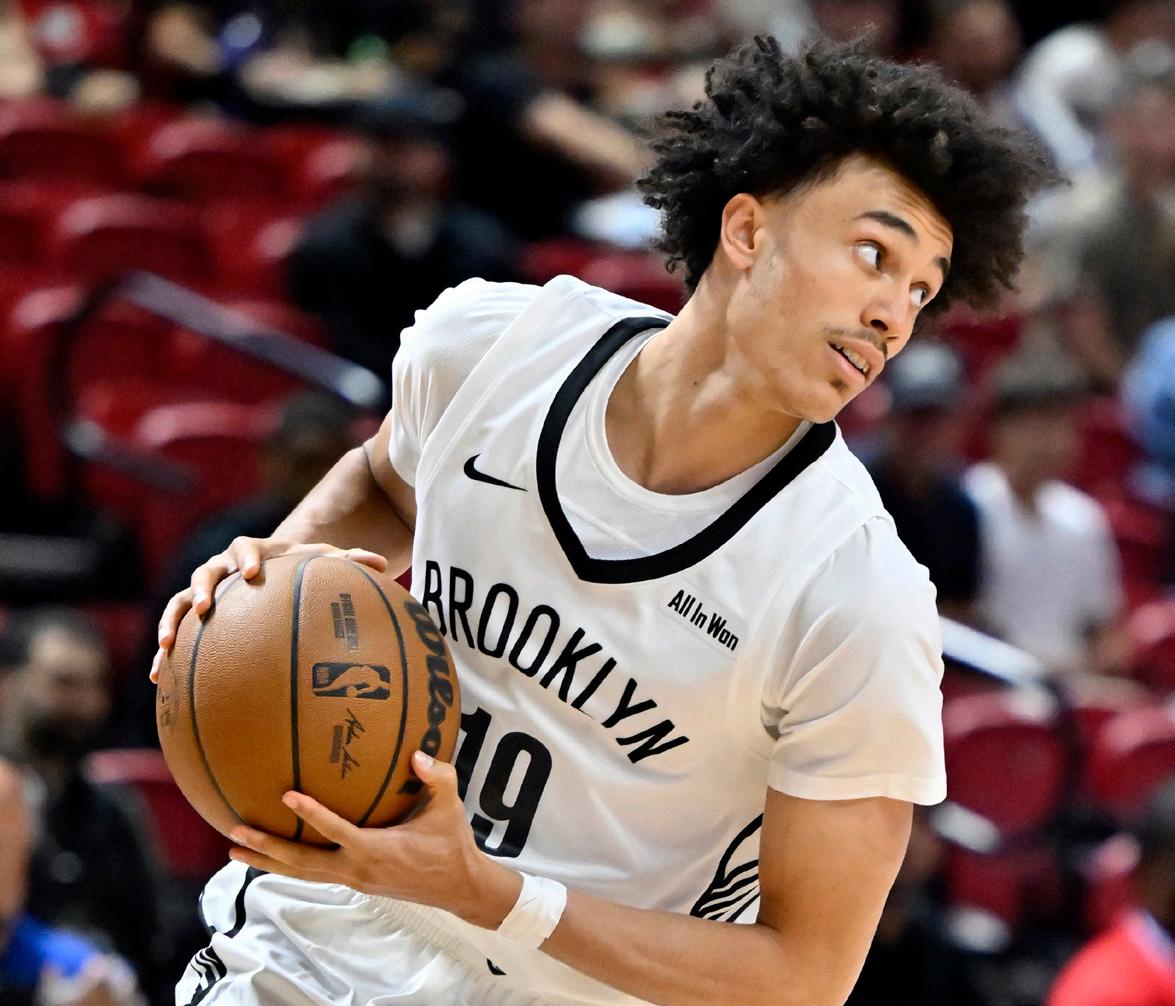
boeau seemingly self-destructively lacked trust in players who could have been effective contributors. It became a source of contention — albeit briefly — between him and starting small forward Mikal Bridges in the second week of March during a West Coast road trip when Bridges, who was averaging nearly 38 minutes per game, suggested to Thibodeau that he use the bench more.
“Sometimes it’s not fun on the body,” said Bridges at the time. “You’ll want that as a coach, but [I] also talked to him a little bit,
knowing that we’ve got a good enough team where our bench guys can come in and we don’t need to play 48 (minutes), 47.”
As Bridges elaborated, “We’ve got a lot of good guys on this team [who] can take away minutes, which helps the defense, helps the offense, helps tired bodies being out there and giving up all these points. It helps just keeping fresh bodies out there.”
Even with signings of free agents Jordan Clarkson, a shooting guard, and Guerschon Yabusele, a power forward, the Knicks, with
The Liberty try to remain stable and course correct reaching the All-Star Game break
By JAIME C. HARRIS
AmNews Sports Editor
The New York Liberty’s 79-72 win over the Atlanta Dream at the Barclays Center in Brooklyn on Sunday was emblematic of the uneven stretch they are in the throes of heading into All-Star Weekend, which will take place in Indianapolis, Indiana, home of the Fever.
The Liberty trailed the Dream by 19 points (34-15) with 6:38 in the second quarter after a basket by Atlanta’s future Basketball Hall of Fame inductee Brittney Griner before trimming their deficit to 42-31 at halftime. New York continued to rally over the next two periods led by forward Leonie Fiebich’s game-high 21 points to earn a hard fought win.
Stacking victories has been a challenge for the defending WNBA
champions since they began the season 9-0. From June 10 prior to facing the Indiana Fever last night at the Barclays — the Liberty’s fourth game of eight straight at home — they were 5-6 and fell from the top spot in the league’s standings. Their 14-6 record tied them for second in the loss column with the Phoenix Mercury, which were 15-6 when last night’s WNBA schedule tipped-off.
The Minnesota Lynx, which the Liberty defeated in last year’s finals, are atop of the 13-team league and were 19-4 before facing the Mercury yesterday afternoon. The Liberty’s slide has coincided with the absence of starting forward Jonquel Jones, last season’s finals MVP. Jones has not played since suffering a right ankle sprain on June 19 early in the second quarter versus the Mercury. The Liberty lost the

justifiable championship aspirations, need more reinforcements.
Conversely, the Brooklyn Nets, whose summer league squad was 0-3 after a 97-93 loss to the Knicks on Tuesday night, is on a vastly different timeline than their fellow New York City franchise. They are taking an approach similar to the newly crowned NBA champion Oklahoma City Thunder: to accumulate numerous draft picks, and maximize and leverage their value. They used three of them last month in the NBA Draft to take guard
The Nets, who won just 26 games this past season under Jordi Fernandez in his first year as a head coach, are being prudently patient in understanding that the Thunder went from 24-58 in the 2021–2022 season to a league title three years later.
The Knicks’ opportunity is now. The Nets’ chance will come later, but perhaps not much later. Yet the summer league is not an indicator. It’s simply a glimpse.
game 89-81, falling to 10-2.
While the star has been sidelined for the Liberty’s last nine games, the team is optimistic she will return next Tuesday when they take on the Fever again at the Barclays. The 31-year-old native of Freeport, Bahamas, Jones is the 2021 league MVP, five-time All-Star, and five-time All-WNBA selection. Jones began five-onfive activity this past weekend. She is third on the Liberty in scoring at 12.1. Breanna Stewart was averaging 19.5 and Sabrina Ionescu 18.8 heading into last night. Jones’ 9.6 rebounds per game leads the Liberty.
“We’ve missed her and now it’s about ramping her up,” said Liberty head coach Sandy Brondello on Tuesday. “She hasn’t played in quite some time but just her impact will give confidence to everybody.”

Egor Demin (No. 8), guard Nolan Traore (No. 19), and 7-0 forward/ center Danny Wolf (No. 27).
Brooklyn Nets rookie first round picks (L) Nolan Traore and (R) Danny Wolf are core players in team’s design to build with youth. (AP/David Becker photos)
New York Liberty forward Breanna Stewart (30) battles the Indiana Fever’s All-Star Aliyah Boston in a late May matchup as the teams faced off again last night in Brooklyn. (AP/Michael Conroy photo)
Cosmos are revived as soccer brand aims to begin play in 2026

By TYRESE ALLEYNE DAVIS Special to the AmNews
The New York Cosmos are back. After decades of dormancy, brief revivals, and a legend that lived mostly in memory, the iconic club is officially returning to competitive play in 2026 — this time, as a member of USL League One. However, in a defining twist, the Cosmos will now call New Jersey home, planting their flag in a state that has long pulsed with soccer passion.
Founded in 1970, the Cosmos became the face of American soccer during the golden era of the North American Soccer League (NASL). With the backing of major media and an unmatched drive for spectacle, the club shocked the world by signing global icons Pelé, Giorgio Chinaglia, Franz Beckenbauer, and Carlos Alberto. They turned Giants Stadium into a soccer temple, drawing crowds in the tens of thousands and capturing imaginations across the country.
Their rise — and eventual fall — was so dramatic that it became the subject of the 2006 documentary “Once in a Lifetime: The Extraordinary Story of the New York Cosmos.” The film captured the glitz, ego, ambition, and ultimate collapse of a team that once symbolized soccer’s promise in America. When the NASL crumbled in the mid1980s, the Cosmos faded with it.
Failed indoor ventures and independent matches followed, and by 1985, the lights were off.
Still, the Cosmos name never truly disappeared. Revivals in the late 1990s and early 2000s kept the spirit alive, even though none stuck. Now, for the first time in decades, the club has a clear path forward — and a new home.
The return of the Cosmos is being led by a New Jersey-based ownership group that acquired the club’s intellectual property and majority control from former owner Rocco Commisso. Their vision is rooted not in nostalgia, but in opportunity — tapping
into New Jersey’s thriving youth systems, community clubs, and deep soccer culture to fuel a sustainable, modern revival.
Joining USL League One — the rapidly growing third division of American soccer — gives the Cosmos room to build deliberately and authentically. Relocating across the Hudson doesn’t weaken their brand; it revitalizes it. The Garden State is one of the most vibrant soccer regions in the country, and it’s poised to give the Cosmos the competitive environment they need to thrive again. This relaunch is more than symbolic. It’s a chance to bring back a club built on flair, ambition, and global relevance, while creating something lasting for a new generation. For longtime fans, it’s a long-awaited return. For newcomers, it’s an introduction to a name that once helped shape the game in America.
The Cosmos aren’t just stepping back onto the field — they’re stepping back into their story. And this time, it’s one they intend to finish.
Brooklyn’s Edgar Berlanga and Amanda Serrano have tough losses in NYC
By DERREL JOHNSON Special to the AmNews
Two high-profile fights took place last weekend in New York City at separate locations, with two popular hometown boxers taking losses.
On Friday night at Madison Square Garden, history was made because each bout featured women in a major boxing event for the first time. Amanda Serrano, who was born in Carolina, Puerto Rico, and reared in the Bushwick section of Brooklyn, lost to Katie Taylor for the third time, falling to 47-4-1, 31 KOs, by a 10-round majority decision. Taylor (25-1, 6 KOs) retained her super-lightweight title with a score of 97-93, 95-95, 97-93 in front of a sold-out crowd of 19,721.
“I thought I showed a very smart performance, a very clever performance,” said the 39-year-old Taylor.
“This performance I knew I was capable of against Amanda. The two fights previously ended up as complete wars, and I came out of the ring battered and bruised, and I’m thinking, what? Why am I just standing there fighting with our newest cable and moving my legs like that?”
Taylor asked rhetorically. “I’m just out-boxing her and I’m just happy I was able to produce that tonight and execute the game plan that (trainer)

Ross (Enamait) has been telling me to do all along. So yeah, I’m very very satisfied right now.”
For Serrano, 36, it was a disappointing ending to the trilogy since both boxers have said they won’t meet again. “We tried something different,” she explained. “It was all about working smarter, not
harder. I tried to keep my distance and tried not to go in there and fight with her …” Saturday evening, just 10 miles away from MSG, Louis Armstrong Stadium in Flushing-Corona, Queens, the annual site of the U.S. Open tennis tournament, hosted its inaugural fight card. The United
Kingdom’s Hamzah Sheeraz (210-1, 17 KOs) moved up to supermiddleweight and dominated Brooklyn’s Edgar Berlanga (23-2, 18 KOs), dropping the 28-year-old Puerto Rican pugilist three times, with the fight being stopped in the fifth round by referee David Fields.
“I told (my trainer Andy Lee) I
can hunt this guy down and he believed me, (and) not many coaches do that, so Andy, thank you very much,” Sheeraz, 26, said of changing his strategy against his opponent after the second round. Although it was a bad weekend for Brooklynites, it was an excellent night for fighters from New Jersey. Paterson, New Jersey’s Shadasia Green (16-1, 11 KOs) earned a tough split decision win (93-96, 95-94, 96-93) over Savannah Marshall at the Garden (13-2, 10 KOs) in a 10-round fight, becoming the unified super-middleweight champion and taking home the $250,000 bonus for performance of the night.
“I would love to fight (undisputed heavyweight champion) Clarissa Shields and when the time comes and it’s big, let’s do it,” Green said.
On Saturday at Louis Armstrong, Newark’s Shakur Stevenson (24-0, 11 KOs) retained his WBC lightweight championship by handing William Zepeda (33-1, 27 KOs) the first loss of his career with a dominant 118110, 119-109, 118-110 victory.
Stevenson said he wants to fight WBA lightweight champion Gervonta Davis, and a clash between the two undefeated boxers is one many fans want to see.
The late, great soccer legend Pelé in action for New York Cosmos during his retirement match against Japan’s Furukawa Electric in September 1977 at National Stadium in Tokyo. (KYDPL KYODO photo)
Katie Tayor (right) and Amanda Serrano exchange punches in their super lightweight bout at Madison Square Garden on Friday night. (Esther Lin/Most Valuable Promotions photo)
SPORTS
Some of the world’s best in beach volleyball will compete at Central Park
By LOIS ELFMAN
Special to the AmNews
This weekend, some of the top beach volleyball players in the world will compete at Wollman Rink, thanks to its transformation with 300 tons of sand trucked into Central Park. On July 19 and 20, teams will take part in the sixth event of the 2025 Association of Volleyball Professionals (AVP) league season.
Among the participants will be Canadian beach volleyball player
Brandie Wilkerson, currently the only Black woman competing on the AVP tour. Last year, she and teammate Melissa Humana-Paredes won the silver medal at the Olympic Games in Paris, the firstever medal for a Canadian women’s beach volleyball team and the highest-ever medal won by a Canadian team (John Child and Mark Heese won bronze in 1996). Their epic journey to the final left a lasting impact on Wilkerson as an athlete and a person.
“There were so many things that made that Olympic experience amazing,” said Wilkerson, who also competed in Tokyo in 2021.


“Obviously, what every athlete enjoys, which is being able to share an Olympic moment with friends, families, and fans in a city that was catering to the athletes’ needs to make us feel very special. After all of the hard work, dedication, and sacrifices, this is such a beautiful way to celebrate that.”
Wilkerson and Humana-Paredes,
who play for the Palm Beach Passion, are looking forward to experiencing their sport in Central Park. With the Olympic beach volleyball being held near the Eiffel Tower, the sport can increasingly be found in innovative locations.
“It will be extremely magical; Central Park is iconic,” said Wilkerson, who has her sights set on the 2028 Olympics in Los Angeles. “I’ve always loved New York City. Growing up in Toronto, it’s a very familiar kind of energy … It seems beach volleyball is trending toward being in these iconic venues because of how special this sport is. Having beach volleyball in more diverse places opens up [its exposure].”
Wilkerson wants to see more people play beach volleyball, and if her presence can help bring greater diversity, she will feel fulfilled. “We want to see the sport grow,” she said. “We want to see diversity in the cities, in the people who play, in the fans. It’s a privilege and a responsibility to represent my culture and to have athletes relate to me and see themselves. You want to see everyone have a chance at this sport because it really is special.”
HBCU’s Mid-Eastern Athletic Conference holds its third flag football clinic

By LOIS ELFMAN Special to the AmNews
On Sunday, July 20, the Mid-Eastern Athletic Conference (MEAC), a Division I conference of Historically Black Colleges and Universities, will host MEAC Girls on the Gridiron Football Clinic for the third consecutive year. After two years at Norfolk State University in Virginia, this year’s event will be held on the campus of Morgan State University in Baltimore, Maryland. Earlier this year, the NCAA Com-
mittee on Women’s Athletics officially recommended that the sport of flag football join the NCAA
Emerging Sports for Women program. Should that happen, the girls and young women (ages 12 and older) attending the clinic may find collegiate sports opportunities in their future.
“One of the things for my vision is providing more opportunities for our student-athletes and getting girls interested in football who are probably already playing football in their neighborhoods,”

said MEAC Commissioner Sonja Stills. “Being able to get it in an organized sport further amplifies the opportunities.”
If flag football officially becomes an emerging sport, 40 colleges and universities must then sponsor the sport at the varsity level for it to be considered for championship status. Stills said a couple of schools in the MEAC already have flag football as a club sport, so transitioning to a varsity sport should be relatively easy.
“As we look further down in our
strategic long-range plan, I believe flag football will be one of the sports that eventually we’ll add,” Stills said. “Women are already interested in it, so it would be a great addition to the conference.”
Football coaches from across the MEAC, along with two football student-athletes from each institution, will take part in Girls on the Gridiron. They will lead skills sessions, drills and coaching for participants. Moving the event to Baltimore allows the conference to introduce flag football
to another sports-loving community and make a positive impact. Stills hopes at least 200 girls and women will participate. At the end of the event, the coaches and student-athletes will select an MVP.
“I get a kick out of watching their skills,” said Stills. “They are so talented. That really excites me. The NFL brought it together to have women’s flag football at the 2028 Olympics, and I want to have HBCU representation on those teams. That was my goal when we started Girls on the Gridiron.”
Volleyball standout Brandie Wilkerson (pink suit), member of Palm Beach Passion, going up against Lexy Denaburg, is only Black woman playing on AVP Tour. (AVP/Bryan Malloch photos)
The 2024 participants of the MEAC flag football clinic gather for a group photo.
Attendees learn and practice the fundamentals of the sports during drills and competition. (Mid-Eastern Athletic Conference photos)
Sports
WNBA players express frustration over collective bargaining agreement negotiations
By LOIS ELFMAN
Special to the AmNews
Since I began my article about the WNBA’s recently announced expansion teams with a reflection on league history, I’m going to toss out another blast from the past. I remember when the WNBA Draft was postponed and then abruptly scheduled at the 11th hour when an agreement was finally reached on a collective bargaining agreement (CBA). The year was 2003 and given less than 24 hours notice, only six players were flown in to attend the draft.
One of two members of the media in attendance, I share this memory to say, I think we may be facing that again in 2026 despite this being a very different WNBA landscape. The top pick of that
2003 WNBA Draft, LaToya Thomas, was chosen by the Cleveland Rockers, a team that folded at the end of that season. Today, we see a WNBA with robust attendance, dynamic sponsor agreements, charter flights, and a very lucrative TV deal. So, what’s the problem?
According to reports, the league and the Women’s National Basketball Players Association (WNBPA) remain far apart on the terms of a new CBA. Players want better pay, a greater share of the league’s revenue, improved health benefits, greater flexibility in scheduling, and other things related to their work experience.
Signed in 2020, the current CBA could remain in effect until 2027, but the WNBPA exercised the right to opt out at the close of the 2025 season. When a veteran player sees a packed
arena full of cheering fans while earning a base salary of less than $80,000 a season, she has reason to feel frustrated. Even a player earning the maximum of $249,244 rightfully believes she deserves more.
Players, including Breanna Stewart (WNBPA vice president) of the New York Liberty, expressed frustration with the WNBA’s offer. Despite success, the league is still navigating financial realities, including huge investments made over decades when red ink was flowing. But it’s hard for players to accept that argument when figures like the average valuation of a WNBA team — $269 million — are being discussed. That’s a tough pill to swallow for players simply asking for rosters to be expanded by a few spots.
Perhaps the most intriguing element is how the overall wom-
en’s professional game is growing. Stewart and Napheesa Collier (also a WNBPA vice president) of the Minnesota Lynx co-founded Unrivaled, an innovative 3x3 league that debuted this past winter. Their commitment to their new league caused one fan to publicly speculate that they had a conflict of interest when negotiating with the WNBA. With a dollop of sarcasm, Collier assured the fan that wasn’t the case.
Professional athletes competing before sold out crowds should be able to earn a wage reflective of the product they’re delivering. While everyone needs to respect the league’s longevity despite daunting challenges, the WNBA needs to reset its mindset to current circumstances. Meetings are scheduled during this weekend’s All-Star Game festivities.
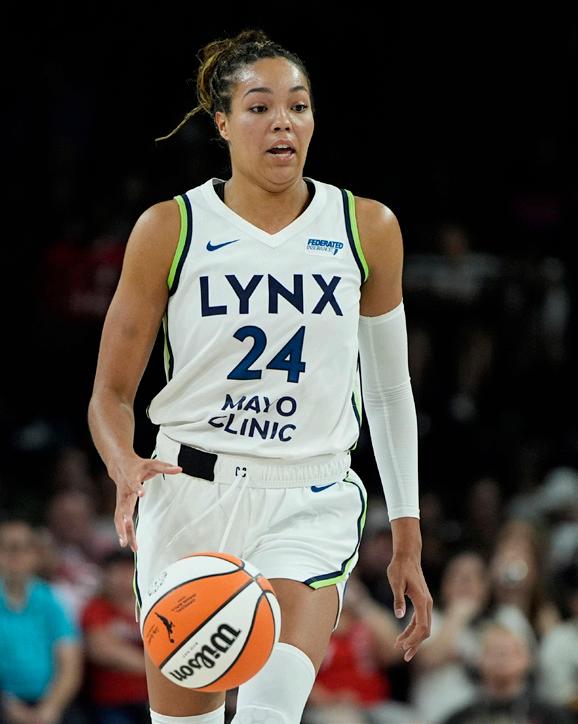
HBCU Swingman Classic provides showcase for Black MLB hopefuls

By QUINTON COCHRAN, MLBbro
Special to the AmNews
ATLANTA — Rain couldn’t stop Major League Baseball’s historically Black party on Friday night. Not even a 39-minute weather delay could wash away the spirit of celebration at the 2025 HBCU Swingman Classic, held at Truist Park, home field of the Atlan-
ta Braves. The sky may have been overcast for the annual Black college all-star game, but the talent shone through.
From the moment fans began to arrive, it was clear this was more than just a baseball game — it was a family reunion, a block party, and a showcase of rising talent. Historically Black College and University (HBCU) pride was on
full display. Alumni rocked gear from Jackson State, Morehouse, North Carolina A&T, and many more MEAC and SWAC schools. Divine 9 members strolled in synchronized steps on top of the dugouts. Families laughed, posed for pictures, and danced in the aisles, soundtracked by the Georgia Mass Band, whose mix of high school and HBCU musicians slid
to the left and right while playing “Flex” and other classics. The smell of popcorn and hot dogs filled the air as the crowd moved through the concourse, looking for cover and refreshments.
Before the delay, the National League got on the board first with a solo home run by Kameron Douglas, a Georgia native who attends Alabama State. He launched it to dead center in the bottom of the second inning. Not long after, North Carolina A&T freshman JT Taylor stepped up for the American League and smashed a two-run double that just missed going over the wall. It was loud, and you could feel the momentum shift.
Then the rain came … but, somehow, it didn’t kill the vibe.
One of the night’s most memorable moments came from the game’s MVP, Florida A&M’s Jay Campbell. With two outs and two strikes in the seventh inning, the freshman launched a 400-foot line drive over the left field wall, tying the game and igniting the crowd.
“It felt good to represent my school,” Campbell said after the game.
“It was a great experience — a lot of people, a
great crowd. Playing at Truist and getting to meet someone like Ken Griffey Jr… . that’s something I won’t forget.”
Griffey, who founded the HBCU Swingman Classic, was seen earlier in the night taking photos in the dugout, speaking with players, and embracing his role as mentor.
In the eighth inning, the National League pulled ahead for good, adding some insurance runs with two outs. By the ninth, the crowd was swaying in unison to “Swag Surf,” every arm moving to the rhythm, nobody off-beat. The National League secured a 7–4 win, but the celebration was far from over.
As fireworks lit up Truist Park, players and families stood shoulder to shoulder, looking up and soaking it in. Outside the stadium, the Battery Atlanta, a complex of restaurants and entertainment venues surrounding the stadium, stayed alive with music and dancing long after the final out.

(MLBbro.com photo)
Minnesota Lynx star Naphessa Collier (pictured last season), the leading candidate for this season’s WNBA MVP award, is also the players’ association vice president.
(AP Photo/ John Locher)
